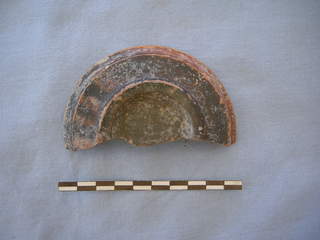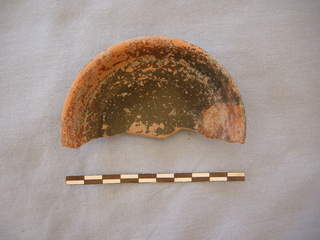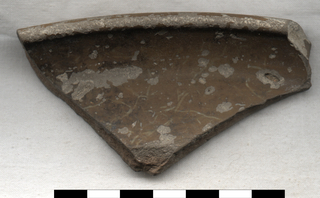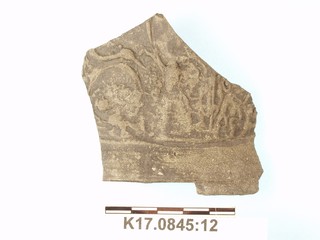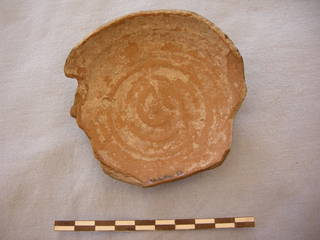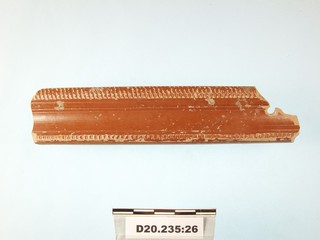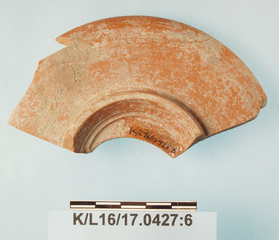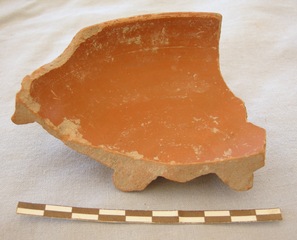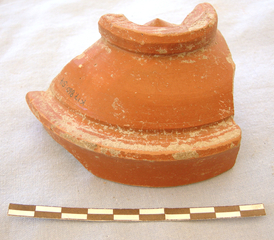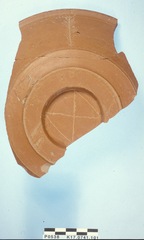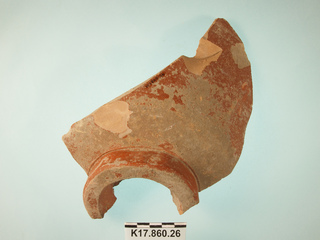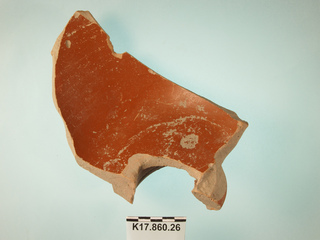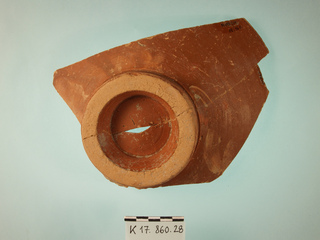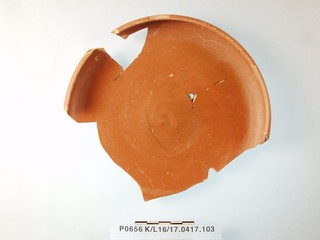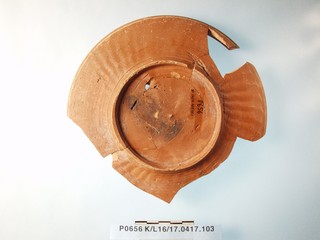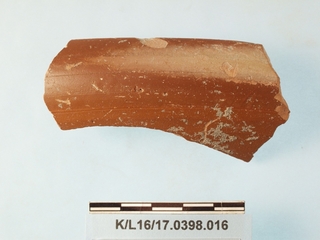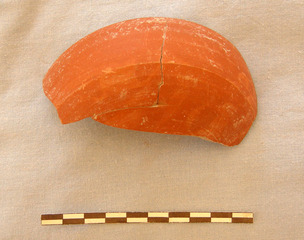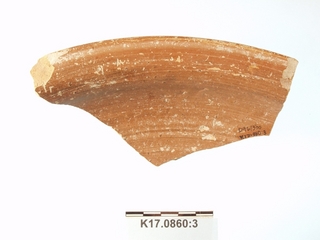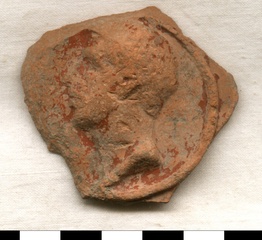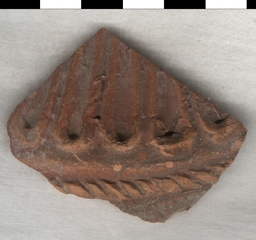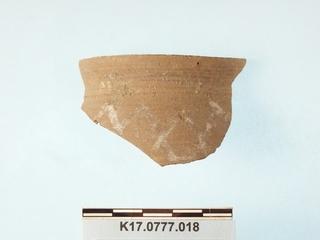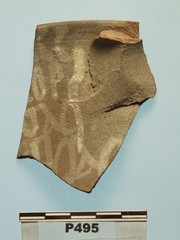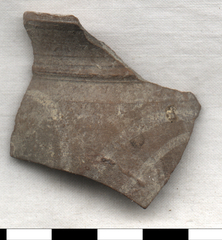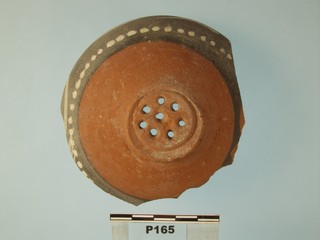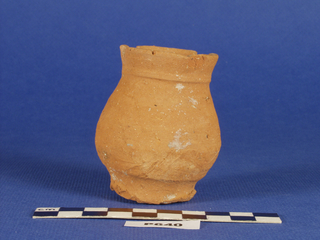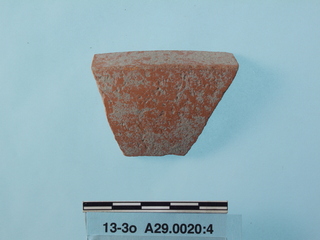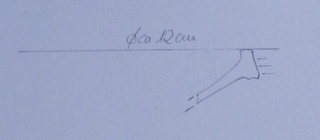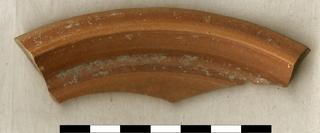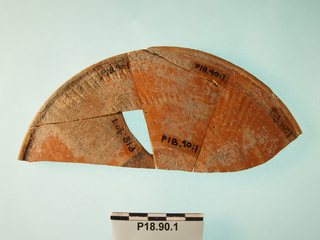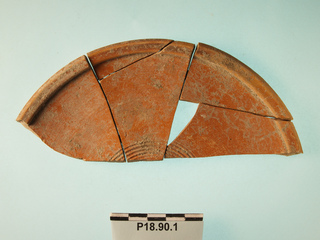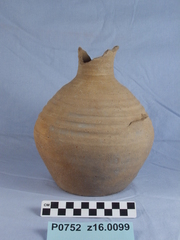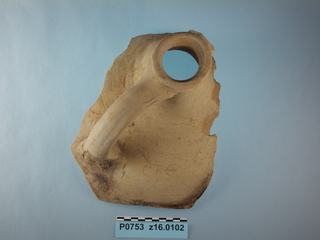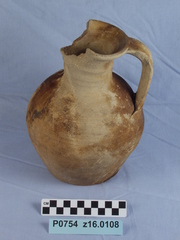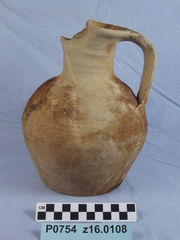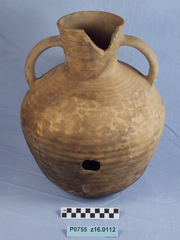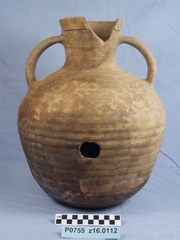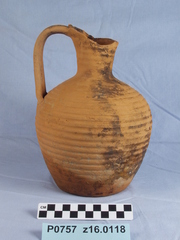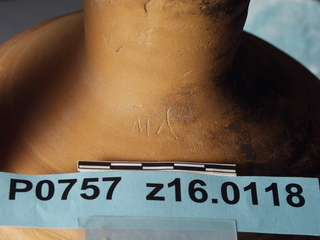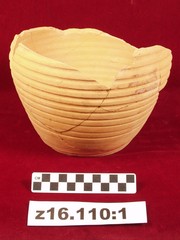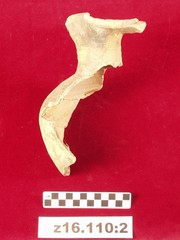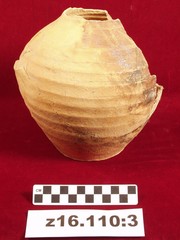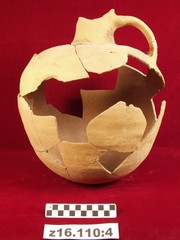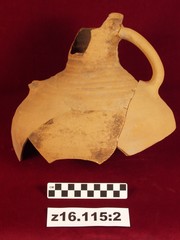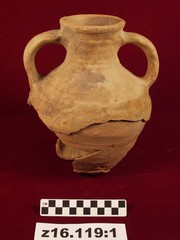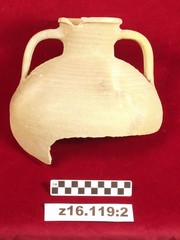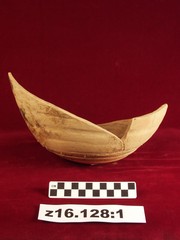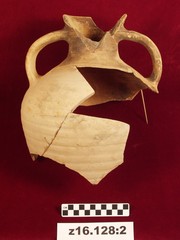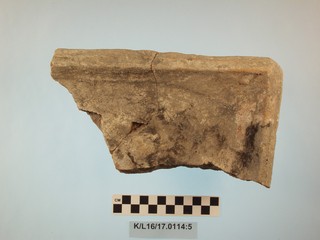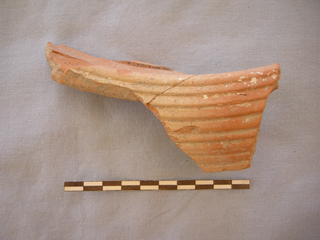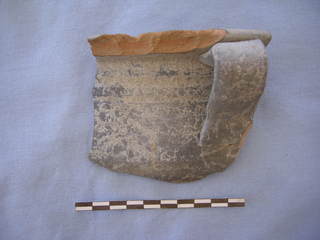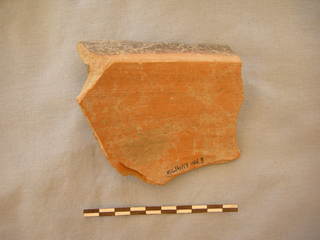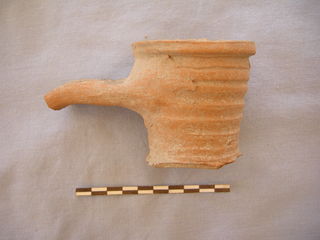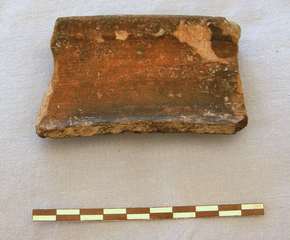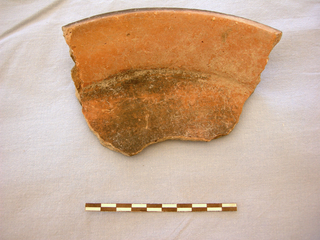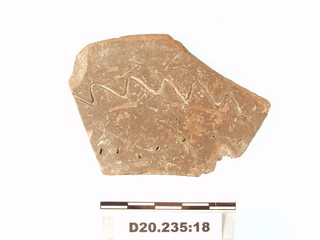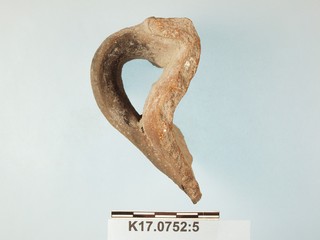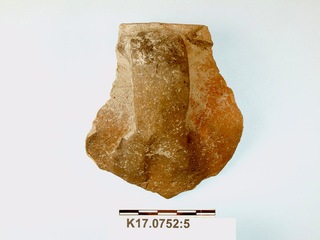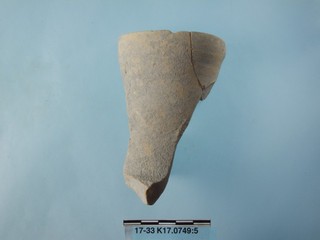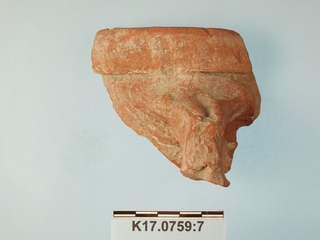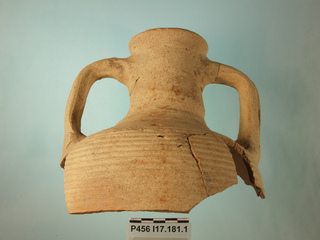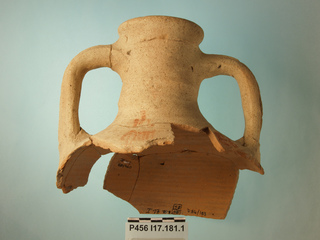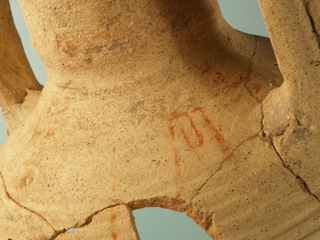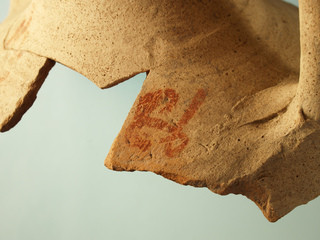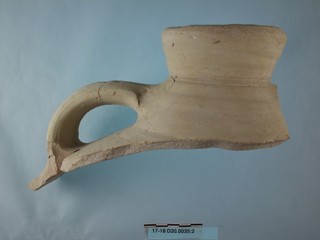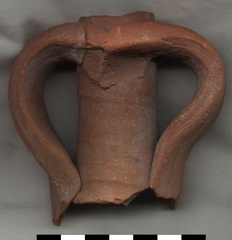Greek, Roman and Byzantine Pottery at Ilion (Troia):
Sebastian Heath and Billur Tekkök, Editors
Lower City Catalog
Please note that this is a public draft of work in progress
1. Basin with inturned ledge rim. Local.
D20.0268:5. PH. 1.0; est. D.rim 33; Th. 0.5. Preserving 1/20 of rim. Deep turning marks exterior on wall. Orange brown micaceous fabric (5 YR 6/4), added white dots on rim.
West Sanctuary (Tekkok); Garden Dump (Berlin 1999, 134, n.225, pl.8, H2 Occupation).
2. Basin with ledge rim. Local.
D20.0164:2. PH. 3.0; est. D.rim 26; Th. 0.4. Preserving 1/6 of rim. Gray coarse fabric, fired gray.
West Sanctuary (Tekkok); Berlin 1999, n. 142, pls. 9,23 (H2 Occupation.).
svg/D20.0164-2.jpg
3. Cooking pot. Regional.
D20.0294:1. PH. 13.7; est. D.rim 12; Th.0.5. Preserving ¼ of rim with handle and wall. Slightly everted rim. Gritty micaceous pinkish buff fabric (2.5YR6/6) partial blackening exterior.
LH/ER (Rotroff Group E Agora)
4. Bowl, modled foot (Hellenistic)
K/L16/17.0169:19. Single base sherd.
svg/K-L16-17.0169-19.jpg
5. Banded rim cup (Hellenistic)
K/L16/17.0169:20. Single rim sherd.
svg/K-L16-17.0169-20.jpg
6. Unguentarium (Hellenistic)
K/L16/17.0169:21. Single sherd, broken toe and lower body.
svg/K-L16-17.0169-21.jpg
7. Net-pattern bowl (Hellenistic)
K/L16/17.0169:22. Single rim sherd.
svg/K-L16-17.0169-22.jpg
8. Bowl with West Slope style, Pergamene (ca.200-160 BC)
P. H. .024. Th. .005.
K/L16/17.0452:4. Pink fabric (2.5YR 7/6) matt black glaze. Ray decoration.
De Luca-Radt 1999, n.426b, pl.12; Schafer 1968, 47, D11, pl.11; de Luca 1968, n.278,279, pl.52,7.
svg/K-L16-17.0452-4.jpg
9. Bowl with net pattern decoration Pergamene (ca.200-160 BC)
P. H. .037. Est. diam. rim .16. Th. .005.
K/L16/17.0452:2. Slip scraped around the rim. Pink fabric (2.5YR 7/6) matt black glaze in and out.
De Luca-Radt 1999, n.433, fig.4, pl.13.
svg/K-L16-17.0452-2.jpg
10. Bowl with net pattern decoration Pergamene (ca.200-160 BC)
P. H. .037. Est. diam. base .015. Th. .005.
K/L16/17.0452:5. Base. Pink fabric (2.5YR 7/6) matt black glaze in and out.
De Luca-Radt 1999, n.436, pl.13.
svg/K-L16-17.0452-5.jpg
11. Base with molded ovolo decoration thymiatherion? (2nd Century BC)
P. H. .037. Th. .009.
K/L16/17.0452:3. Gray micaceous fabric (2.5YR N5) with self slip.
svg/K-L16-17.0452-3.jpg
12. Lagynos neck (3rd/2nd Century BC)
P. H. .079. Th. .009.
K/L16/17.0452:1. Pinkish buff fabric with cream surface.
svg/K-L16-17.0452-1.jpg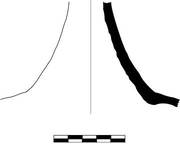
13. Guttus (Ca. 225 BC)
P. H. .032. Th. .005.
K/L16/17.0489:1. Traces of incised scrolls around the body. Pinkish gray (2.5YR 5/3) matt black glaze
svg/K-L16-17.0489-1.jpg
14. Guttus (ca.225 BC)
P. H. .032. Th. .005.
K/L16/17.0489:2. Bead-and-reel decoration on shoulder. Pinkish gray (2.5YR 5/3) matt black glaze
svg/K-L16-17.0489-2.jpg
15. Miniature kantharos (ca.225 BC)
P. H. .026. Th. .006.
K/L16/17.0493:1. Running ivy in white slip on neck. Cut grooves below the body. Pinkish buff (2.5YR between 6/4 and 6/6) matt black glaze.
Mosaic Building City Wall x33/34.
svg/K-L16-17.0493-1.jpg
16. Cookpot rim (Hellenistic)
K17.0376:1. Single rim sherd.
svg/K17.0376-1.jpg
17. Cop, outturned rim (Hellenistic)
K17.0376:3. Single rim sherd. Black slip.
18. Beaker rim (Hellenistic)
K17.0376:4. Single rim sherd.
svg/K17.0376-4.jpg
19. Plate Ephesian (Late Augustan/Tiberian)
P. H. .022. Est. diam. rim .33. Th. .008.
K17.1314:1. Deep smoothening marks exterior of the wall. Brownish fabric (2.5YR 5/4) matt black glaze in and outside.
svg/K17.1314-1.jpg
20. Platter with rouletting Ephesian
P. H. .016. Est. diam. base .24. Th. .01.
K17.1314:2. Rouletting within rouletted lines. Micaceous brown fabric (2.5YR 5/4) shiny black glaze interior traces of polish on glaze.
svg/K17.1314-2.jpg
21. Eastern Sigillata A Hayes Form 3
P. H. .017. Est. diam. rim .30. Th. .007.
K17.1314:3. Pale fabric with shiny red slip.
svg/K17.1314-3.jpg
22. Cup gray local
P. H. .011. Est. diam. rim .11. Th. .005.
K17.1314:4. With everted rim. Gray with self slip
svg/K17.1314-4.jpg
23. Cup gray, local (75/25 BC)
P. H. .011. Est. diam. base .06. Th. .005.
K17.1314:5. Gray with self slip.
svg/K17.1314-5.jpg
24. One-handler, Atticizing
P. H. .022. Est. diam. rim .12. Th. .5.
H17.0732:1. Pinkish buff fabric with shiny black glaze.
Rotroff 1997, 329 n.856, fig.58 (325-300 BC).
svg/H17.0732-1.jpg
25. One-handler, Atticizing
H17.1059:2. PH. 1.8; est. D.rim 12 ; Th. 0.4. Preserving 1/20 of rim. Pinkish buff fabric with red slip flaked off the surface.
Rotroff 1997, n. 860, ADD. (300-290 BC)
svg/H17.1059-2.jpg
26. Kantharos, Atticizing
H17.1065:1. PH. 1.8; est. D.rim 11; Th. 0.6. Preserving 1/20 of rim whole handle. Pinkish buff dense fabric metallic black glaze.
City Wall (Tekkok 2000, (Berlin 1999, 122, n.129, pl.22, H2 Construction, under wall).
svg/H17.1065-1.jpg
27. Kantharos. Regional.
H17.1048:6. PH. 2; est. D.base 3.2; Th. 0.5. Preserving whole base. Conical base. Similar in North Building below plaster floor. Pinkish buff fabric (between 2.5YR 6/4 and 6/6) and with matte black/ brown slip.
Berlin 1999, 130, n.190, pl.26, H2a Occupation.
svg/H17.1048-6.jpg
28. Basin, Type 2, Local.
H17.1048:1. PH. 2.4; est. D.rim 28; Th. 0.6. Preserving 1/10 of rim. Pinkish buff fabric, no slip.
Berlin 1999, 142, n. 283, pl.9, H2b Occupation 130-100 BC.
svg/H17.1048-1.jpg
29. Eastern Sigillata A, Hayes Form 3 (50-25 BC)
H17.0937:1. PH. 2.0; est. D.rim 20; Th. 0.6. Pale yellow buff fabric with red slip flaking off the surface.
svg/H17.0937-1.jpg
30. Casserole, ledge rim. Regional
H17.0937:2. PH.1.5; est. D.rim 21.2; Th. 0.6. Preserving 1/10 of rim. Pinkish buff fabric (between 2.5YR 6/4 and 6/6) fired gray around rim.
svg/H17.0937-2.jpg
31. Gray ware plate, local (75-25 BC)
H17.0927:4. PH. 2.2; est. D.base 7.0; Th.0.5. Preserving complete base with rouletting.
Light gray (2.5YR N5) fabric with black slip.
svg/H17.0927-4.jpg
32. Bowl. Pergamene (50BC - AD 25)
H17.0927:2. PH. 4.0; est. D.base 4.4.; Th. 0.4. Preserving 1/3 of base. Pinkish buff fabric with thick red slip.
svg/H17.0927-2.jpg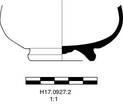
33. Pergamene, thin walled (Ca. 75-25 BC)
H17.0927:7. PH. 2.2; est. D.rim 10; Th. 0.4. Preserving 1/8 of rim. Pinkish buff fabric with red slip mottled into black exterior of the rim.
svg/H17.0927-7.jpg
34. Beaker, thin walled. Regional (Augustan)
H17.0927:3. PH. 1.1; est. D.base 5.4; Th. 0.4. Preserving 1/4 of base. Gray fabric with self slip.
svg/H17.0927-3.jpg
35. Unguentarium (Ca. 100-75 BC)
H17.0927:5. PH. 11; est. D.base 4.0; Th.0.5. Pinkish buff fabric hard fired, with cream surface. Similar complete examples from the well.
svg/H17.0927-5.jpg
36. Regional Cooking pot, ledge rim (Augustan)
H17.0927:6. PH. 4.6; est. D.rim 16; Th. 0.6. Preserving 1/4 of rim. Pinkish core (2.5YR 5/4) with brown exterior (2.5YR 4/3) blackened on exterior.
svg/H17.0927-6.jpg
37. Kantharos, spur handles
D20.0235:22. PH. 1; est. D.rim 8; Th. 0.4. Preserving 1/6 of rim. Preserving upper half of handle. Pinkish red fabric (2.5YR 6/6) with thick metallic black glaze. Berlin 1999, 105, n.8, pl.13.
38. Kantharos
D20.0235:17. PH. 4.9; est. D.rim 10; Th. 0.5. Preserving 1/10 of rim. Stylized ivy decoration, ivy in tan, scrolls by incision. Pinkish red fabric, brownish black thick glaze.
Berlin 1999, 105, n.6, pl.13. Early Hellenistic Building (z6.388).
39. Bowl, incurved ledge rim. Local.
D20.0235:14. PH. 6; est. D.rim 15; Th. 0.6. Preserving 1/20 of rim. Traces of red slipped decoration on rim and wall. Micaceous brown fabric (2.5YR 5/4) with gold mica on surface, and body. Traces of handle.
svg/D20.0235-14.jpg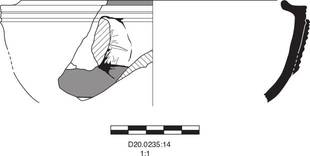
40. Basin, ledge rim. Local.
D20.0235:21. PH. ; est. D.rim; Th. 0.7. Preserving 1/10 of rim. Brown micaceous fabric peeling of the surface,low fired.
Berlin 1999, 107, n.19, pls.9, 14. (gray).
svg/D20.0235-21.jpg
41. Dish, outcurving rim
D20.0262:1. PH. 3; est. D.rim . 16; Th. 0.5. Preserving 1/6 of rim with wall. Traces of rouletting interior. Gray fabric with thick black slip.
Sardis (Rotroff 4th Century BC).
svg/D20.0262-1.jpg
42. Chytra, regional
D20.0262:2. PH. 2; est. D.rim 20; Th. 0.4. Preserving 1/6 of rim. Brown gritty gray fabric with silver mica, gray on surface.
Berlin (D9); Sardis (Rotroff).
svg/D20.0262-2.jpg
43. Basin with inturned rim. Regional.
D20.0336:1. SC21-2v. PH.6.5; est.D.rim 18; Th.0.6. Preserving 1/2 of rim. Red slipped decoration irregular band of slip around rim, slipped wavy lines on wall. Traces of handle on shoulder. Joins to 243. WRONG PROFILE DRAWING.
44. Fish plate (Ca. 300-280 BC)
D20.0258:2. PH. 3.4; est. D.base 14; Th. 0.7. Preserving 1/6 of base. Pinkish buff hard fabric (10R 6/6), with thick black glaze. Scraped groove around depression, resting surface of foot reserved.
Quarry Dump (Berlin 1999, 105, n.3, pls 1,12).
svg/D20.0258-2.jpg
45. Saucer. Regional
D20.0235:15. PH. 3.2; est. D.rim 6.6; Th. 0.5. Semi glazed. Preserving ½ of rim with wall. Pinkish buff fabric overfired, mottled into gray.
H1 Occupation (Berlin 1999, 113, n.65, pls.4, 17, ca.260-240 BC).
svg/D20.0235-15.jpg
46. Bowl with ledge rim. Regional.
D20.0258:1. PH. 4.7; est. D.rim 32; Th. 0.5. Preserving 1/6 of rim with wall and handle. Ledge rim, rolled handles below rim. Orangish buff fabric (5YR 7/4) with self slip.
svg/D20.0258-1.jpg
47. Plate, banded (Ca. 225 BC)
D20.0164:6. PH. 1.2; est. D.rim 22; Th. 0.5. Preserving 1/10 of rim. Pinkish buff fabric (2.5YR 7/4) with thin black slip in and out, scraped around rim.
City Wall (Tekkok 2000, 91, n.18, pl.1); H2 Construction Fills (Berlin 1999, 120, n.108, pl.21).
svg/D20.0164-6.jpg
48. Plate, banded. Regional.
D20.0268:7. PH. 4.8; est. D.rim 34; Th. 0.8. Preserving 1/6 of rim and wall. Banded in brown slip. Brown micaceous fabric (5YR 5/4).
Mosaic Building (Tekkok ADD).
49. Plate. Pergamene.
D20.0272:2. PH. 0.8; Th. 0.5. Preserving 1/10 of wall. West Slope style petal leave in tan. Pinkish buff fabric (2.5YR 7/6) with thick black slip in and out.
50. Fish plate (ca. 225 BC)
D20.0235:16. PH. 1.9; est. D.rim 21; Th. 0.6. Scraped groove around rim. Preserving 1/20 of rim. Pinkish red fabric, hard fired, red slip mottled into black.
51. Kantharos with spur handles. Regional. (Ca. 225 BC)
D20.0227:4. PH.3.2; est.D. from neck 5.0; Th. 0.5. Preserving 1/8 of neck. Pinkish buff fabric (2.5. YR 6/4 and 6/6) with matte brown slip exterior, red interior.
City Wall (Tekkok 2000, 92, n.23, pl.2); Mosaic Building (Tekkok ADD).
52. Kantharos, West Slope Style. Pergamene (Ca. 225 BC)
D20.0227:3. PH. 3.7; Th. 0.5. Preserving 1/8 of neck. Stylized ivy decoration, ivy in tan, scrolls by incision. Pinkish buff fabric (2.5YR 6/6) with shiny black slip exterior, fired red interior.
City Wall (Tekkok 2000, 92, n.29, pl.3).
53. Kantharos. Regional.
D20.0268:2. PH. 4.9; est. D.rim 9; Th. 0.4. Preserving 1/6 of rim. Pendant bud decoration. Pendants in tan, wreath in white. Pinkish buff hard fabric (2.5YR 7/4), matte brown slip in and out.
Garden Dump (Berlin 1999, 128, n.167, pl.25, H2 Occupation). Mosaic Building (Tekkok ADD).
54. Kantharos. Regional.
D20.0268:5. PH. 3.4; est. D.rim 10; Th. 0.4. Preserving 1/6 of rim. Stylized ivy decoration with incised scrolls. Ivy in thick white slip. Pinkish buff fabric (2.5YR 7/4), shiny black slip.
City Wall (Tekkok 2000, 92, n. 29, pl.3); Garden Dump (Berlin 1999, 128, n.168, pl.25, H2 Occupation); Pergamon (De Luca 1968, ADD, n.282, pl.50, Bauphase ADD). THIS NUMBER IS DOUBLED.
svg/D20.0268-5.jpg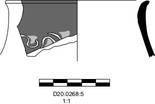
55. Kantharos. Pergamene.
D20.0272:4. PH. 2.6; Th. 0.5. Preserving 1/8 of neck fragment. Pendant bud decoration, buds in tan, wreath in white slip. Pinkish buff fabric (2.5YR 7/4) with thick brown slip exterior, fired red interior.
Garden Dump (Berlin 1999, 128, n.165, pl.25, H2 Occupation).
56. Kantharos. Regional.
D20.0268:1. PH. 4.2; est. D.rim 6.0; Th. 0.4. Preserving 1/8 of neck. One handle with knob thumb rest. Pinkish buff fabric (2.5YR 6/4) with thin brown slip.
City Wall (Tekkok 2000, 92, n.28, pl.3); Garden Dump (Berlin 1999, 128, n.163, pl. 26, H2 Occupation).
57. Kantharos, molded base. Regional.
D20.0144:1. PH. 3.5.; D.base 2.5; Th. 0.5. Preserving complete base. Pinkish buff dense fabric (between 2.5YR 6/4 and 6/6) and with matte black/ brown slip. Fired gray at core.
City Wall (Tekkok 2000, 92, n.25, pl. 2).
svg/D20.0144-1.jpg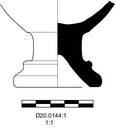
58. Kantharos, molded base. Local.
D20.0164:5. PH. 2.4; est. D.base 6; Th. 0.5. Preserving 1/6 of base. Gray fabric with self slip.
Garden Dump (Berlin 1999, 130, n.183, pl.26, H2 Occupation).
59. Kantharos, molded base. Pergamene.
D20.0272:1. PH. 5.8; est. D.base 7; Th. 0.5. Preserving 1/2 of base. Ribbed lower body. Pinkish buff fabric (2.5YR 6/6) with thick brown/black slip.
Garden Dump (Berlin 1999, 130, n.175, pl.25, H2 Occupation).
60. Kantharos, molded base. Pergamene.
D20.0227:7. PH. 3.7; est. D.base 3.2; Th. 0.7. Preserving ½ of base. Pinkish buff fabric (2.5 YR 6/6) with shiny thick brown slip.
Garden Dump (Berlin 1999, 130, n.179, pl. 26, H2 Occupation).
61. Basin with inturned ledge rim. Local (Ca. 225 BC)
D20.0227:8. PH. 2.4; est. D.rim 39; Th. 0.5. Preserving 1/20 of rim. Pinkish buff fabric (2.5YR 7/4) with cream exterior, added white slip on rim.
West Sanctuary (Tekkok).
62. Kantharos, loop handles. Pergamene. (150-130 BC)
D20.0235:25. PH. 3.5; est. D.rim 8; Th. 0.5. Preserving ¼ of rim and wall. Two unjoining fragments. Everted rim, ivy leaf thumb rest. West Slope style decoration, pendant buds in tan, wreath in white. Pinkish buff fabric with fine black glaze in and out, red fired interior.
Garden Dump (Berlin 1999, 128, n.174, pl.25); Behr 1988 ADD.
63. Saucer, incurving rim. Pergamene
D20.0227:2. PH. 2.0; est. D. rim 10; base 5.0; Th. 0.4. Preserving ¼ of wall with base. Incurving rim, shallow ring base. Semi glazed, preserving red slip interior.
City Wall (Tekkok 2000, 93, n.37, pl.4); Garden Dump (Berlin 1999, 132, n.202, pls.4, 135, H2 Occupation).
64. Bowl, incurved rim. Local.
D20.0288:5. PH. 3.7; est. D.rim 12; Th. 0.6. Preserving 1/10 of rim. Gray micaceous fabric with shiny silverish slip interior.
65. Bowl, hemispherical. Pergamene
D20.0235:19. PH. 3.7; est. D.rim 12; Th. 0.5. Preserving 1/10 of rim. Scraped line around rim, double ridges around rim. Stylized ivy decoration, ivy in tan, scrolls by incision. Pinkish buff fabric with thick black glaze.
West Sanctuary (ADD); Garden Dump (Berlin 1999, 130, n.192, pl.26).
66. Bowl hemispherical.
D20.0164:1. PH. 3.5; est. D.rim 18; Th. 0.5. Preserving 1/6 of rim. Pinkish buff fabric (2.5YR 7/4) with thick black slip. Two deep ridges around rim. Stylized scrolls by incision and berries in tan.
West Sanctuary (Tekkok); Garden Dump (Berlin 1999, 130, n.192, pl.26, H2 Occupation).
67. Bowl, hemispherical. Pergamene.
D20.0300:1. PH. 6.2; est. D.rim 11.6; Th. 0.4. Preserving 1/6 of rim with wall. Pinkish buff fabric (2.5YR 6/6) with thick brown black slip. Stylized ivy decoration, ivy in tan, scrolls and berries in white slip.
West Sanctuary (Tekkok).
68. Bowl hemispherical. Pergamene.
D20.0268:3. PH. 2.2; est. D.rim 30; Th. 0.4. Preserving 1/20 of rim. Pinkish buff fabric (2.5YR 7/4) with thick shiny black slip. Ovolo pattern interior of the rim, ovolos in white slip.
Berlin 1999, 122, n.128, pl. 22 (H2 Construction beneath wall 7, 150 BC).
69. Bowl, moldmade Pergamene.?
D20.0374:3. PH. 3.0; Th. 0.5. Ovolo pattern around rim, caduceus on the field. Pinkish buff hard fabrid, thick black glaze. NOT FOUND.
70. Bowl, moldmade. Local (Ca. 150-125 BC)
D20.0235:8. PH. 4.1; est. D.rim 15; Th. 0.5. Preserving 1/10 of rim. Two unjoining sherds. Preserving bird (to right)around the rim, and irregular imbricate nymphae caerulae decoration on wall (joins to 300). Pinkish buff fabric with matte red slip.
71. Guttus. West Slope Style. Pergamene (Ca.225 BC)
D20.0227:2. PH. 2.2; Th. 0.5. Preserving single shoulder piece. Stylized ivy scrolls in white thick slip, scrolls by incision. NOT FOUND.
West Sanctuary (Tekkok )
72. Unguentarium
D20.0235:23. PH. 3.2; est. D.base 2.4; Th. 0.5. Preserving complete base, conical under base. Pinkish buff fabric with matte brown slip.
West Sanctuary (Late Hell.Building fill 150-130 BC); Garden Dump (Berlin 1999, 134, n.214, pl.28)
73. Unguentarium
D20.0272:3. PH. 4.0; D.rim 2.2; Th. 0.5. Preserving complete rim with neck. Hooked rim. Pinkish buff fabric (2.5YR 7/4) with thick black slip in and out.
West Sanctuary (North Building fills 150-130 BC) (Tekkok ); Garden Dump (Berlin 1999, 132, n.213, pl.27, H2 Occupation).
74. Unguentarium
D20.0288:1. PH. 3.4; est. D.base 2.2. Preserving complete base.Pinkish buff fabric fired gray at surface.
75. Amphora, West Slope Style. Pergamene
D20.0144:2. PH. 3.7.; est. D.shoulder 10; Th. 0.5. Preserving 1/10 of shoulder. Stylized olive leaves in tan, white intricate dots in between. Pinkish buff fabric (between 2.5YR 6/4 and 6/6) and with thick shiny black slip.
West Sanctuary (Tekkok); Pergamon (De Luca 1968, n.50, pl.37; Bauphase 5 265-235 BC, CHECK).
svg/D20.0144-2.jpg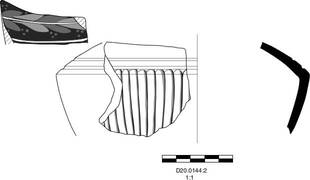
76. Jug with everted rim. Regional.
D20.0268:8. PH. 4.9; est. D.rim 5.0; Th. 0.5. Preserving 1/6 of rim with wall. Gritty gray dense fabric with silver mica.
Berlin 1999, 122, n.119, pl.21 (H2 Construction Fills); West Sanctuary North Building Fills (150-130 BC) Tekkok ADD.
77. Bowl with ledge rim. Local.
D20.0288:7. PH. 4.0; est. D.rim 28; Th. 0.7. Preserving 1/10 of rim. Single groove around rim. Orangish buff gritty fabric with a cream surface.
78. Plate, rolled rim. Regional
D20.0294:12. PH. 1.4; est.D.rim 19; Th. 0.4. Preserving ¼ of rim with wall. Pinkish buff fabric (2.5YR 6/6) with silver mica and lime inclusions, matte thick red slip.
Street Dump (Berlin 1999, 142, n.281, pl.32, H2b Occupation 133-100 BC). (Similar H17 well)
79. Dish with outcurved rim. Regional. (Late Hell to Early Roman)
D90.0294:4. PH.5 est.D.rim 14, base 5; Th. 0.5. Preserving complete base, full profile, 1/8 of wall. Pinkish fabric fired gray at core, black glaze, overfired. Stacking mark inside.
Rotroff Group E Agora
80. Bowl. Local. (ER)
D20.0294:3. PH. ADD; est. D.rim 12; base 4; Th. 0.5. Preserving ½ with base. Incurving rim, string cut base, deep turning marks interior. Orangish buff fabric (5YR 7/4) with fine silver mica.
81. Regional Black Glaze Outcurved Rim Bowl (Late Hellenistic)
P. H. .022. Est. diam. rim .095 (completely preserved). Est. diam. base .0559. Th. .0023.
K/L16/17.0461:7. Two joining sherds , complete except for modern chip. Compact fabric is light red (10R 6/8), few inclusions. The thin, brushed slip on all surfaces varies from dark red to black. It is these two sherds that indicate that the robbing of the Late Flavian House and the fill of the Early Second Century House were in close sequence.
82. Eastern Sigillata A Hayes Form 4 Profile (Late 2nd Century BC to Augustan)
P. H. .041. Est. diam. rim .24 (1/3 preserved).
K17.0937:26. Very fine fabric is somewhat pink for ware (7.5YR 8/4).Slip is dark red (10R 4/6).
p. 16, pl 1.
K17.0937-26.jpg
83. Eastern Sigillata A Base, near form 8 (Late 1st Century BC)
P. H. .016. Est. diam. base .11 (1/6 preserved). Th. .0045.
K/L16/17.0467:17. Single base sherd, hollow foot. Pale pink fabric (7.5YR 8/3), dark red slip (10R 4/4) of variable thickness. Light circular incision on floor.
p. 18 and tavola II.6.
svg/K-L16-17.0467-17.jpg
84. Eastern Sigillata A Hayes Form 22b Rim (late 2nd BC to Augustan)
P. H. .034. Est. diam. rim .09 (1/5 preserved). Th. .0061.
K/L16/17.0427:18. Single rim sherd to initiation of base. Very fine pale brown (7.5YR 7/6) fabric has rare tiny dark inclusions. Thin red (10R 4/6 where darkest) slip on all surfaces but worn in places, There is a patch with thinner slip on the exterior (probably a thumbprint).
Cf. tavola III.13.
svg/K-L16-17.0427-18.jpg
85. Eastern Sigillata A Hayes Form 22 Foot (late 2nd BC to Augustan)
P. H. .029. Est. diam. base .049 (completely preserved preserved). Th. .0057.
K/L16/17.0467:18. Single base sherd of bowl with flaring foot. Fine pale brown (10YR 8/3) fabric with frequent tiny darker inclusions. Interior carries partially preserved red slip (10R 4/8). Exterior same color but exhibits drip marks and underside of base is unslipped. The fabric is a touch more granular than other ESA.
Cf. tavola III.12.
svg/K-L16-17.0467-18.jpg
86. Eastern Sigillata A Hayes Form 45 Profile (early to mid-1st century AD)
P. H. .035. Est. diam. rim .08 (1/3 preserved). Th. .0054.
K17.0860:50. Single sherd, profile. Fine pale (near 7.5YR 8/3) fabric with no visible inclusions. Deep red slip (10R 4/6 where thickest). Pronounced scratches and voids on surface. Double dipping streak.
p. 34, pl. 6.
K17.0860-50.jpg
87. Ephesian Gray Ware Platter Rim (BC 50 to AD 50)
P. H. .024. Est. diam. rim .31 (<1/20 preserved). Th. .0078.
y59.0008:1. SC08-1b. Single rim sherd with beginning of floor. Reddish tint to slip, perhaps from burning.
Cf. F2-F7.
y59.0008-1.jpg
88. Ephesian Gray Ware Platter Rim (BC 50 to AD 50)
K17.0777:41. Single rim sherd. P.H. est. .035, est. D. rim not recoverable, near .48(?), Th. rim .019. Compact gray (5Y 6/1) fabric with frequent tiny mica specs. Highly polished dark gray surface.
Cf. F2-F7.
K17.0777-41.jpg
89. Ephesian Gray Ware Plate Base (Early Roman)
K/L16/17.0467:13. P.H. .018, D. bas .12 (1/5 preserved), th. floor .005. Single base sherd. Plate with flat floor and ring foot. Dark gray fabric (2.5Y 4/1) with occasional angular white inclusions. Partially preserved dark gray (5B 2.5/1) slip on interior. Exterior plain.
svg/K-L16-17.0467-13.jpg
90. Bowl. Knidian (Mid-first Century AD)
P. H. .064. Est. diam. rim .11 (1/12 preserved). Est. diam. base .048. Th. .0039.
D20.0294.002. P0361. Preserving complete base with profile. Gray fabric with fine self slip.
svg/P0361.jpg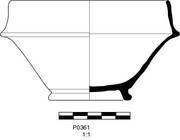
91. Molded Pyxis Base (Early Roman)
P. H. .071. Est. diam. base .13 (1/6 preserved). Th. .032.
K17.0845:12. Single sherd, lower wall and single applied foot. Dark gray (Gley 1 – 10Y 3/), slightly granular fabric with tiny white inclusions visible against the dark matrix. There are also rare large lime chunks, .002 in length, flattened on the surface or visible in the break, and a single large white chunk, 4.2mm, exploding in foot; single surface void. The surface is coated dark gray (Gley 1 N 3/) where not abraded. The decorative scheme is only partially restorable. A heron leans in from the left but only its long neck and head is preserved. It is pecking at a bunch of grapes. Beneath the heron’s neck is a long stem with further vegetal design below. This left part is relatively clear. The subject is unclear to the right. It seems to be a dense thicket of vines, no human or animal forms are recognizable. The only somewhat well-defined feature is a vertical cluster which starts as one line at its bottom but becomes two. The scene is reminiscent of early first century Italian motifs.
K17.0845-12.jpg
92. Gray Ware Jug Base (Early Roman)
P. H. .029. Est. diam. base .06 (completely preserved preserved). Th. .0031.
K/L16/17.0461:26. Single sherd of complete base, short grooved ring foot. Soft flakey brown (2.5YR 4/4) fabric, highly micaceous. Exterior surface is gray (10YR 4/1), darker and glossy where slip is best preserved. The interior has a spiral smoothing mark. It is noteworthy that the interior surface is very similar to the surfaces of micaceous water jars (MRA/LRA 3). This further indicates a south-west Anatolian source.
svg/K-L16-17.0461-26.jpg
93. Macedonian Gray Sigillata (Fourth Century)
P. H. 2.2. Est. diam. rim .12 (1/10 preserved). Th. .005.
D20.0183:16. Single sherd, ledge rim. Gray fabric highly micaceous, thin fine gray slip.
svg/D20.0183-16.jpg
94. Italian Sigillata Conspectus Form 12.1 Rim (Mid- to Late Augustan)
P. H. .029. Est. diam. rim .30 (1/16 preserved). Th. .0039.
K/L16/17.0467:2. Single sherd. Pale pink fabric (2.5YR 7/6), deep red slip (10R 4/6) worn in places but otherwise evenly applied to achieve a high sheen.
Cf. form 12, p. 72, plate 11.
svg/K-L16-17.0467-2.jpg
95. Italian Sigillata Conspectus Form 12.5 Rim (Mid- to late Augustan)
P. H. .021. Est. diam. rim .18 (<1/20 preserved). Th. .0042.
K/L16/17.0467:1. Single sherd preserves 1/20 rim circumference. P.H. .021, D. rim 18, Th. .0042. FPale pink fabric (2.5YR 7/6), deep red slip (10R 4/6) worn in places but otherwise evenly applied to achieve a high sheen.
Cf. p. 72, plate 11.
svg/K-L16-17.0467-1.jpg
96. Italian Sigillata Conspectus Form 18 (Early First Century AD)
P. H. .029. Est. diam. rim .42 (1/10 preserved). Th. .0063.
D20.0235:26. Rouletting around rim. Pierced hole on rim. Preserving over 1/10 of rim and wall. Pinkish buff fabric with thick red slip.
Cf. form 18.
svg/D20.0235-26.jpg
97. Italian Sigillata Conspectus Form 20.4 Rim (Domitianic)
P. H. .03. Est. diam. rim .295 (1/12 preserved). Th. .0044.
K/L16/17.0169:2. Two non-joining sherds with wall and beginning of floor. Reddish brown (2.5YR 6/3) fabric, very fine with occasional light inclusions. Very glossy dark red (near 10R 4/8) slip on all surfaces, flaking in places. Rouletting on upper and lower molding.
Cf. form 20.
svg/K-L16-17.0169-2.jpg
98. Italian Sigillata Conspectus Base 12
P. H. .03. Est. diam. rim .295. Est. diam. base .08 (1/12 preserved). Th. .0037.
M18.0435:1. Red (near 2.5YR 6/4) highly compact fabric with essentially no inclusions. Deep red (25.YR 4/8) slip on all surfaces, smoothed on interior, brushed on exterior. Two concentric incised grooves on floor, positioned just inside of high ring foot.
Cf. p. 158, Abb. 6. This type of foot is associated only with Conspectus form 20. Its relative height suggests a date in the second half of the first century.
svg/M18.0435-1.jpg
99. Italian Sigillata Hemispherical Cup, Cf. Conspectus Form 36 (1st Century AD)
P. H. .0175. Est. diam. rim .15. Th. .003.
K/L16/17.0434:21. Single rim sherd preserves 1/10 rim diameter. P.H. .0175, est. D. rim .15, Th. .003. Fine light reddish-brown (2.5YR 6/6) fabric with no inclusions observed. The slip is dark reddish brown (2.5YR 4/8) with white underslip visible where slip is flaking away.
Cf. p. 114, pl. 32..
svg/K-L16-17.0434-21.jpg
100. Italian Sigillata Flanged Bowl (1st Century AD)
P. H. .03. Est. diam. rim .06 (1/20 preserved). Th. .004.
K/L16/17.0434:28. Single rim sherd. Single rim sherd. Pale pink (5YR 7/4) fabric with no visible inclusions. Dark red (nearest 10R 4/8) slip smoothly applied to all extant surfaces but worn on outer face of rim. The slip is relatively glossy.
Cf. forms 23 and 34 (both 1st century).
svg/K-L16-17.0434-28.jpg
101. Italian Sigillata Conspectus Form 23.2 Conical Cup (50-100)
P. H. .033. Est. diam. rim .07 (1/4 preserved). Th. .02.
K/L16/17.0100:6. Single rim sherd. Fine pale red (2.5YR 6/6) fabric with very rare tiny light inclusions. Slip is dark red (nearest 2.5YR 4/8). Molded double scroll on outer face of rim.
Cf. form 23.
svg/K-L16-17.0100-6.jpg
102. Italian Sigillata Chalice. Cf. Conspectus R2 or R3 (Augustan to Tiberian)
P. H. .046. Est. diam. rim .18 (1/8 preserved). Th. .0025.
K17.0848:1. Single sherd. Very fine, light red (2.5YR 6/6) fabric with no visible inclusions. Dark red (near 10R 4/8) slip, high gloss.
R2 or R3.
K17.0848-1.jpg
103. Eastern Sigillata Bi Footed Bowl Base (late 1st Century BC - early 1st Century AD)
P. H. .016. Est. diam. base .10 (<1/4 preserved). Th. .0035.
K/L16/17.0430:1. Complete base. Fine orange brown (2.5YR 6/8) fabric with tiny golden mica. Interior is covered with thick and very smooth orange (2.5YR 4/8) slip, thinner on exterior; underside of foot is plain. There is excess clay and surface voids on underside of base.
Cf. , nos. H73-83.
svg/K-L16-17.0430-1.jpg
104. Eastern Sigillata Bi Ring Foot (late 1st Century BC - early 1st Century AD)
P. H. .0162. Est. diam. base .041 (5/6 preserved). Th. .0031.
K17.0860.103. P0517. Nearly complete base. Fine orange brown (2.5YR 6/8) fabric with tiny golden mica. Interior is covered with thick and very smooth orange (2.5YR 4/8) slip, duller on underside. Groove on resting surface of foot. 'ΔΩ/ΡΟΝ' stamp.
105. Eastern Sigillata Bi Hayes Form 4 Rim (early 1st)
P. H. .024. Est. diam. rim .18.
K/L16/17.0427:5. Single rim sherd. Micaceous orange-brown (2.5YR 4/6) fabric, red (2.5YR 4/8) slip. Light rouletting under rim.
, tavola xi.13.
svg/K-L16-17.0427-5.jpg
106. Eastern Sigillata Bi Hayes Form 35 (mid 1st century AD)
H. .038. Est. diam. rim .086 (1/10 preserved). Th. .004.
K/L16/17.0120:5. Single sherd. Micaceous, very fine, brown (2.5YR 6/8) fabric. Flaking deep brown (2.5YR 4/8) slip on all surfaces, thicker under short rim.
, p. 60, tavola XIII.5.
svg/K-L16-17.0120-5.jpg
107. Eastern Sigillata Bi Hayes Form 40 Beaker Base (early first AD)
P. H. .017. Est. diam. base .07 (1/3 preserved). Th. .0027.
K17.0845:8. Single sherd, lower wall and floor. Micaceous brown (5YR 6/6) fabric, thick red (2.5YR 4/8) slip. Concentric grooves on underside and a single groove on lower exterior wall.
Cf. , p. 61, tavola XIII.12.
svg/K17.0845-8.jpg
108. Eastern Sigillata Bii Hayes Form 58 Rim (50 to 125 AD)
P. H. .017.
K/L16/17.0474:5. Single rim sherd with part of floor. Compact brown (2.5YR 6/8) fabric with frequent golden mica. Dark red (2.5YR 4/8), flaking slip on all surfaces.
, p. 63, tavola XIV.
svg/K-L16-17.0474-5.jpg
109. Eastern Sigillata Bii Type 58 Base (AD 50 to 125)
P. H. .015. Est. diam. base .095 (1/5 preserved). Th. .0036.
K/L16/17.0427:2. Single base sherd. Micaceous orange-brown (2.5YR 4/6) fabric, red (2.5YR 4/8) slip is worn. Two incised grooves.
svg/K-L16-17.0427-2.jpg
110. Eastern Sigillata Bii Hayes Form 60
D20.0235:12. . PH. 2.3; est. D.rim 14; Th. 0.6. Preserving 1/20 of rim. Micaceous, pinkish buff compact fabric with thick, flaking red slip in and out.
svg/D20.0235-12.jpg
111. Eastern Sigillata Bii Hayes Form 60b (100-150)
H. .032. Est. diam. rim .17 (1/10 preserved). Th. .004.
H17.0727:1. Single sherd preserves rim and wall to base. Soft, reddish brown (2.5YR 6/8) fabric with frequent tiny mica. Darker (2.5YR 5/8), thick slip on all preserved surfaces.
, p. 63, tavola 14.5-6. Cf. , no. 90 for date.
H17.0727-1.jpg
112. Eastern Sigillata Bii Hayes Form 76 variant (100-150 AD)
H. .042. Est. diam. rim .030 (<1/20 preserved). Th. .0063.
K/L16/17.0427:1. Two joining sherds sherd preserving complete profile. Micaceous orange-brown (2.5YR 4/6) fabric, red (2.5YR 4/8) slip. The distinctive features of the vessel are the ESB 76-type “hollow” base and the everted rim with rounded top that has two closely spaced grooves at its midpoint. The rim is also distinguished from the interior wall by a shallow offset. Likewise the floor and inner wall are separated by a groove. In general, the rim of this vessel suggests a large 55, whereas the base is good for a 76. An intermediate form would belong to the early 2nd century.
Cf. , p. 68-69; tavola XV.11.
svg/K-L16-17.0427-1.jpg
113. Eastern Sigillata Bii Hayes Form 76 (100-150 AD)
H. .02. Est. diam. rim .024 (1/10 preserved). Th. .007.
K/L16/17.0467:7. Brown micaceous fabric (5YR 6/6), orange slip (10R 5/8) flaking in places and thickly applied under rim.
, p. 68-69; tavola XV.11.
svg/K-L16-17.0467-7.jpg
114. ESC/Pergamene Hemispherical Bowl, Thin Wall
P. H. .042. Est. diam. rim .10 (1/4 preserved).
K/L16/17.0086:6. Two joining sherds, modern break. Very compact, light red (btw 10R 6/6 and 6/8) fabric with rare lime inclusions. Slip is red (10R 5/8) on interior and below stacking line on exterior. Above line it is darker (around 10R 4/4). A very well made piece, well fired, nice surface, etc. There is patch of thick slip on the exterior that has cracks in it.
no. 181 (Pergamene, ).
svg/K-L16-17.0086-6.jpg
115. Çandarli Loeschke Form 1 Plate Rim (AD 1-100)
P. H. .036. Est. diam. rim .25 (<1/20 preserved). Th. .01.
K/L16/17.0434:1. Single sherd, with high rim and floor. Compact light red (2.5YR 6/6) fabric with infrequent tiny light. The surface slip is fired orange (near 2.5YR 5/8) and smoothed, though unevenly applied.
p. 75 and pl. XVI.16.
svg/K-L16-17.0434-1.jpg
116. Çandarli Loeschke Form 6 Profile (Late first to Second AD)
H. .024. Est. diam. rim .10 (1/10 preserved). Th. .005.
K/L16/17.0120:1. Compact light red fabric (2.5YR 6/6) with very few inclusions, occasional tiny micaceous flakes in direct sunlight. Thick well-smoothed orange (near 2.5YR 5/8) slip on interior, thin to almost plain on exterior.
p. 75 and pl. XVII.1.
svg/K-L16-17.0120-1.jpg
117. Çandarli Loeschke Form 6 Profile (Late first to Second AD)
H. .023. Est. diam. rim .12 (1/10 preserved). Th. .001.
K/L16/17.0427:6. Fine light red (2.5YR 6/8) fabric with occasional tiny white inclusions. Darker slip (towards 2.5YR 5/8) is relatively orange for ware, extant on all surfaces, including underside of foot, thicker and smoothed on interior. Exterior shows narrow smoothing bands on curved wall and scratches closer to the base. Interior has two sets of concentric incised grooves on floor.
p. 75 and pl. XVII.1.
svg/K-L16-17.0427-6.jpg
118. Çandarli Loeschke Form 6 Rim (Late first to Second AD)
P. H. .026. Est. diam. rim .15 (1/5 preserved). Th. .006.
K/L16/17.0474:3. Singe rim sherd. Fine orange (5YR 6/6) fabric with occasional tiny light and dark inclusions. Smoothed dark orange slip (near 2.5YR 6/8) on interior. Exterior slip same but slightly thinner. Exterior shows distinct smoothing bands.
p. 75 and pl. XVII.1.
svg/K-L16-17.0474-3.jpg
119. Candarli Loeschke Form 9 Bowl Rim (First to Second Century AD)
P. H. .029. Est. diam. rim .16 (1/10 preserved). Th. .005.
K/L16/17.0434:24. Single sherd. The light red (10R 6/8) fabric has occasional tiny white inclusions. The dark red (nearest 10R 5/8) is smoothed on the interior but shows fine brush marks on the exterior.
svg/K-L16-17.0434-24.jpg
120. Dish, Candarli Loeschcke Form 9
D20.0374:2. PH. 1.8; est. D.rim 14; Th. 0.5. Preserving 1/6 of rim with wall. Pinkish buff fabric with matte orange slip.
121. Çandarli Loeschke Form 9 Rim (First to Second AD)
H. .021. Est. diam. rim .11 (1/5 preserved). Th. .006.
I17.0647:9. Single sherd to floor. Fine light red (10R 6/8) fabric with tiny light inclusions, no mica. Surface is dark red (10R 5/8), thick slip is variably applied. Interior and exterior have alternating spiraling bands of smoothed and unsmoothed slip.
p. 76 and fig. XVII.2.
I17.0647-9.jpg
122. Çandarli Loeschke Form 9 Base (First to Second AD)
P. H. .014. Th. .006.
K/L16/17.0120:12. Single sherd with part of floor and wall. Compact red fabric (10R 5/8) with few tiny white inclusions. Dark red (10R 4/6) slip on interior and exterior, worn in places.
p. 76 and fig. XVII.2.
svg/K-L16-17.0120-12.jpg
123. Candarli Loeschke Form 9 Bowl Base (First to Second AD)
P. H. .036. Est. diam. base .10 (1/10 preserved). Th. .006.
K/L16/17.0169:3. Compact red (10R 5/6) fabric with occasional small light, elongated inclusions. Red (near 10R 4/8) slip on all surfaces. Smoothed interior, brush marks on exterior.
p. 76 and fig. XVII.2.
svg/K-L16-17.0169-3.jpg
124. Çandarli Loeschke Form 15 Rim (AD 50 to 100)
H. .032. Est. diam. rim .09 (1/10 preserved). Th. .0039.
K/L16/17.0461:5. Single sherd. Compact light red fabric (2.5YR 6/8) with no visible inclusions, bright orange slip (near 2.5YR 5/8) thickly applied on interior surface, thinner under flange and on exterior.
svg/K-L16-17.0461-5.jpg
125. Pergamene bowl, Meyer-Schlichtmann N39 (Mid-first Century AD)
P. H. .071. Est. diam. rim .11 (complete preserved). Th. .0027.
D20.0294.001. P0360. Preserving complete base with wall and much of high rim. Dipped from base, finger marks around the base. Graffiti under the base, lightly inscribed 'x'.
svg/P0360.jpg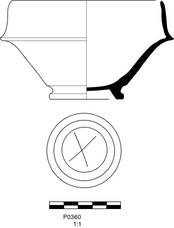
126. Çandarli Loeschke Form 19 Rim (75 to 150 AD)
P. H. .042. Th. .004.
K/L16/17.0474:1. Single rim sherd with wall below flange. Compact light red (2.5YR 7/6) fabric with occasional small white inclusions. Darker red (near 2.5YR 4/8) slip on all preserved surfaces. Smooth interior, brush marks visible on exterior.
svg/K-L16-17.0474-1.jpg
127. Çandarli Loeschke Form 19 Flanged Bowl Rim
P. H. .035. Est. diam. rim .15 (<1/20 preserved). Th. .004.
K/L16/17.0456:1. Single small rim sherd, upper tip of rim is chipped but its shape is fully restorable. Compact light red (2.5YR 6/6) fabric with tiny dark inclusions and small elongated voids. Slip on interior is red (near 10R 5/8) and well smoothed, as is the outer rim above the flange. The exterior slip below the flange is thinner, scratches; thick cracking slip under flange. Horizontal groove on the outer face of the rim just above the flange. Subtle groove below flange on outer face, a side effect of smoothing under the flange.
p. 76, pl. XVII.4-6. Similar groove on outer face of rim at , no. 818.
svg/K-L16-17.0456-1.jpg
128. Çandarli Loeschke Form 19 Flanged Bowl Rim
P. H. .031. Est. diam. rim .072 (1/4 preserved). Th. .003.
K/L16/17.0114:21. Single sherd, rim with initiation of base. Light red (2.5YR 7/6) fabric with occasional rounded light inclusions and voids. Dark red (10R 4/8) slip on all surfaces. Thick and smooth on interior and above flange on exterior. Thinner with broad drip lines on exterior below flange, plain patch on exterior.
p. 76, pl. XVII.4-6.
svg/K-L16-17.0114-21.jpg
129. Çandarli Loeschke Form 19 Flanged Bowl Rim (75 to 150 AD)
P. H. .04. Est. diam. rim .075 (1/4 preserved). Th. .004.
K/L16/17.0114:22. Single sherd preserves profile. Light red (2.5YR 7/8) fabric with occasional rounded lime inclusions and occasional voids. Dark red (10R 4/8) slip on all surfaces. Thick and somewhat smooth on interior; thinner and uneven on exterior, especially under flange. Very near in fabric and surface appearance to :21.
p. 76, pl. XVII.4-6.
svg/K-L16-17.0114-22.jpg
130. Çandarli Loeschke Form 19 Flanged Bowl Rim
P. H. .046. Est. diam. rim .12 (1/5 preserved). Th. .005.
K/L16/17.0114:20. Single rim sherd including wall to base. Compact light red (2.5YR 7/8) fabric with occasional small lighter inclusions and infrequent tiny voids. Occasional gold mica. Dark red (10R 4/8) slip on all surfaces. Thick but poorly smoothed on interior and above flange on exterior. The thick slip extends irregularly below the flange.
p. 76, pl. XVII.4-6.
svg/K-L16-17.0114-20.jpg
131. "High Gloss" Çandarli Loeschke Form 19 Flanged Bowl Rim
P. H. .031. Est. diam. rim .115 (1/10 preserved). Th. .004.
K/L16/17.0114:19. Two joining sherds preserving rim and wall. Reddish-yellow color (7.5YR 7/6) of the fabric is the result of a nearly even mix of red and yellow particles, which are discernible at 10x magnification. No other inclusions were observed but occasional tiny voids are present. The dark red slip (near 10R 4/6) is thin with metallic sheen. Slight brush marks are visible on the interior, whereas the exterior below the flange exhibits more distinct banding and scratches.
svg/K-L16-17.0086-9.jpg
132. Çandarli Loeschke Form 19 Profile (75 to 150)
P. H. .058. Est. diam. rim .116 (<1/10 preserved). Th. .005.
K/L16/17.0146:8. Pale red (10R 6/6) fabric with rare tiny dark inclusions and infrequent voids. The dark red slip (near 10R 4/8) is thin with metallic sheen. The interior and outer face of the rim are well smoothed. The exterior is rougher and parts of the outer face of the base are plain where the slip did not drip down completely; underside of the base is only partially slipped. There is a large surface void on the underside of the base.
svg/K-L16-17.0146-8.jpg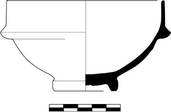
133. Çandarli Loeschke Form 19 Flanged Bowl Rim
P. H. .064. Est. diam. rim .18 (<1/10 preserved). Th. .0055.
K/L16/17.0114:23. Single rim sherd. Fabric is light reddish-brown (2.5YR 6/6) with frequent pale inclusions that create a “mottled” effect. The slip is dark (darker than 10R 4/8) and shiny, close to Italian Sigillata but not so even. No mica. It is worn away on much of the extant outer rim, a common occurrence with this Candarli variant. The slip is evenly applied below the exterior flange and has the same sheen but the surface of the vessel is less carefully smoothed as scratches are visible. There are two incised lines on the inner wall of the vessel placed at a level just above the lower edge of the outer flange.
p. 76, pl. XVII.4-6.
svg/K-L16-17.0114-23.jpg
134. Çandarli Loeschke Form 19 Flanged Bowl Rim
P. H. .025. Est. diam. rim .11 (1/8 preserved). Th. .003.
K/L16/17.0112:11. Single rim sherd. Compact reddish-brown (2.5YR 6/8) fabric with rare tiny inclusions. Darker red (10R 5/8) slip on all extant surfaces. There are broad smoothing bands visible on the interior and exterior. Cf. Slane 1994, no. 3 for similar profile and fabric dated to 3rd century.
svg/K-L16-17.0112-11.jpg
135. Çandarli Loeschke Form 19 Flanged Bowl Rim
P. H. .031. Est. diam. rim .12 (1/20 preserved). Th. .0041.
K/L16/17.0112:12. Single rim sherd. Compact red (10R 6/6) fabric, few tiny white inclusions. Red (2.5YR 4/8) slip on all extant surfaces. Wide smoothing bands visible on all surfaces.
svg/K-L16-17.0112-12.jpg
136. Çandarli Loeschke Form 19/Hayes Form 3 Flanged Bowl Rim
P. H. .031. Est. diam. rim .20 (<1/12 preserved).
K/L16/17.0118:5. Single sherd. Compact red (2.5YR 6/6) fabric with frequent tiny light, elongated inclusions. The red (near 10R 5/8) slip is evenly applied on all extant surfaces. Broad smoothing bands on both interior and exterior.
svg/K-L16-17.0118-5.jpg
137. Çandarli Hayes Form 3 Flanged Bowl Rim (2nd Century AD)
P. H. .044. Est. diam. rim 12 (1/8 preserved). Th. .008.
K/L16/17.0086:18. Single sherd. Light red (2.5Yr 6/6) fabric with rare tiny light inclusions. Slip is (10R 4.5/8) and generally thick. Rim is poorly formed at top
svg/K-L16-17.0086-18.jpg
138. Candarli Hayes Form 3 (3rd Century AD)
H17.0737:9. PH. 2.4; est. D.base 3.6; Th. 0.5. Preserving whole base. Pinkish buff fabric with thick red slip fine gold mica on surface.
Hayes 1983, 118, n.29, fig.3.
svg/H17.0737-9.jpg
139. Candarli Hayes Form 3 (2nd to 3rd Century)
D20.0334:19. PH. 4; est. D.rim 14; Th. 0.6. Preserving 1/6 of rim with wall. Pinkish buff fabric with thick red slip interior, not fully slipped exterior.
svg/D20.0334-19.jpg
140. Çandarli Loeschke Form 19 Flanged Bowl Rim (75 to 150)
H. .051. Est. diam. rim .11 (1/3 preserved). Th. .0046.
K17.0860:33. Two joining sherds, profile. Light red (10R 6/8) fabric with mostly frequent lime but also darker bits and frequent very small voids. Mica on surface. Slip is red (10R 5/8), slightly smoother and thicker on interior.
K17.0860-33.jpg
141. Çandarli Hayes Form 3 Flanged Bowl Rim (Third Century AD)
H. .052. Est. diam. rim .12 (1/5 preserved). Th. .0039.
K17.0860:54. Single sherd, profile. Light red (2.5YR 6/6) fabric with tiny lime and other varied tiny inclusions. Occasional very small voids. Occasional gold mica. Dark red (10 4/6 where thickest) red slip, which is smooth and slightly glossy on interior. The exterior slip is mostly thinner but there is a patch where it is very thick and dark, particularly under the flange. There is a very fine line incised on the interior.
K17.0860-54.jpg
142. Candarli Hayes Form 3 (2nd to 3rd Century AD)
D20.0222:5. PH. 3.5; est. D.rim 12; Th. 0.5. Preserving 1/6 of rim. Pinkish buff fabric with thick red slip.
svg/D20.0222-5.jpg
143. Candarli Hayes Form 3
H17.0748:6. PH. 1.7; est. D.base 6.0; Th. 0.7. Preserving 1/4 of base. Pinkish buff with thick red slip.
144. Candarli Hayes Form 3
H17.0748:9. PH. 2.4; est. D.rim 11; Th. 0.6. Preserving 1/10 of rim. Pinkish buff with thick red slip.
145. Candarli Hayes Form 3
H17.0748:11. PH. 2.8; est. D.rim 15; Th. 0.5. Preserving 1/8 of rim. Pinkish buff orange/red slip.
146. Çandarli Hayes Form 3 Rim (late 2nd to 3rd century)
P. H. .026. Th. .004.
K17.0845:9. Single rim sherd, diameter not recoverable. Light red fabric (2.5YR 6/8) with small light and other dark inclusions, small voids. Pronounced outer edge of flange. The red (between 10R 4/8 and 5/8) slip is equally applied on all extant surfaces.
svg/K17.0845-9.jpg
147. Çandarli Hayes Form 3 Rim (late 2nd to 3rd century)
P. H. .025. Est. diam. rim .13 (1/10 preserved). Th. .0045.
K17.0777:7. Single sherd. Compact light red (10R 6/6) fabric with few light inclusions and occasional gold mica also visible on the surface. Unpolished thick red (10R 5/8) slip on all extant surfaces.
K17.0777-7.jpg
148. Çandarli Loeschke Form 20 Bowl Rim
P. H. .019. Est. diam. rim near .12 (<1/20 preserved). Th. .006.
K/L16/17.0120:2. Single sherd. Fine red (5YR 7/6) fabric, showing mix of redder and yellower grains. Red slip (2.5YR 5/8) on all surfaces. Brush marks on interior, smoothing bands on exterior.
svg/K-L16-17.0120-2.jpg
149. Çandarli Loeschke Form 20 Rim (First to Second AD)
P. H. .0331. Est. diam. rim .12 (<1/10 preserved). Th. .0036.
K/L16/17.0461:4. Single rim sherd. Compact light red fabric (5YR 7/6) with lustrous orange slip (near 2.5YR 5/8) thickly applied on all surfaces, exterior scratched.
svg/K-L16-17.0461-4.jpg
150. Çandarli Loeschke Form 20 Rim
P. H. .036. Est. diam. rim .125 (1/7 preserved). Th. .0046.
K/L16/17.0086:21. Single sherd. Compact light red (5YR 7/6) fabric. Surface slip is red (2.5YR 5/8 and lighter). Exterior has light scratches and banding, interior is well smoothed.
svg/K-L16-17.0086-21.jpg
151. Candarli Loeschcke Form 20.
D20.0374:5. PH. 2.5; est. D.rim 11; Th. 0.5. Preserving 1/8 of rim. Orange buff fabric with thick red slip. Shallow turning marks.
152. Çandarli Loeschke Form 23 Lid (AD 50 to 100)
P. H. .041. Est. diam. rim .11 (1/10 preserved). Th. .004.
K/L16/17.0114:8. Compact light red (2.5YR 6/6) fabric with few inclusions. Red (near 10R 5/8) slip is poorly preserved on pocked surface.
svg/K-L16-17.0114-8.jpg
153. Çandarli Loeschke Form 23 Lid (AD 50 to 125)
P. H. .036. Th. .007.
D20.0235:28. Preserving only knob. Pinkish buff fabric with thick red slip.
svg/D20.0235-28.jpg
154. “Bright Orange” Candarli Loeschke Form 26a Bowl (50-100)
P. H. .020. Est. diam. rim .10 (<1/20 preserved). Th. .003.
K/L16/17.0120:3. Single sherd, wall to initiation of floor. Fine orange fabric (2.5YR 7/6), bright orange (near 10R 5/8) slip on all surfaces. Scratches on exterior. Groove under exterior rim.
svg/K-L16-17.0120-3.jpg
155. Çandarli Rim, near Loeschke Form 26a
P. H. .027. Est. diam. rim .15 (1/8 preserved). Th. .0033.
K/L16/17.0461:16. Single sherd preserving wall and minimal part of floor. Fine red fabric (2.5YR 5/6) with orange interior surface (2.5YR 5/8 and lighter). Exterior surface is incompletely slipped, reserved towards base, and shows smoothing bands and scratches.
Cf. no. 770, "Loeschke type 26a (forerunner)".
svg/K-L16-17.0461-16.jpg
156. Candarli Loeschcke Form 26a (AD 75-125)
C/D20/21.0434:1. PH. 5.2; est. D.rim 20; Th. 0.5. Preserving 1/6 of rim with wall. Orange buff fabric, highly micaceous, thick orange slip. (same as C29 well).
svg/C-D20-21.0434-1.jpg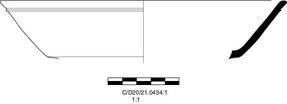
157. Çandarli Loeshcke Form 26a Bowl Base (50-100)
P. H. .05. Est. diam. base .10 (<1/20 preserved). Th. .009.
K/L16/17.0120:4. Single sherd. Fine fabric, pale pink (5YR 6/8) with occasional darker inclusions. Dark red slip (2.5YR 4/8) slip on all surfaces. Incised concentric circles on interior floor above base. A shallow offset indicates that the floor was smoothed with a broad tool whereas the walls show brush marks. High quality slip for ware.
svg/K-L16-17.0120-4.jpg
158. "High Gloss" Candarli Loeschke Form 26a/b Bowl (50-100)
Est. diam. rim .21 (<1/20 preserved). Th. .0035.
K/L16/17.0114:2. Three sherds, two joining, preserve profile. Pale (5YR 7/4) fabric with distinct lighter mottling. Occasional angular white inclusions up to .005 in length are also present. The slip is dark red (near 10R 4/6) with a high sheen on the interior and was evenly applied to all surfaces, it is now worn on the exterior below the rim, as is typical for highly fired Candarli. An incised circle is preserved on the interior floor above the base. It is partially obscured by a distinct “spacer” mark.
svg/K-L16-17.0114-2.jpg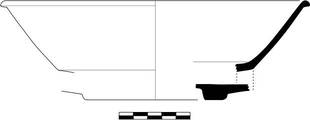
159. Candarli Hayes Form 2 (2nd to 3rd Century AD)
H17.0748:3. PH. 2.1; est. D.base 10; Th. 0.6. Preserving half of base. Pinkish buff fabric with matte thick red slip, gold mica on surface.
svg/H17.0748-3.jpg
160. Candarli Loeschke Form 26a Bowl (50-100)
H. .05. Est. diam. rim .23 (1/4 preserved). Est. diam. base .10 (1/2 preserved). Th. .0049.
K17.0937:1. SC11-2ee. Two joining sherds, complete profile. Light red (2.5YR 6/8) fabric with rare tiny white inclusions, frequent mica. Large lime chunks, .002 in diameter, are visible in breaks and on surface (perhaps from post-depositional spalling?). Elongated voids, particularly near foot. Thick red (10R 5/8) slip on interior is smoothed, exterior matte and thinner. Conserved. Lightly incised groove around center of floor, very light groove on lowest wall.
K17.0937-1.jpg
161. Candarli Loeschke Form 26a/b Bowl (50-100)
H. .05. Est. diam. rim .23 (1/4 preserved). Th. .005.
K/L16/17.0114:10. Two joining sherds preserve profile. The compact reddish (2.5YR 7/6) fabric has rounded light inclusions ranging from tiny to <.005. Surface is encrusted and pitteed, surviving slip is red (near 10R 5/8). The form of the base is interesting. From one perspective it is a fine L26a with distinct ring foot. From another you can see the potter merging the outer face of the base with the lower exterior wall, that is creating a profile that is well on the way to being an L26b.
svg/K-L16-17.0114-3.jpg
162. Çandarli Hayes Form 2 Profile (Second to Third Century)
P. H. .053. Est. diam. rim .22 (1/8 preserved). Th. .006.
K17.0688:2. P0538. Three joining sherds preserving profile; sherds have been conserved. Compact red (10R 7/8) fabric with occasional light bits, mica visible on surface. Darker red (10R 5/8) slip; interior smoothed, exterior shows light brush lines. Two grafiti on exterior: "double-axe" in hollow base and palm frond on wall.
163. Candarli Hayes Form 2
P. H. .01. Est. diam. rim .12 (1/12 preserved). Th. .0045.
K/L16/17.0112:13. Single rim sherd. Compact red (10R 6/8) fabric with occasional tiny white inclusions, some voids, golden mica visible on surface. Red (near 10R 6/8) slip on all surfaces, thinner patch extant on exterior well below rim.
svg/K-L16-17.0112-13.jpg
164. Candarli Hayes Form 2 (2nd to 3rd Century)
D20.0334:11. PH. 4.8; est. D.rim 20; Th. 0.6. Preserving 1/6 of rim and wall. Two joining sherds, modern break. Pinkish buff fabric with thick red slip interior, matte exterior.
svg/D20.0334-11.jpg
165. Candarli Hayes Form 2
H17.0748:7. PH. 2.3; est. D.rim 20; Th. 0.6. Preserving 1/20 of rim. Pinkish buff red slip regular fabric no gold mica on surface.
svg/H17.0748-7.jpg
166. Candarli Hayes Form 2
Est. diam. rim Not recoverable (small).
K17.0389:1. Single small rim sherd. Light red (2.5YR 6/6) fabric with occasional light inclusions. Darker red slip on extant surfaces. Two grooves are preserved near the rim on this small sherd.
K17.0389-1.jpg
167. Çandarli Hayes Form 2 Bowl Rim
P. H. .019. Est. diam. rim .20 (<1/10 preserved). Th. .006.
K17.0845:5. Single rim sherd. Light red (10R 6/6) fabric with frequent small light and dark inclusions and occasional voids up to .0035 in height. Gold mica visible in the fabric and flattened on the surface. The interior surface is worn but extant slip is dark for Candarli (between 10R4/4 and 4/6). The exterior is thinly slipped, unsmoothed, and lighter (10R 5/4) than the interior. Possibly burned.
svg/K17.0845-5.jpg
168. Çandarli Hayes Form 2 Bowl Rim
P. H. .02. Est. diam. rim ~.30 (1/10 preserved). Th. .0045.
K17.0845:6. Single rim sherd. Light reddish-brown (2.5YR 6/6) fabric with frequent small light inclusions. The red (10R 5/8) slip is thickly applied to the interior surface and well polished. The exterior slip is thinner with scratches.
svg/K17.0845-6.jpg
169. Çandarli Hayes Form 2 Bowl Rim
P. H. .013. Est. diam. rim .22 (1/20 preserved). Th. .004.
K17.0777:25. Single rim sherd. Reddish brown (5YR 6/6) fabric with occasional elongated lime and other darker inclusions and occasional tiny mica. The darker reddish brown (10R 4/4) slip is worn, particularly on the exterior surface. Rare voids. An example of the ‘worn slip’ variant of Candarli.
Cf. nos. 954-961.
K17.0777-25.jpg
170. Candarli Form 2 variant (2nd Century AD).
D20.0209:3. PH 2.4; est. D.rim 13; Th. 0.5. Preserving 1/4 of rim. Pinkish buff fabric with thick red slip.
svg/D20.0209-3.jpg
171. Çandarli Form Loeschke 27 Rim (AD 50-150)
P. H. .045. Est. diam. rim .20 (<1/20 preserved). Th. .008.
K17.0696:5. Single rim sherd. Light red (2.5YR 6/6) fabric with only occasional elongated light inclusions. Red (2.5YR 5/8) slip on all surfaces, smoothed on interior, brushed on exterior.
Cf. nos. 975 and 976.
K17.0696-5.jpg
172. Çandarli Form Loeschke 41 Rim (2nd Century AD)
P. H. .039. Est. diam. rim .20 (<1/10 preserved). Th. .007.
K/L16/17.0427:3. Single rim sherd. Light red (2.5YR 7/6) with angular white and darker inclusions. Thin red (2.5YR 5/7) slip on all surfaces. Thickened, slightly inturned rim.
Cf. nos. 566-576. See also TS015, identified as a Loeschke 42. An ESC version of ESB Hayes 76.
svg/K-L16-17.0427-3.jpg
173. Candarli Hayes Form 1 (2nd to 3rd Centuries AD)
D20.0334:17. PH. 2; est. D.rim 25; Th. 0.6. Preserving 1/10 of rim. Pinkish buff fabric with thick orange/red slip in and out.
svg/D20.0334-17.jpg
174. Candarli Hayes Form 1
D20.0211:2. PH. 2.5; est. D.rim 20; Th. 0.7. Preserving 1/10 of rim. Pinkish buff fabric with thick red slip.
Villa of Dionysos (Hayes 1983, 118, n.4, fig.2).
svg/D20.0211-2.jpg
175. Candarli Hayes Form 1 (2nd to 3rd Century AD)
D20.0209:1. PH. 5.3; est. D.rim 30; Th. 0.8. Preserving 1/10 of rim. Heavy rolled rim. Pinkish buff fabric with thick red slip.
Villa of Dionysos (Hayes 1983, 118, n.14, fig.3).
svg/D20.0209-1.jpg
176. Candarli Hayes Form 1 (2nd to 3rd Centuery AD)
D20.0209:5. PH. 2.6; est. D.rim 28; Th. 0.6. Preserving 1/20 of rim. Pinkish buff fabric with thick red slip.
Villa of Dionysos (Hayes 1983, 119, n.2, fig.2)
svg/D20.0209-5.jpg
177. Candarli Hayes Form 1 (3rd Century AD)
H17.0737:5. PH. 4.2; est. D.rim 23; Th. 0.7. Preserving 1/20 of rim. Pinkish buff fabric with thick red slip.
Hayes 1983, 118, n.2, fig.2.
178. Candarli Hayes Form 1 (3rd Century AD)
H17.0737:3. PH. 2.5; est. D.rim 28; Th. 0.7. Preserving 1/10 of rim. Pinkish buff fabric with thick red slip.
179. Çandarli Hayes Form 1 variant Rim (2nd - early 3rd Century)
P. H. .052. Est. diam. rim .25 (1/8 preserved). Th. .004.
K/L16/17.0419:1. Single sherd. Compact pale (5YR 7/6) fabric with tiny white and fewer tiny black inclusions. The dark red interior slip (between 10R 4/4 and 4/6) is evenly applied and smooth. The exterior slip is very much thinner, beginning at the outer face of the rim, where it is wearing through.
svg/K-L16-17.0419-1.jpg
180. Candarli Hayes Form 1
D20.0245:1. PH. 2.2; est. D.rim 20; Th. 0.7. Preserving 1/10 of rim. Pinkish buff hard fabric with thick red slip.
Knossos (Hayes 1973)
181. Candarli Hayes Form 1
P. H. .034. Est. diam. rim .29 (< 1/10 preserved). Th. .005.
D20.0227:9. Single sherd. Pinkish buff fabric with thick red slip.
svg/D20.0227-9.jpg
182. Candarli Hayes Form 1
P. H. .022. Est. diam. rim .26 (1/20 preserved). Th. .006.
D20.0282:15. Pinkish red fabric with thick orange/red slip.
svg/D20.0282-15.jpg
183. Çandarli Hayes Form 1 Base (2nd - 3rd Century)
P. H. .128. Est. diam. base .0958 (1/2 preserved).
K17.0860:26. Single base sherd. Pale pink (near 5YR 7/4) fabric with tiny varied, mostly light bits and occasional small reddish inclusions. Small voids, some elongated and up to .004 in length. Red (10R 4/8) slip is smoothed on interior with bands visible; thinner, matte on exterior with a few, short patches almost plain. Distinct groove between heavy foot and wall. Two spacer impressions on interior floor, both .0142 in diameter.
K17.0860-26.jpg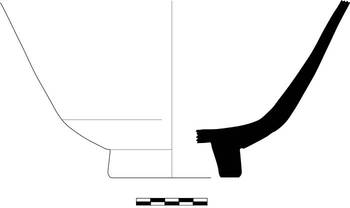
184. Çandarli Hayes Form 1 (Cf. Knossos 6) Base (2nd - 3rd Century)
P. H. .078. Est. diam. base .0966 (completely preserved). Th. .0059.
K17.0860:28. Two joining base sherds. Pale red (5YR 7/4) fabric with elongated and sub-rounded light, mostly calcareous, inclusions. Frequent very small irregular and elongated voids. Chip taken near base. Surface is darker red (10R 4/6). Thick and smoothed on interior. Exterior is thinner and is well smoothed only in wide bands. There is a floral stamp at the center of the floor but the design is not restorable. There is a single concentric circle around this central stamp. Two closely spaced incised lines on exterior. Two impressions of circular spacers are extant. One is .0125 in diameter, the other is .0142. The smaller has two chunks of the spacer adhering in the impression. The fabric of the spacer fragment is basically normal Candarli red (near 2.5YR 5/6, but small and hard to read). [N.B. the spacer may well have been fired many times so its is not necessarily indicative of much.] The slip and interior incised concentric groove go under the larger space remnant. This suggests that the bowl was brought to a “leather hard” stage when groove was “cut” and slip was applied. Then the piece was stacked in a kiln with spacers between the pieces. There is also a single spacer outline on the bottom of the ring foot. The diameter of this is not recoverable but may be near .0125. All the slip has worn off the bottom of the ring foot.
K17.0860-28.jpg
185. Çandarli Bowl Base
P. H. .033. Est. diam. base .09. Th. .004.
K/L16/17.0474:2. Base with high ring-foot, curved wall. Compact light red (2.5YR 6/6) fabric with occasional small white inclusions. Darker red (near 2.5YR 4/8) slip on all preserved surfaces. Smooth interior, brush marks visible on exterior.
See no. 20 for a Candarli base of similar form.
svg/K-L16-17.0474-2.jpg
186. Candarli Hayes Form 3
P. H. .01. Est. diam. base .055. Th. .005.
D20.0290:3. Preserving half of base. Pinkish buff fabric thick red slip.
svg/D20.0290-3.jpg
187. Çandarli Hayes Form 4 Rim (200-300)
H. .034. Est. diam. rim .20 (1/12 preserved). Th. .005.
K/L16/17.0100:18. Single rim sherd. Compact red (2.5YR 5/6) fabric, no inclusions, occasional elongated voids; darker (10R 5/6) red slip on all surfaces.
p. 78, pl. XVIII.4.
svg/K-L16-17.0100-18.jpg
188. Çandarli Hayes Form 4 Profile (200-300)
H17.0053:20. PH. 4.4; est. D.rim 13; base ADD; Th. 0.8. Preserving 1/4 of rim and wall. Pinkish buff fabric with thick matte red slip.
svg/H17.0053-20.jpg
189. Çandarli Hayes Form 4 Profile (200-300)
H. .033. Est. diam. rim .17 (1/2 preserved). Th. .002.
K/L16/17.0417.103. P0656. Five joining fragments preserving complete profile. Fine red (2.5YR 7/6) fabric with occasional small white inclusions and more common small voids. All surfaces carry a dark red (between 10R 5/8 and 4/8) slip. The interior is smoothed though visibly thinner in places and the same treatment is applied to the rim above the carination. Below that the slip is more often thinner and less smooth. The body of the vessel here shows both scratches as well as irregular radial ridges – “turning mards” - that may be intentional but may also be the result of a too lightly applied smoothing instrument. There is a light smoothing spiral near the center of the floor on the interior.
p. 78, pl. XVIII.4.
svg/P0656.jpg
190. Candarli Hayes Form 4 (3rd Century AD)
H17.0737:4. PH. 3.5; est. D.rim 28; Th. 0.6. Preserving 1/10 of rim. Pinkish buff fabric with thick orange/red slip surface with gold mica.
Hayes 1983, 118, n. 22, fig.3.
191. Candarli Hayes Form 4 (3rd Century AD)
H17.0763:18. PH. 2.0; est. D.rim 24; Th. 0.8. Preserving 1/8 of base. Pinkish buff fabric with matte red slip.
192. Çandarli Hayes Form 4 Rim (200-300)
P. H. .029. Est. diam. rim .19 (<1/12 preserved). Th. .003.
K/L16/17.0417:15. Single sherd. Compact light red (2.5YR 6/8) fabric with occasional light inclusions. Slip is poorly preserved but was dark red.
svg/K-L16-17.0417-15.jpg
193. Çandarli Hayes Form 4 Rim (200-300)
P. H. .03. Est. diam. rim .17 (<1/10 preserved). Th. .004.
K/L16/17.0104:1. Single rim sherd. Compact light red (2.5YR 7/6) fabric with red (2.5YR 4/8) slip. Very few inclusions. The slip has worn away on an uneven band approx. .015 from the upper lip. This may indicate a stacking line.
svg/K-L16-17.0104-1.jpg
194. Çandarli Hayes Form 4 Rim (200-300)
P. H. .024. Est. diam. rim .14 (<1/20 preserved). Th. .004.
K/L16/17.0419:2. Compact reddish (2.5YR 6/6) fabric with few small dark as well as light inclusions. Red (10R 5/8) slip on all surfaces, smoother on interior.
svg/K-L16-17.0419-2.jpg
195. Çandarli Hayes Form 4 Rim (200-300)
H. .034. Est. diam. rim .28 (1/12 preserved). Th. .006.
K/L16/17.0398:16. Single rim sherd. The light red (2.5YR 6/6) fabric has frequent angular and elongated lime/white inclusions with frequent elongated voids. Occasional golden mica, including some flattened on surface. The interior slip is the normal dark red (near 10R 4/6) but the exterior is overfired above the slight carination that introduces the rim. A patch just under the rim is pale pink (2.5YR 8/2) with the rest being darker than normal (10R 4/4). This section carries a slight metallic sheen in comparison to the lower part. The lighter/normal red section below the carination was protected from this overfiring by being in a stack. The interior of the rim shows relatively broad stick smoothing bands. The exterior is smoother in parts but has unsmoothed strips between broader smoothed bands. There are also three long horizontal scratches on the exterior whereas none are present on the interior.
p. 78, pl. XVIII.4.
svg/K-L16-17.0398-16.jpg
196. Candarli Hayes Form 4 (3rd Century AD)
D20.0334:1. PH. 1.8; est. D.base 17; Th. 0.6. Preserving 1/6 of base. Pinkish buff fabric with thick red slip.
197. Çandarli Hayes Form 4 Base (200-300)
P. H. .016. Est. diam. base .12 (<1/10 preserved). Th. .0025.
K/L16/17.0417:7. Single sherd. Compact light red (near 2.5YR 6/6) fabric with lime as well as tiny black inclusions. Smooth but somewhat unevenly applied red (between 10R 5/8 and 4/8) slip on preserved interior. Much thinner slip on exterior, which also shows scratch marks.
svg/K-L16-17.0417-7.jpg
198. Çandarli Hayes Form 4 Base (200-300)
P. H. .026. Est. diam. base near .10 (<1/20 preserved). Th. .006.
K17.0845:4. Single base sherd. Compact fabric, unevenly fired with slightly brown (2.5YR 6/6) core in relation to the brighter (2.5YR 6/8) surrounding clay, difference is subtle. Occasional inclusions consist predominantly of rounded or elongated light bits. No mica. Occasional voids. The red (near 10R 5/8) slip is polished on the interior but not on the exterior which exhibits scratches.
svg/K17.0845-4.jpg
199. Çandarli Bowl Rim
P. H. .045. Est. diam. rim .10. Est. diam. base .0055. Th. .006.
K/L16/17.0427:19. Single rim sherd. Compact light brown (2.5YR 6/6) fabric with frequent small white inclusions. Uneven dark red (10R 5/4) slip on all surfaces. Some mica visible on surface. This piece is intrusive and belongs with the immediately overlying post-use fills.
nos.859-868 dates this version from the late 1st to the mid-3rd. If that beginning is too early then this piece is intrusive and belongs with the immediately overlying post-use fills.
svg/K-L16-17.0427-19.jpg
200. Çandarli Hayes Form 5 Rim
P. H. .041. Est. diam. rim .11 (1/3 preserved). Th. .002.
K17.0777:11. Two joining rim sherds. Light red (2.5YR 6/6) fabric with many small light inclusions and small golden mica visible on surface. The darker red (2.5YR 5/8) slip is evenly applied to all surfaces, except for a few lighter patches below the carination on the exterior. The interior is consistently smoothed, the exterior less so. The exterior also has stick smoothing bands, which are more distinct beneath the carination.
K17.0777-11.jpg
201. Çandarli Hayes Form 5 Rim
P. H. .039. Est. diam. rim .16 (1/10 preserved). Th. .002.
K17.0777:32. Single rim sherd. Compact light red (2.5YR 6/6) fabric few lime inclusions and frequent tiny golden mica flakes visible on surface. The evenly applied smooth slip is darker red (2.5YR 4/8) on the exterior than it is on the interior (2.5YR 5/8).
K17.0777-32.jpg
202. Candarli Hayes Form 5 (3rd Century AD)
H17.0748:5. PH. 3.7; est. D.rim 14; Th. 0.6. Preserving 1/8 of rim. Deep smoothening marks interior of rim.Pinkish buff with matt thick red slip limey falling of surface
203. Pontic Sigillata Bowl Hayes III (late 1st to early 2nd century AD)
P. H. .038. Est. diam. rim .16 (1/20 preserved). Th. .005.
K18.0010:29. SC09-3a. Single sherd, profile. Very fine reddish-brown (2.5YR 6/8) with only tiny lime inclusions. The thick bright orange slip is thicker on and under the rim, and is cracking in both places. [Note exterior profile needs to be adjusted.]
Cf. p. 93, tavola XXIII. Similar profile at no. 149; no. 1481.
K18.0010-29.jpg
204. Pontic Sigillata Cup with Garland Decoration
Th. .0037.
K17.0937:49. Two joining body sherds. Stance uncertain. Compact fabric with feint reddish (2.5YR 6/8) core turning slightly more brown towards surfaces. Occasional small voids, essentially no other visible inclusions. Thin matte darker orange (around 2.5YR 5/8) slip on preserved surfaces, even darker in thicker patches. Decorated with garland appliqué.
Cf. , nos. 1474-1477; p. 143 and fig. 4.5e.
K17.0937-49.jpg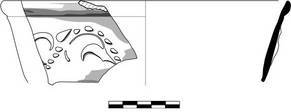
205. So-called “Mottled Orange” Sigillata
P. H. .036. Est. diam. rim .20 (1/10 preserved). Th. .005.
D20.0235:30. Three joining fragments preserve rim and floor. Deep smoothening marks exterior, two pairs of closely-spaced concentric grooves: below base where base starts, and towards rim. Orangish buff fabric (2.5YR 6/8) with orange slip faintly mottled into green; slip thicker and brighter exterior, where there is no mottling. Study collection has at least two further examples.
p. 195, n.70, fig.5.
206. “Brown Slip” Sigillata Plate Base (Early Roman)
P. H. .021. Est. diam. base .08 (<1/10 preserved). Th. .004.
K/L16/17.0427:25. Single sherd, ring foot. Fine brown (5YR 6/6 and slightly redder) fabric with rounded white (lime?) and smaller angular inclusions. Extant interior floor is slipped and varies in color from red to very dark reddish brown (10R 5/8 to 3/3). The slip is thickly applied but not very well smoothed with small bumps remaining under the slip. There are two interior concentric bands of rouletting just inside and outside the circumference of the base.
svg/K-L16-17.0427-25.jpg
207. “Brown Slip” Sigillata Deep Bowl
P. H. .062. Est. diam. rim .31 (<1/3 preserved). Th. .0089.
K/L16/17.0118:1. Single rim sherd with body to below widest part, outer rim is chipped. Compact, hard brownish-red (2.5YR 6/8, lighter towards exterior) fabric with frequent angular white inclusions and some darker. The interior is coated with thick brown (2.5YR 5/8 below carination, darker above) slip, narrow smoothing bands on the interior. Exterior is ridged below the carination so that the dark brown (2.5YR 4/3) slip is absent from wear at each ridge’s peak.
svg/K-L16-17.0118-1.jpg
208. “Brown Slip” Sigillata Bowl (Early Roman)
P. H. .087. Est. diam. rim .41 (1/10 preserved). Th. .0084.
K17.0860:3. Single large rim sherd. Light brown fabric (5YR 6/6) is compact with occasional rounded white inclusions (.004 in size) and other angular bits of similar size; there are also tiny bits visible at 10x. Thick brown slip (just lighter than 5YR 4/6) on all surfaces. Surfaces are brushed and darker where slip is thickest. As usual for the ware, there are “flattened bumps” under the interior slip, which is darkest over bumps. Two grooves on exterior wall.
209. “Brown Slip” Sigillata Deep Bowl
P. H. .0051. Th. .0089.
K/L16/17.0467:10. Single body sherd, carinated with ridges on lower section. Pink fabric (5YR 7/6), dark brown (5YR 3/2) slip varying in thickness and almost absent at peaks of ridges ridges. Bumps under slip as typical for ware.
svg/K-L16-17.0467-10.jpg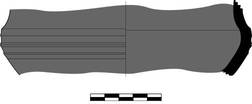
210. “Brown Slip” Sigillata Bowl (Early Roman)
P. H. .037. Est. diam. base .16 (<1/10 preserved). Th. .008.
K/L16/17.0434:2. Single base sherd. Compact, hard, well-fired light red (2.5YR 6/6) fabric with some varied tiny inclusions and occasional tiny voids. The interior surface has a “bumpy” reddish-brown slip (2.5YR 5/8 and darker) that shows the unevenness of the vessel surface. The plain exterior surface is fired to consistent light brown (7.5YR 7/6) and is quite well smoothed except for the occasional bit of excess clay or surface void. The groove and ridge that set the base off from the exterior wall are sharply defined.
svg/K-L16-17.0434-2.jpg
211. “Brown Slip” Sigillata Bowl, Recurved Handle
P. H. .051. Est. diam. rim .285 (1/20 preserved). Th. .0065.
K17.0860:42. Single rim sherd with handle. Light red (2.5YR 7/8) “regional type” fine fabric. Interior slip is unsmoothed so slightly ‘bumpy’. It is dark red-brown (5YR 3/3). The exterior is encrusted but possible a little lighter. There are ridges below the handle and the slip is distinctly thinner at the top of these.
K17.0860-42.jpg
212. Unclassified Late Hellenisti/Early Roman Red Slip Plate
P. H. .021. Est. diam. base .14 (<1/10 preserved). Th. .004.
K/L16/17.0120:19. Single base sherd with ring foot and part of sloping floor. Fine light brown (7.5YR 6/4) with very few tiny inclusions. The pattern of firing on the interior floor is distinctive,. A central area is dark red (near 10R 2.5/1). A thinner ring, presumably the trace of the base of the next vessel in the stack, is a lighter red (2.5YR 4/8), whereas the outermost preserved ring is an intermediate brown (2.5YR 4/4). None of these colors is very consistent with outermost band showing the most variability. The exterior is generally brown (2.5YR 4/4) but is lighter in patches where the slip is thinner. The underside of the ring foot is almost unslipped.
svg/K-L16-17.0120-19.jpg
213. Lesbian Sigillata(?) Portrait Bowl (later 1st Century BC to Augustan)
K/L16/17.1516. P0639. Single sherd. Thin, fugitive slip on pinkish fabric. Portrait left.
Cf. , , p. 97-98, and .
214. Lesbian Sigillata(?) Bowl Rim
H. .027. Est. diam. rim .11 (1/10 preserved). Th. .005.
K/L16/17.0427:26. Single rim sherd. Fine pale red/light brown (5YR 7/6 and redder) fabric with frequent tiny white inclusions. The now worn, thin and red (10R 5/8) slip is very thinly, but evenly, applied to all extant surfaces. Thickened, outturned rim, slight interior carination dividing wall and floor.
svg/K-L16-17.0427-26.jpg
215. Unclassified Early Roman Sigillata-like Bowl/Cup Rim
P. H. .021. Est. diam. rim .12 (1/8 preserved). Th. .0027.
K/L16/17.0467:9. Single rim sherd with short outturned triangular rim, thin wall. Exterior shows uneven bands from irregular smoothing with flat instrument, as well as a deforming bulge; interior shows uneven smoothing marks. Hard and fine pink fabric (2.5YR 7/6) with occasional miniscule white inclusions. Exterior thinly slipped, ranging in color from brown (2.5YR 4/3) to orange (2.5YR 6/8) and holding a metallic sheen in places. Interior slipped and fired to a consistent bright orange (10R 5/8). AKA “Spalling Ware”.
svg/K-L16-17.0467-9.jpg
216. Cypriot Sigillata?
D20.0010:1. SC09-3d. PH. 5.2; Th.0.7. Single wall fragment, single line of rouletting. Pinkish buff fabric mottled into brown/red.
217. Unclassified Early Roman Sigillata-like Bowl/Cup Rim
P. H. .033. Est. diam. rim .11 (1/4 preserved). Th. .003.
K/L16/17.0474:4. Single sherd, out turned rim. Compact pink (2.5YR 6/6) fabric with occasional tiny white inclusions. Thin orange-red (10R 5/8 and lighter) interior slip is unevenly applied. Exterior slip is more uneven, bare in places, and, where present, ranges from dark brown (10R 3/2) to same as interior. Rim is a short everted triangle and body is slightly carinated. AKA “Spalling ware”
svg/K-L16-17.0474-4.jpg
218. Unclassified Early Roman Red-Slip Thin-wall Cup/Jug
P. H. .031. Est. diam. rim .12 (<1/10 preserved). Th. .003.
K/L16/17.0434:26. Single rim sherd. Light red (10R 6/6) fabric with very infrequent tiny inclusions. Thick red (near 10R 4/8) not highly polished slip that shows horizontal smoothing bands near the rim. Cf. Tekkok 2001, no. 42.
svg/K-L16-17.0434-26.jpg
219. Unclassified Early Roman Red-Slip Thin-wall Cup/Jug
P. H. .018. Est. diam. rim .085 (<1/20 preserved). Th. .0035.
K/L16/17.0456:4. Single rim sherd. Compact red (2.5YR 6/6) fabric with no discernible inclusions. Deep red (2.5YR 4/6) slip is thickly applied and has obvious stick smoothing marks. Cf. Tekkok 2001, no. 42.
svg/K-L16-17.0456-4.jpg
220. Knidian Relief Ware Jug
D20.0023:17. Slightly granular orange red fabric (2.5YR 5/6) with thick matte slip.
p. 331, B485, fig.61, type b., type b.
svg/D20.0023-17.jpg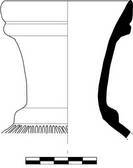
221. Knidian Relief Ware Jug
P. H. .043. Est. diam. rim .085. Th. .008.
D20.0068:4. SC28-1. Single sherd, 1/10 of shoulder. Fluted tongues on the shoulder ending with robe pattern. Pinkish/brown fabric with matt orange/red slip mottled into black.
p. 329, B484, fig.61; , pl.22a; type Ia; , Type A; Bailey 1979, Group (c).
svg/D20.0068-4.jpg
222. Knidian Oinophoros
H17.0050:7. PH. 3.7; est. D. shoulder 13; Th. 0.8. Preserving 1/20 of shoulder. Fluted tongues on the shoulder. Pinkish/brown fabric, traces of matt orange/red slip completely flaked off surface.
Heimberg 1976, Type A; Bailey 1979, Group (c); Hayes 1972, pl.22a.
svg/H17.0050-7.jpg
223. Knidian Relief Ware Jug with Silenus Face
P. H. .067. Th. .0025.
K/L16/17.0114.101. P0672. Single sherd. This fragment partially preserves the face of a bearded Silenus. The fine fabric is fired reddish brown (2.5YR 6/8) except where thickest in which case there is a faint gray (near Gley 2 – 10BG 6/1) core. There are occasional tiny light and dark inclusions and a single lime chunk, .001 across, is visible in the extant portion of the vessel. On the exterior is a white underslip over which a red slip is unevenly applied. At its darkest, in the wrinkle under the right cheek or in the moustache, the slip is near 2.5YR 5/8, elsewhere the slip ranges from bright orange to very pale as the white underslip shows through more distinctly. The interior is plain and shows the strokes by which the clay was pushed into the mold. The relief of this piece is relatively high with a maximum depth of .031 from the tip of the nose to the whiskers of the right part of the moustache. The mouth, nose and right cheek are present as well as the right side of the figure’s moustache. The right eye and the very top of the beard are only partially preserved. The line that defined the iris is extant at both points where it intersected the lower eyelid. No details of the left side beyond the mouth and part of the moustache are extant.
See P189 for similar complete cup.
224. Bowl with relief decoration, Regional
P. H. .032. Th. .008.
D20.0053:15. Single body sherd. Traces of a snake and linear decoration. Pinkish buff (5YR 6/6) limey fabric with fine silver mica.
svg/D20.0053-15.jpg
225. Roman Period Lead Glazed Skyphos (BC 50 - 10 AD)
P. H. .038. Est. diam. rim .085. Th. .0034.
K17.0860:2. Single rim sherd with beginning of horizontal handle at rim. Brownish green glaze (nearest 2.5Y 5/6). Light reddish brown (5YR 5/4) fabric. Angular lime inclusions, one as large as .004, otherwise small to tiny.
Cf. form 1.
K17.0860-2.jpg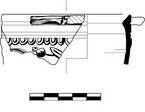
226. Sanded Ware Cup Rim (1st Century AD)
P. H. .065. Est. diam. rim .095 (<1/20 preserved). Th. .003.
K/L16/17.0461:17. Single rim to lower body preserved. Bowl with high walls, rounded towards base. Fine pink (10R 7/6) fabric, very slightly lighter and finer than K/L16/17.0467:03 but both are probably from the same source. Red slip (near 10R 4/8) on interior and exterior. Sand particles unevenly spaced below slip.
svg/K-L16-17.0461-17.jpg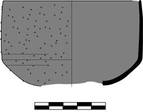
227. Sanded Ware Cup Base (Mid-first Century AD)
K/L16/17.0434:22. P.H. .011, est. D. bas. ~~.005 (>1/5 preserved), Th. floor .015. Single base sherd. Pale brown (7.5YR 6/4) fabric with small angular and elongated yellow inclusions. The exterior has applied sand under a thin brown (7.5YR 4/3) slip. The interior slip is slightly darker (7.5YR 4/4) and smoothed.
svg/K-L16-17.0434-22.jpg
228. Imported Semi-slipped Thin-Wall Cup/Jug
P. H. .05. Est. diam. rim .07 (1/8 preserved). Th. .0027.
K/L16/17.0146:7. Single rim sherd with upper body and just a hint of one handle stub preserved. Fine light brown (5YR 6/6) fabric with frequent small lime and varied darker bits, occasional large silver mica flakes. The wash is thin, and dripping down the interior. Exterior slip color is red (10R 5/8).
svg/K-L16-17.0146-7.jpg
229. Beaker, thin walled.
D20.0294:8. PH.ADD est. D. 8; Th. 0.3. Preserving ¼ of rim. Three mended fragments. Globular body, everted banded rim. Stretching marks on surface. Pinkish buff fabric (2.5YR 6/6), brown slip exterior, red interior.
svg/D20.0294-8.jpg
230. Cup, thin walled. Regional. Moevs Form 50 Type
D20.0294:9. ADD PH. est. D. 8.8; base3.6;Th. 0.3. Preserving ¼ of rim with wall. Unjoining rim and wall joined in drawing. Ten mended fragments. Globular body, everted banded rim, base sits flat. Pinkish buff fabric (2.5YR 5/4) fine silver mica on surface.
svg/D20.0294-9.jpg
231. Cup, thin walled. Regional. Moevs Form 50 Type.
D20.0294:5. PH.ADD est. D. 8; base 3.5; Th. 0.3. Preserving ¼ of rim, handle with wall. Unjoining rim and wall joined in drawing. Seven mended fragments. Globular body, everted banded rim, base sits flat. Brown fabric fired gray at surface, stacking mark on wall.
232. Unclassified/Regional Thin-wall Cup/Jug
P. H. .063. Est. diam. rim .07 (<1/20 preserved). Th. .0015.
K/L16/17.0120:10. Single sherd with rim and handle. Fine reddish brown (10R 5/8) fabric with occasional angular white inclusions. Surface weak red/gray (near 2.5YR 5/3). From a first century AD pit.
Near , nos. 50 and 51.
svg/K-L16-17.0120-10.jpg
233. Unclassified Thin-wall Cup Rim and Handle, Gray on Orange
P. H. .075. Est. diam. rim .13 (1/8 preserved). Th. .0025.
K/L16/17.0434:10. Single sherd with rim and handle. Red (2.5YR 6/8) fabric with occasional sub-angular light and dark inclusions, as well as some tiny bits. Fired evenly except for thin gray core in thickest part of rim. Interior is same color as fabric. Exterior surfaces fired to reddish gray (near 2.5YR 5/2). Strap handle is .017 in width. Found in late 1st/early 2nd century AD fill.
svg/K-L16-17.0434-10.jpg
234. Unclassified/Regional Thin-wall Cup/Jug Rim, Gray Band on Red
P. H. .024. Est. diam. rim .08 (1/10 preserved). Th. .0015.
K/L16/17.0461:29. Single rim sherd with handle stump and upper wall. Outturned rim with single ridge on exterior face. Slightly gritty, brown fabric (2.5YR 5/8) with frequent tiny white inclusions. Core of handle is gray. Exterior surface gray, interior same as fabric.
svg/K-L16-17.0461-29.jpg
235. Regional Thin-wall Cup/Jug Rim
P. H. .035. Est. diam. rim .08 (1/5 preserved). Th. .002.
K/L16/17.0114:38. Single rim sherd with handle stump preserved. Orange red (2.5YR 6/8) fabric with angular light inclusions. Exterior gray, interior plain.
svg/K-L16-17.0114-38.jpg
236. Regional Thin-wall Cup/Jug Rim
P. H. .017. Est. diam. rim .08 (1/6 preserved). Th. .005.
K/L16/17.0112:14. Single rim sherd. Red (2.5YR 6/8) fabric, white inclusions, outer surface gray Collar under rim.
svg/K-L16-17.0112-14.jpg
237. Beaker. Regional (2nd to 3rd Century AD)
D20.0209:6. PH. 3.6; est. D.rim 8; Th. 0.3. Preserving 1/4 of rim. Shallow ridges exterior of wall. Gritty gray fabric with fine silver mica and lime.
Stobi also Ephesus Severan
svg/D20.0209-6.jpg
238. Cup, thin walled. Regional (3rd Century AD)
H17.0763:16. PH. 3.6; est. D.rim 8.0; Th. 0.3. Preserving 1/4 of rim with wall. Pinkish red fabric with gray exterior surface.
Tekkok 2001, 365, n.144, pls.6,22; Hayes 1983, n.124, fig.6.
svg/H17.0763-16.jpg
239. Thin-wall Cup, Regional (3rd Century AD)
H17.0737:8. PH. 6.3; est. D.rim 6.0; Th. 0.4. Preserving 1/4 of wall and rim. Fired gray core fired pinkish buff.
svg/H17.0737-8.jpg
240. Beaker, thin walled. Regional (3rd Century AD)
H17.0748:14. H. 2.7; est. D. base 3.5; Th. 0.4. Hollow base with a knob. Pinkish red fabric with gray surface.
Slane 1986
241. Thracian(?) Thin Walled Jug/Cup Rim (3rd century AD)
P. H. .044. Est. diam. rim .07 (1/4 preserved). Th. .0015.
K17.0777:17. Rim sherd and one joining body fragment, modern break. Fine red (2.5YR 5/6) fabric with occasional lime chunks visible on surfaces. The exterior surface is fired weak red (2.5YR 5/2), the interior is plain. The exterior partially preserves two readable letters written in thin white paint: πε. A third, at the right, is extant only as a partially preserved vertical stroke. The neck has only a slight offset above the turn from wall to rim.
Cf. no. 19, for painted cup dated to 3rd century; this piece is said to be Italian on the basis of fabric. A complete vessel of this type is illustrated at , p. 71.
svg/K17.0777-17.jpg
242. Thracian(?) Thin Walled Jug/Cup Rim (3rd century AD)
P. H. .038. Est. diam. rim .066 (1/3 preserved). Th. .0015.
K17.0777:18. Single rim sherd. Unevenly fired fabric with red (2.5YR 5/6) core and frequent small light inclusions and occasional large chunks of lime, one of which would have been visible on both interior and interior but is now dislodged. Coated interior and exterior surfaces are fired weak red (2.5YR 5/3). The normal offset above the turn from wall to rim is here a low band just at the base of the neck. A single row of partially preserved crossing brushstrokes formed part of a encircling band of hatching.
Cf. no. 19, for painted cup with diamond pattern dated to 3rd century; this piece is said to be Italian on the basis of fabric. A complete vessel of this type is illustrated at , p. 71. Similar decoration on LRB 11a, which is said to be Attic.
svg/K17.0777-18.jpg
243. Jug or mug with dipinto, Northern Aegean
P. H. .067. Est. diam. rim .14 (1/12 preserved). Th. .
D20.0023.002. P0495. Red fabric (10R 5/6) with brown surface (2.5YR 5/4) hard fired, thin walled fabric with silver mica inclusions. Painted decoration in four extant rows: top row of 'fishbone' to right/].ΟΡ/].ΤΑϹ/]...[. The lineation is not clear for the last line. A vertical stroke separates the letters from the handle stub.
svg/P0495.jpg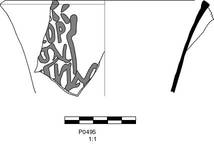
244. Thracian(?) Thin Walled Jug/Cup Rim (3rd century AD)
D20.0093:9. Single rim sherd. Unevenly fired fabric with red (2.5YR 5/6) core and frequent small light inclusions and occasional large chunks of lime, one of which would have been visible on both interior and interior but is now dislodged. Coated interior and exterior surfaces are fired weak red (2.5YR 5/3). Slight offset between rim and body. Two spirals or sets of concentric circles in thin white paint are partially preserved; horizontal line above.
245. Beaker, thin walled. Regional (3rd Century AD)
D20.0366:12. PH.4.2; est. D.rim 7; Th. 0.3. Preserving 1/6 of rim with wall. Everted rim. Hatched decoration in white slip. Pinkish buff fine fabric with thick red slip.
svg/D20.0366-12.jpg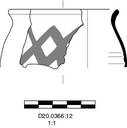
246. Thin-walled Strainer
H17.0692.001. P0165. To come.
247. Unclassified/Regional Thin-wall Cup/Jug Base
P. H. .029. Est. diam. base .036 (complete preserved). Th. .0025.
K/L16/17.0417:11. Single sherd with complete base. The fine fabric is unevenly fired to brown (2.5YR 5/6 and browner) with frequent small white inclusions and occasional mica on surface. The surface near the base is dirty brown (2.5YR 5/4) with the beginnings of a “gray zone” starting at .018 above the bottom of the vessel. This part is fired very weak red-brown (2.5YR 5/2). A band of .0045 high white dots, of which 7 are at least partially preserved, separates the lower lighter colored area from the higher, darker one.
Dotted decoration is well-known on thin-walled vessels. Cf. fig. 4.7m and plate 40j. Cf. FiE VIII/6 K749
svg/K-L16-17.0417-11.jpg
248. Thin Walled Jug Rim and Handle (3rd Century AD?)
P. H. .056. Est. diam. rim .08 (<1/10 preserved). Th. 0.25.
K17.0867:1. Single sherd with rim and handle. Light brown (5YR 5/6), soft, slightly granular fabric with rounded lime and other dark inclusions, as well as gold mica flakes in the fabric and on the surface. The surface is otherwise plain. Very distinct from the standard regional fabric.
K17.0867-1.jpg
249. Unclassified Thin-Wall Cup/Jug
K/L16/17.0398. P0640. String marks under the base. Lines on surface. Dark orange fabric between 5 yr 4/4 and 5/4. Gold and silver mica, with occasional black stones less than 0.005m and lumps of clay.
svg/P0640.jpg
250. Unclassified Thin-wall Cup/Jug, Orange over Gray Core
K/L16/17.0434:5. P.H. .014, est. D. bas. .036 (1/2 preserved), Th. .002. Single base sherd. Hard gray (Gley 1 – N 3/) fabric with frequent tiny light inclusions visible against the dark background. The unsmoothed interior and smoothed exterior surfaces are fired reddish-brown (2.5YR 5/6).
svg/K-L16-17.0434-5.jpg
251. Unclassified Thin-wall Cup/Jug Base, Imported Gray over Orange
P. H. .016. Est. diam. base .036 (complete preserved). Th. .0015.
K/L16/17.0427:28. Single base sherd. Compact and hard, brown (2.5YR 6/8) fabric with tiny light inclusions just visible to the eye. Interior surface plain. Extant exterior surface fired dark gray (Gley 1 – N 3/), a distinguishing feature of the piece is that this gray layer is extremely thin (essentially unmeasurable). There is a distinct swirl at the base of the interior. This vessel is distinct from the usual ER banded "gray-band-on-red" thin-walled cups.
svg/K-L16-17.0427-28.jpg
252. Unclassified/Regional Thin-wall Cup/Jug Base, Gray Band on Red
P. H. .005. Est. diam. base .05 (1/3 preserved). Th. .0021.
K/L16/17.0427:43. Single base sherd. Brown (10R 5/8) fabric with frequent white inclusions. Surfaces plain but with darker red (10R 5/4) upper band.
svg/K-L16-17.0427-43.jpg
253. Unclassified Thin-wall Cup/Jug
P. H. .022. Est. diam. base .036 (completely preserved). Th. .002.
K/L16/17.0434:8. Single base sherd. The dark gray (7.5YR 4/1) fabric has frequent tiny white inclusions and occasional larger angular ones up to .001 in length. The exterior surface is fired dull red (10R 5/4) whereas the interior is brighter (10R 5/6). A gray zone begins .015 from the bottom of the vessel. While not overly distinct from the Regional Gray on Red variety of this form, this vessel is sufficiently different to warrant the caution of leaving it unclassified.
svg/K-L16-17.0434-8.jpg
254. Unclassified Thin-wall Cup/Jug, Orange with Plain Surfaces
P. H. .008. Est. diam. base .036 (completely preserved). Th. .0014.
K/L16/17.0434:19. Single base sherd. Compact, hard cleanly-fired red (2.5YR 5/8) fabric with no visible inclusions. Surfaces plain, some scratches on interior. Exterior base is sharply defined from floor. Broad smoothing spiral on interior base, some scratches on exterior. Distinct from regional products by construction of base and extreme thinness.
svg/K-L16-17.0434-19.jpg
255. Unclassified/Regional Thin-wall Cup/Jug Rim, Gray-on-Orange
P. H. .029. Est. diam. base .08 (2/3 preserved). Th. .0028.
K/L16/17.0461:10. Single base sherd with rounded lower wall. Slightly gritty, hard reddish brown (2.5YR 5/6) fabric with frequent angular white and darker inclusions, golden mica visible on surface. Unslipped. Surface shows distinct smoothing bands and scratches.
svg/K-L16-17.0461-10.jpg
256. Unclassified/Regional Thin-wall Cup/Jug Base, Gray-on-Orange
P. H. .022. Est. diam. base .06 (1/4 preserved). Th. .004.
K/L16/17.0461:12. Single sherd of base and lower wall. Slightly gritty, hard fabric fired gray at core, brown (2.5YR 5/6) at surface, frequent angular white bits, golden mica visible on surface. Surface plain. Similar fabric and surface to K/L17/0461:10.
svg/K-L16-17.0461-12.jpg
257. Unclassified/Regional Thin-wall Cup/Jug Base, Gray-on-Orange
P. H. .046. Est. diam. base .058 (1/5 preserved). Th. .0014.
K/L16/17.0461:28. Single sherd preserving wall to upper body. Base is sharply defined. Compact reddish brown fabric (10R 5/8) with tiny white inclusions, very little mica. Lower part of body is indistinguishable from fabric, upper part fired gray. Exterior surface shows distinct smoothing bands and scratches.
svg/K-L16-17.0461-28.jpg
258. Unclassified/Regional Thin-wall Cup/Jug Base, Gray-on-Orange
K/L16/17.0114:39. P.H. .037, D. bas. ~.034 (completely preserved), Th. wall .003. Two joining base sherds with wall just past widest point. Orange red fabric (2.5YR 4/6) with few tiny inclusions. “Gray zone” begins .014 from bottom of vessel. Base is near circular but slightly irregular.
svg/K-L16-17.0114-39.jpg
259. Unclassified Thin-wall Cup/Jug Base, Gray-on-Orange
P. H. .035. Est. diam. base .04 (2/5 preserved). Th. .002.
K/L16/17.0112:5. Single base sherd. The slightly granular red (10R 5/8) fabric has been discolored towards the interior surface and is now dark brown. The exterior is heavily encrusted but seems to be the normal gray on top of red combination. The gray zone is .018 above the bottom of the vessel. Five small iron “chunks” stuck on interior surface.
svg/K-L16-17.0112-5.jpg
260. Jug Base (Late Roman?)
P. H. .052. Est. diam. base .0332 (completely preserved preserved). Th. .0018.
M18.0478:3. Single sherd, base and wall to widest diameter. Evenly fired light red (2.5YR 6/8) fabric with occasional lime chunks (some on visible on surfaces) and only tiny light and dark inclusions best visible at 10X magnification in addition to the chunks. Exterior surface is coated light reddish brown (around 2.5YR 6/4) with distinct spiral tooled before coating. Interior is plain.
M18.0478-3.jpg
261. Jug with graffiti. Local (4th Century AD)
H17.0069:6. PH. 5.2; Th. 0.8. Hole 2.6 on shoulder. Pinkish brown (10R 5/6) granular fabric with lime, gray stones fine silver mica, fired pale buff on surface.
262. Beaker, regional (4th Century AD)
H17.1182:3. PH. 4; est. D.rim 6; Th. 0.6. Preserving 1/8 of rim. Deep wheel ridgings exterior of wall. Brown fabric (10R 4/4) with self slip.
svg/H17.1182-3.jpg
263. Bowl, local (5th Century)
H17.0032:23. PH. 2.2; est. D.rim 30; Th. 0.6. Preserving 1/10 of rim. Brown granular fabric with matte red slip gold mica on surface.
svg/H17.0032-23.jpg
264. African Red Slip Ware Hayes Form 32 (4th Century AD)
H17.0737:8. PH. 2.3; est. D.rim 19; Th. 0.5. Preserving 1/20 of rim. Pinkish buff fabric with matte pink red fabric (10R5/6 and 5/8). CHECK NUMBER, it's the same as a regional cup.
265. African Red Slip Hayes Form 32/58 (4th Century)
P. H. .036. Est. diam. rim .23 (1/4 preserved). Th. .0038.
H17.0053:7. Single sherd preserved profile. Compact orange fabric, few inclusions. Interior encrusted but well-slipped; exterior slipped, brush marks. TO BE DRAWN.
266. African Red-Slip Hayes Form 45a Rim (230-320)
Est. diam. rim .32 (1/20 preserved). Th. .0028.
K/L16/17.0084:1. Single, rim sherd. Compact, hard, well-fired light-red (near 2.5YR 6/6) fabric with only tiny inclusions. Thick bright reddish-orange (just redder than 2.5YR 5/8) slip on all surfaces. Single row of rouletting extant on upper surface of rim, with single incision just inside of outer edge. [[drawing sheet needs to be scanned and traced]]
For form see p. 62.
267. African Red-Slip Hayes Form 45a Rim (230-320)
Est. diam. rim near .30 (<1/20 preserved). Th. .004.
K/L16/17.0417:8. Single, small rim sherd. Compact, hard, well-fired light-red (near 2.5YR 6/6) fabric with only tiny inclusions. Thick bright reddish-orange (just redder than 2.5YR 5/8) slip on all surfaces. Single row of rouletting extant on upper surface of rim, with single incision just inside of outer edge. Body sherd K/L16-17.0417:9 is identical in details of fabric and surface treatment.
For form see p. 62.
svg/K-L16-17.0417-8.jpg
268. African Red-Slip Hayes Form 45a Base (230-320)
P. H. .007. Est. diam. base .11 (<1/20 preserved). Th. .003.
K/L16/17.0417:5. Small base sherd. Slightly granular fabric, sherd discolored by burning. A band of rouletting is partially preserved on the interior just inside the circumference of the base.
For form see p. 62.
svg/K-L16-17.0417-5.jpg
269. African Red-Slip Hayes Form 45a Base (230-320)
P. H. .008. Est. diam. base .11 (<1/10 preserved). Th. .0035.
K/L16/17.0417:6. Small base sherd. Slightly granular fabric. Thick slip on all extant surfaces.
For form see p. 62.
svg/K-L16-17.0417-6.jpg
270. African Red-Slip Hayes 50a Rim (AD 230-320)
Th. .004.
K/L16/17.0100:17. Single rim sherd. Red (10R 5/8) fabric with no visible inclusions. Slip slightly redder than fabric. This sherd was recovered in third century pits and represents the first phase of ARS imports at Ilion.
For form see p. 69.
svg/K-L16-17.0100-17.jpg
271. African Red-Slip Hayes 50a late Profile (AD 300-360)
P. H. .047. Est. diam. rim .28 (1/20 preserved). Est. diam. base .185 (about 1/8 preserved). Th. .006.
D20.0183:15. Single sherd, profile. Pinkish red fabric with matte red slip, exterior thin slip.
svg/D20.0183-15.jpg
272. African Red Slip, Hayes Form 50A (230-350)
H17.0049:1. PH. 1.8; est. D.rim 28; Th. 0.5. Preserving 1/20 of rim. Pinkish buff compact fabric, as for ware.
273. African Red Slip Hayes Form 50 (230 - 350 AD)
H17.0069:3. PH. 2.5; est. D.rim 26; Th. 0.5. Preserving 1/20 of rim. Pinkish fabric hard fired, matte red slip.
274. African Red-Slip Hayes 50 Type Base (AD 230-320)
P. H. .045. Th. .0025.
K17.0845:7. Single sherd with initiation of vestigial base. Compact orange (near 10R 6/8) fabric with occasional small, light inclusions. Slip is slightly darker on interior.
svg/K17.0845-7.jpg
275. African Red-Slip Hayes 53 Rim (AD 320-450)
P. H. .021. Est. diam. rim .19 (1/10 preserved). Th. .0025.
M18.0192:6. SC13-3h. Single rim sherd. Red (btw. 2.5YR 5/6 and 6/6) fabric is compact with essentially no inclusions. The unpolished slip is very close in color to the fabric. Slip is distinctly thinner on the extant exterior. There are three closely spaced interior grooves.
For discussion of this form see . See also p. 78.
svg/M18.0192-6.jpg
276. African Red-Slip Hayes 53 Rim (AD 320-450)
P. H. .022. Est. diam. rim .20 (1/20 preserved). Th. .0025.
I17.0647:3. Single rim sherd. Reddish-brown fabric (near 2.5YR 5/8) with occasional tiny lime inclusions. Surface is slightly lighter than fabric. Brushed on interior, near plain on exterior. There are two closely spaced grooves on the interior.
I17.0647-3.jpg
277. African Red Slip Ware, Hayes Form 53 (4th to 5th Century)
H17.0049:3. PH. 26; est. D.rim 20; Th. 0.5. Preserving 1/20 of rim. Pinkish fine granular fabric with matte red slip.
278. African Red-Slip Hayes 53 Rim (AD 230/40 - 300)
P. H. .052. Est. diam. rim .34 (1/10 preserved). Th. .006.
D20.0183:5. Single ridge exterior of rim. Pinkish red fabric, thin orange slip.
279. African Red-Slip Hayes 58 Rim (AD 290-375)
P. H. .042. Est. diam. rim .34 (1/4 preserved). Th. .0052.
K17.0752:1. P0537. Five joining sherds preserving profile past vestigal foot. Orange-red (near 10R 6/8), visibly granular fabric with occasional angular, light inclusions. All extant surfaces slipped and fired slightly darker. Very lightly smoothed. Two light grooves on upper rim.
svg/K17.0752-1.jpg
280. African Red-Slip Hayes 59 Rim (AD 320-420)
P. H. .0026. Est. diam. rim .25 (1/24 preserved). Th. .005.
M18.0099:6. Single rim sherd. Orange-red (near 10R 6/8) visibly granular fabric with angular light inclusions. All extant surfaces slipped and fired slightly darker.
For form see p. 96.
svg/M18.0099-6.jpg
281. African Red-Slip Hayes Form 60 Rim (4th Century AD)
P. H. .032. Est. diam. rim .35. Th. .007.
H17.0050:3. Single sherd with rim and part of floor. Compact fabric, thin smooth slip interior and partially on exterior.
For form see p. 100.Cf. no. 128.
H17.0050-3.jpg
282. African Red-Slip Hayes Form 61a Rim
Est. diam. rim .20 (1/12 preserved).
A29.0020:4. SC13-3o. Single rim sherd.
For form see p. 100.
svg/A29.0020-4.jpg
283. African Red Slip Ware, Hayes Form 61a/b (Ca. 400 AD)
H17.0050:8. PH. 3.6; est. D.rim 28; Th. 0.5. Fine bright pink fabric thin smooth slip interior and exterior.
Minimal incurve and slight hook indicate development from subtype a to b, so a date near 400 is likely.
svg/H17.0050-8.jpg
284. African Red Slip Ware Hayes Form 62B?
H17.1165:6. PH. 2; Th. 0.5. Preserving stamp. Circles with toothed fringe, Style C. Pinkish red fabric with shiny orange/red slip.
285. African Red-Slip Hayes 67 Rim (AD 360-470)
P. H. .018. Est. diam. rim .19 (1/12 preserved). Th. .0039.
M18.0099:2. Single rim sherd. Visibly granular fabric with tiny white inclusions and some lime exploding on surfaces. Thick smoothed slip on interior, thin under rim, and plain onto lower wall. Shallow incised line just inside of upper rim.
For form see p. 112.
svg/M18.0099-2.jpg
286. African Red-Slip Hayes 68 Rim (after AD 425)
P. H. .037. Est. diam. rim near .30 (1/20 preserved). Th. .0039.
I17.0754:2. Single rim sherd. Fine reddish-brown (near 2.5YR 6/6) fabric with occasional sub-angular calcareous inclusions. The interior darker red (near 10R 5/6) slip shows narrow, .002, stick smoothing marks whereas the exterior is brushed and slightly rough. Upper faces of rim are distinctly separated. Light groove at outermost edge.
For form see p. 116.
svg/I17.0754-2.jpg
287. African Red-Slip Hayes form 71 Rim (AD 375-450)
P. H. .052. Est. diam. rim .20 (1/10 preserved). Th. .002.
M18.0099:1. Two joining rim sherds with upper wall. Compact red (2.5 YR 6/8) fabric with only occasional tiny light inclusions and very small voids. Slightly darker slip on interior and over rim. Drip marks on exterior.
M18.0099-1.jpg
288. African Red Slip Ware, Hayes Form 69-75? (Fifth Century AD)
H17.0036:2. PH. 2.9; est. D.rim 17; Th. 0.7. Preserving 1/10 of rim. Pinkish red fabric with thin slip interior and exterior.
svg/H17.0036-2.jpg
289. African Red Slip Ware, Cf. Hayes Form 72-75 (4th Century AD)
H17.0730:4. PH. 1.6; est. D.rim 20; Th. 0.5. Preserving 1/10 of rim. Pinkish buff hard fabric matte pinkish red slip (2.5YR 5/6).
290. African Red-Slip Hayes 74 Rim (AD 450 to 475)
P. H. .023. Est. diam. rim near .12 (1/4 preserved). Th. .004.
I17.0532:4. Single rim sherd. Bright reddish-brown (10R 6/8) fabric with occasional lime inclusions. Same color interior slip is thick and bright. The wall of the vessel is smoothed whereas the upper face of the rim shows overlapping stick smoothing marks. These continue to the outer face of the rim where they become the distinct ridges that are one indication of the form. The exterior is plain except for drip marks.
For form see p. 124.
I17.0532-4.jpg
291. African Red-Slip Hayes Form 87b Rim (Late 5th to Early 6th Century AD)
H. .063. Est. diam. rim .44.
P18.0093:1. Almost completely preserved plate, twenty-six joining sherds leave two gaps and missing sections at rim and base. There is some chipping of the interior surface, though in general the slip is very well preserved; patches of plaster adhere to the interior of one group of joining sherds, to exterior of another (see photographs). Vessel has been conserved.Broad sloping walls with thickened rim and short triangular foot. Slightly granular fabric, fired red throughout (btw. 2.5YR 6/8-5/8) with occasional lime inclusions and some reddish bits. Smooth slip on interior surface is slightly darker red (10R 5/8), drip marks over rim, exterior largely plain.From deposits associated with the aftermath of the early sixth century AD earthquake.
For form see p. 135.
svg/P18.0093-1.jpg
292. African Red-Slip Hayes 87b Rim (Late 5th to Early 6th Century AD)
P. H. .019. Est. diam. rim perhaps .35.
P18.0061:1. Single rim sherd. Slightly granular fabric, fired red (10R 5/8) with some lime. Smooth slip is slightly darker red (10R 5/6) on all extant surfaces.
293. African Red-Slip Hayes 87c Rim (Late 5th to 6th Century AD)
P. H. .0095. Est. diam. rim not recoverable.
K17.0068:34. SC13-3q. Single small sherd. Hooked profile under rim. Granular dark red fabric with bright orange slip.
For form see p. 135.
K17.0068-34.jpg
294. African Red-Slip Hayes 91d Rim (late 6th through 7th century AD)
P. H. .02. Est. diam. rim .15 (1/10 preserved). Th. .0045.
u14.0001:1. Slightly granular fabric with lime inclusions, orange (2.5YR 5/8). This is very late ARS. The thick polished orange (off munsell, too orange for 2.5YR) slip is now very worn. The flange is somewhat unusual, being sharply tooled underneath so that it has a round profile. The upper rim is also slightly everted.
For form see p. 140. The profile is similar to type 54 (= Hayes 91d), p. 179, which is dated to the seventh century.
svg/u14.0001-1.jpg
295. African Red-Slip Hayes 104c(?) Base (Sixth Century AD)
P. H. .014. Th. .0052.
P18.0001:1. Single sherd, low foot. Slightly granular fabric with lime inclusions, orange (2.5YR 5/8).
For form see p. 160 and fig. 30.23.
296. African Red Slip Ware (Fifth Century AD)
D20.0235:13. PH. 1.3; est D.rim 30; Th. 0.7. Preserving less than 1/20 of rim. Pinkish buff porous fabric with thick red slip. (2.5YR 5/8)
297. Phocaean Red-Slip, Cf. Zelle (2000) "Schüssel Form B" (Late 4th Century AD?)
P. H. .021. Est. diam. rim .25 (1/12 preserved). Th. .0041.
K18.0032:27. The slightly granular red (2.5YR 6/8) fabric has lime inclusions, with two large lime chunks near surface The slip is quite thick and bright (slightly darker than 2.5YR 6/8). The outer face of the rim is darker.
While there is some overlap with the later Hayes 6 (, p. 341 and fig. 70.2), a closer comparison is with an unclassified bowl from Assos cataloged as "Schüssel Form B" (, p. 99); the date of this form is tentatively given as later 4th century.
K18.0032-27.jpg
298. Phocaean Red-Slip, Cf. Zelle (2000) "Schüssel Form B" (Late 4th Century AD?)
P. H. .044. Est. diam. rim .25 (1/10 preserved). Th. .0035.
N18.0020:1. Single rim sherd. Fabric fired to light red (10R 6/6) with frequent calcareous inclusions. Surface coated on all surfaces, brushed smooth, and fired to just darker than fabric (10R 5/6). Elongated voids
While there is some overlap with the later Hayes 6 (, p. 341 and fig. 70.2), a closer comparison is with an unclassified bowl from Assos cataloged as "Schüssel Form B" (, p. 99); the date of this form is tentatively given as later 4th century.
N18.0020-1.jpg
299. Phocaean Red-Slip Hayes Form 1a Rim (late 4th to early 5th century AD)
P. H. .029. Est. diam. rim .12. Th. .003.
I17.0647:4. Single sherd. Fine light red (2.5YR 6/6) fabric with occasional tiny lime inclusions and small elongated gaps. Worn surface is darker (10R 5/6) with thin slip. The slip is thinner and a touch darker above the carination.
Cf. , p. 325 and fig. 65.1-2.
svg/I17.0647-4.jpg
300. Phocaean Red-Slip Hayes Form 1a Rim (late 4th to early 5th century AD)
P. H. .036. Est. diam. rim .16. Th. .004.
I17.0647:5. Single sherd. Light red (2.5YR 6/8) fabric with small lime inclusions, occasional darker bits. Surface is mostly lighter red (10R 5/6) but darker above the carination. Light scratches on lower exterior wall.
Cf. , p. 325 and fig. 65.1-2.
I17.0647-5.jpg
301. Phocaean Red Slip Ware Hayes Form 1a
P. H. .027. Est. diam. rim .10 (1/6 preserved). Th. .005.
C/D20/21.0413:21. Deep ridging interior of the rim. Pinkish buff fabric with orange/red slip.
svg/C-D20-21.0413-21.jpg
302. Phocaean Red-Slip Hayes Form 1 Rim (late 4th to early 5th century AD)
P. H. .037. Est. diam. rim .21. Th. .0044.
M18.0099:15. Single sherd, broad rim with flat upper face. Red fabric with occasional sub-angular lime (.003), rare mica, and other tiny bits. Surface slip is fired to essentially the same color as fabric with only slight discoloration on outer rim from stacking.
Cf. , p. 325 and fig 65.
svg/M18.0099-15.jpg
303. Phocaean Red Slip Hayes Form 1 (late 4th cenutery)
K17.0468:1. Two joining sherds, modern break.
svg/K17.0468-1.jpg
304. Phocaean Red Slip Ware Hayes Form 1
P. H. .031. Est. diam. rim 24 (1/20 preserved). Th. .005.
H17.1165:4. Pinkish buff fabric with matte red slip.
svg/H17.1165-4.jpg
305. Phocaean Red Slip Ware, Hayes Form 1a (425 AD)
P. H. .027. Est. diam. rim .26 (1/10 preserved). Th. .007.
H17.0045:4. Deep turning marks exterior of wall. Pinkish buff fabric, matte red slip.
svg/H17.0045-4.jpg
306. Phocaean Red Slip Ware, Hayes Form 1 (425-250)
P. H. .043. Est. diam. rim .24 (1/8 preserved). Th. .006.
H17.0032:1. Deep turning marks interior of rim. Pinkish red fabric with thick red slip.
svg/H17.0032-1.jpg
307. Phocaean Red-Slip Hayes Form 1 Rim (late 4th to early 5th century AD)
P. H. .037. Est. diam. rim .17. Th. .0035.
I17.0829:1. Single sherd. Fine light red (10R 6/6/) fabric with frequent small and tiny lime inclusions. There is a single extant chuck of lime, .0035 in diameter, exploding on the outer surface. Thin red and unsmoothed (10R 5/8) slip on all surfaces, except outer face of rim where darker (10R 4/2 to 5/3) from stacking. Slight carination on outer face.
Cf. , p. 325 and fig. 65.3.
I17.0829-1.jpg
308. Phocaean Red Slip Ware Hayes Form 1 (425 - 450 AD)
P. H. .024. Est. diam. rim .19 (1/20 preserved). Th. .007.
D20.0010:4. Pinkish buff fabric, core orange slipped exterior.
svg/D20.0010-4.jpg
309. Phocaean Red Slip Ware, Hayes Form 1a, transitional (375-400)
P. H. .03. Est. diam. rim .20. Th. .005.
H17.0050:5. Pinkish buff fabric, thin red slip fired black exterior of rim.
svg/H17.0050-5.jpg
310. Phocaean Red Slip Ware, Hayes Form 1a (425 AD)
P. H. .045. Est. diam. rim .30 (1/8 preserved). Th. .006.
H17.0050:6. Pinkish buff fabric thin red slip in and around rim.
svg/H17.0050-6.jpg
311. Phocaean Red-Slip Hayes 1d Profile (last quarter 5th century)
P. H. .0425. Est. diam. rim .17 (1/5 preserved). Th. .0052.
M18.0045:4. SC12-2a. Four joining sherds preserve wall profile. Dark band under rim from uneven stacking in kiln.
svg/M18.0045-4.jpg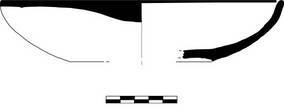
312. Phocaean Red Slip Ware Hayes Form 1d (400-425)
P. H. .032. Est. diam. rim .20 (1/20 preserved). Th. .006.
D20.0183:13. Single sherd. Pinkish buff with matte orange/red slip flaked off the surface.
svg/D20.0183-13.jpg
313. Phocaean Red Slip Ware Hayes Form 1
P. H. .033. Est. diam. rim .16 (1/4 preserved). Th. .005.
H17.1175:1. Pinkish buff fabric with matte red slip.
svg/H17.1175-1.jpg
314. Phocaean Red Slip Hayes Form 1 transitional (End of 4th to 5th Century AD)
P. H. .013. Est. diam. base .12 (1/6 preserved). Th. .005.
H17.0696:1. Pinkish buff fabric with matte slip on surface.
svg/H17.0696-1.jpg
315. Phocaean Red-Slip Hayes Form 1a Base (late 4th to early 5th century AD)
P. H. .028. Est. diam. base .05 (1/5 preserved). Th. .004.
I17.0647:6. Single base sherd. Fine light red (2.5YR 6/8) fabric with occasional tiny lime inclusions. Interior surface is worn away. Exterior is variable but mostly dull red (10R 5/6). Exterior has frequent scratches.
Cf. , p. 325 and fig. 65.1.
I17.0647-6.jpg
316. Phocaean Red-Slip Base, cf. Form 1
P. H. .035. Est. diam. base .11 (1/5 preserved). Th. .0045.
K17.0752:7. Single base sherd. Fabric is light red (2.5YR 6/8) without excessive lime. Matte surface is red (10R 5/8).
Cf. , p. 325 and fig. 65.2.
K17.0752-7.jpg
317. Phocaean Red Slip Ware, Hayes Form 1d (AD 425)
P. H. .027. Est. diam. base .058 (complete preserved). Th. .005.
H17.0032:10. Pinkish red fabric with matte red slip.
svg/H17.0032-10.jpg
318. Phocaean Red Slip Ware, Hayes Form 1 (425-450 AD)
P. H. .034. Est. diam. base .15 (1/4 preserved). Th. .006.
H17.0032:13. Pinkish red fabric with red matte slip.
svg/H17.0032-13.jpg
319. Phocaean Red Slip Ware, Hayes Form 2 (AD 425-450)
P. H. .03. Est. diam. rim .32 (1/20 preserved). Th. .006.
H17.0032:5. Bright pink fabric (2.5YR 6/8), matte thick red slip on surface.
svg/H17.0032-5.jpg
320. Phocaean Red Slip Ware, Hayes Form 2a (400-425)
P. H. .03. Est. diam. rim .37 (1/8 preserved). Th. .004.
H17.0036:5. Pinkish buff fabric with matte thin red slip fired black on rim.
svg/H17.0036-5.jpg
321. Phocaean Red Slip Ware Hayes Form 2a
P. H. .28. Est. diam. rim .28 (1/10 preserved). Th. .006.
H17.1175:2. Orangish buff fabric with matte red slip.
svg/H17.1175-2.jpg
322. Phocaean Red-Slip Hayes Form 2a Rim
P. H. .05. Est. diam. rim .30. Th. .005.
I17.0647:1. Fine light red (10R 6/8) fabric with very frequent lime inclusions up to .0025 in diameter but mostly smaller. Surface is mostly light red (10R 5/8) but darker near outer edge of rim and on lower face.
Cf. , p. 327 and fig 66.1.
svg/I17.0647-1.jpg
323. Phocaean Red Slip Ware Hayes Form 2a
P. H. .057. Est. diam. rim .34 (1/6 preserved). Th. .007.
H17.0050:4. Deep turning marks on exterior. Pinkish buff fine fabric with thin smooth red slip thicker interior.
svg/H17.0050-4.jpg
324. Phocaean Red Slip Ware Hayes Form 2 (425-450)
P. H. .025. Est. diam. rim .18 (less than 1/6 of wall preserved preserved). Th. .006.
C/D20/21.0413:20. Preserving less than 1/6 of wall, broken on rim. Pink fabric with red slip.
Kenrick 1982, B688.15, fig.71.
svg/C-D20-21.0413-20.jpg
325. Phocaean Red Slip Ware Hayes Form 2 (460-475)
P. H. .022. Est. diam. rim .26 (1/10 preserved). Th. .005.
C/D20/21.0413:12. Pinkish red fabric with thick matte orange/red slip, thicker interior.
svg/C-D20-21.0413-12.jpg
326. Phocaean Red Slip Ware, Hayes Form 2a (425)
P. H. .04. Est. diam. rim .19. Th. .006.
H17.0050:2. Pinkish buff fabric with thin red slip fired maroon exterior mottled into black around rim.
svg/H17.0050-2.jpg
327. Phocaean Red Slip Ware Hayes Form 2 (small)
P. H. .018. Est. diam. rim .12 (1/6 preserved). Th. .006.
D20.0366:15. Pinkish buff fabric (2.5YR 7/6) thin red slip, fired cream interior.
svg/D20.0366-15.jpg
328. Phocaean Red Slip Ware, Hayes Form 2 small (AD 400-425)
P. H. .027. Est. diam. rim .11 (1/10 preserved). Th. .004.
H17.0032:3. Pinkish buff fabric fired brown on rim, red exterior.
svg/H17.0032-3.jpg
329. Phocaean Red Slip Ware Hayes Form 2 (small)
P. H. .02. Est. diam. rim .10 (1/10 preserved). Th. .005.
H17.1182:4. Lump of clay interior of rim, deep smoothening marks exterior of rim. Pinkish red fabric with matte orange/red slip.
svg/H17.1182-4.jpg
330. Phocaean Red-Slip Rim Hayes Form 2d (late 4th century AD)
P. H. .015. Est. diam. rim .20 (1/12 preserved). Th. .0047.
K17.0696:15. Single sherd. Frequent tiny lime inclusions. Orange red fabric (2.5YR 6/8). Thick matte slip (10R 6/8).
Near no. 1244, this variant, with flat rim, extends the typology in .
svg/K17.0696-15.jpg
331. Phocaean Red Slip Ware (or imitation) Hayes Form 3 variant
P. H. .032. Est. diam. rim .20 (1/6 preserved). Th. .006.
D20.0366:9. Pinkish buff fabric (2.5YR 6/4) thick matte flaking red slip.
svg/D20.0366-9.jpg
332. Phocaean Red Slip Ware, Hayes Form 3 (475)
P. H. .03. Est. diam. rim .25 (1/20 preserved). Th. .005.
H17.0045:3. Triple line of rouletting exterior part of rim. Pinkish buff fabric with thick matte red slip.
Hayes 1972, 333, n.14, fig.68.
svg/H17.0045-3.jpg
333. Phocaean Red Slip Ware, Hayes Form 3 (475)
P. H. .031. Est. diam. rim .33 (1/10 preserved). Th. .004.
H17.0045:2. Pinkish buff with thick matt orange/red slip fired white over rim, exterior. One line of rouletting exterior part of rim. Rim close to C with offset on underside. Fabric and surface treatment is close d20.61. Wall is thinner and exterior of rim fired lighter in color.
Hayes 1972, 333, n.15, fig.68.
svg/H17.0045-2.jpg
334. Phocaean Red Slip Ware, Hayes Form 3 (450-475)
P. H. .03. Est. diam. rim .17 (less than 1/10 preserved). Th. .004.
H17.0036:8. Pinkish buff fabric with matt thin red slip.
Hayes 1972, 333, n.7, fig.68
svg/H17.0036-8.jpg
335. Phocaean Red Slip Ware, Hayes Form 3 (450-475)
H17.0036:10. PH. 2.4; est. D.rim 28; Th. 0.8. Preserving 1/10 of rim. Shallow vertical lines of rouletting half way of rim. Pinkish red fabric with red matte slip.
svg/H17.0036-10.jpg
336. Phocaean Red Slip Ware (or imitation) Hayes Form 3a
Est. diam. rim near .25 (<1/20 preserved). Th. .0034.
H17.0053:9. Single sherd. Compact pink fabric; thin red slip, darker on outer rim. To be drawn.
337. Phocaean Red-Slip Rim, early Hayes Form 3 variant (Mid-5th Century AD)
P. H. .03. Est. diam. rim .26 (1/12 preserved). Th. .006.
K17.0736:8. Reddish-brown (2.5YR 6/8) fabric with frequent lime and some voids. Matte slip is generally darker (10R 5/8), particularly on outer face of rim. The underside of the rim is tooled flat.
Same rim form as no. 1254. Cf. p. 76 and plate 55.
K17.0736-8.jpg
338. Phocaean Red-Slip Rim, variant of Hayes form 3c
P. H. .037. Est. diam. rim .17 (1/8 preserved). Th. .0057.
M18.0099:4. Single rim sherd. Red (near 2.5YR 6/8) fabric with frequent tiny light bits and small elongated voids. Slip is redder (near 10R 6/8) with outer flange overfired in darker and near white patches. The tooling that created the flange left a groove between rim and wall on exterior.
Similar form, though with more flaring wall and rim, published at no. 221; see also , p. 82.
M18.0099-4.jpg
339. Late Roman C Hayes Form 3b (450-475 AD)
H17.0780:2. PH. 2.7; est. D.rim 25; Th. 0.5. Preserving 1/10 of rim. Pinkish buff hard fired fabric, with matte red slip.
svg/H17.0780-2.jpg
340. Phocaean Red Slip Ware, Hayes Form 3b (450-475)
H17.0032:8. PH. 3.2; est. D.rim 22; Th. 0.5. Preserving 1/20 of rim. Shallow vertical lines of rouletting. Pinkish red limey fabric, red matte slip.
svg/H17.0032-8.jpg
341. Phocaean Red-Slip Hayes 3b? (late Fifth century AD)
P. H. .047. Est. diam. rim .030 (1/8 preserved). Th. .003.
K17.0736:9. Single sherd, high rim flat on top with slight hook, thickened upper wall. Light red (2.5YR 6/8) compact fabric with frequent small lime inclusions. Surface is only slightly darker than fabric, outer face of rim ranges to dull red (2.5YR 6/4). Plain outer rim.
Near to no. 1262, but no rouletting on outer rim, which is more often the case on type c.
svg/K17.0736-9.jpg
342. Phocaean Red Slip Ware, Hayes Form 3b/c (425-475 AD)
H17.0032:9. PH. 3.5; est. D.rim 33; Th. 0.5. Preserving 1/10 of rim. Triple line of rouletting on rim. Pinkish buff fabric with thin orange slip.
svg/H17.0032-9.jpg
343. Phocaean Red Slip Ware, Hayes Form 3c small
H17.0058:7. PH. 2; est. D.rim 16; Th. 0.3. Preserving 1/10 of rim. Pinkish red matte fabric with red slip.
svg/H17.0058-7.jpg
344. Phocaean Red Slip Ware, Hayes Form 3c/f
H17.0058:8. PH. 2.1; est. D.rim 21; Th. 0.4. Preserving 1/20 of rim. Pinkish red fabric with matte red slip. Profile same as 29:4.
svg/H17.0058-8.jpg
345. Phocaean Red Slip Ware, Hayes Form 3f?
P. H. .005. Est. diam. rim .27 (1/8 preserved). Th. .004.
H17.0058:9. Pinkish red fabric with matte red slip.
svg/H17.0058-9.jpg
346. Phocaean Red Slip Ware Hayes Form 3c
P. H. .03. Est. diam. rim .20 (1/6 preserved). Th. .004.
C/D20/21.0413:4. Pinkish red hard fired fabric, fired gray exterior of rim.
Kenrick 1985, B688.5, fig.71.
svg/C-D20-21.0413-4.jpg
347. Phocaean Red Slip Ware, Hayes Form 3c (AD 450-475)
P. H. .018. Est. diam. rim .19 (1/20 preserved). Th. .005.
H17.0032:19. Brown hard fired surface matte thin brown slip.
svg/H17.0032-19.jpg
348. Phocaean Red Slip Ware Hayes Form 3e
C/D20/21.0413:6. PH. 2.2; est. D.rim 22; Th. 0.4. Preserving 1/10 of rim Pinkish red fabric with matte red slip, thicker interior.
Kenrick 1985, B688.11, fig.71.
svg/C-D20-21.0413-6.jpg
349. Phocaean Red Slip Ware Hayes Form 3c
C/D20/21.0413:7. PH.4; est. D.rim 24; Th. 0.5. Preserving over 1/6 of rim. Pinkish red hard fired fabric, orange matte slipped exterior.
(p.337 Hayes dates these 460-475 BC based on a cistern gr. but I think these types needs more attention. Shallow and heavy lip fine slip how late?))
svg/C-D20-21.0413-7.jpg
350. Phocaean Red Slip Ware Hayes Form 3a
C/D20/21.0394:1. Preserving 1/8 of rim. PH.3.1; est. D.rim 21; Th. 0.5. Pinkish red fabric with matte red slip.
Kenrick 1982, B688.5, fig.71.
svg/C-D20-21.0394-1.jpg
351. Phocaean Red Slip Ware, Hayes Form 3f (AD 525)
P. H. .029. Est. diam. rim .20 (1/10 preserved). Th. .005.
H17.0032:14. Pinkish buff fabric, orange/red thin slip.
Kenrick 1985, 383, B688.18, fig.71. similar in I17.113.
svg/H17.0032-14.jpg
352. Phocaean Red Slip Ware Hayes Form 3f (525-550)
P. H. .022. Est. diam. rim .24 (1/20 preserved). Th. .006.
D20.0183:12. Pinkish red fabric with matte red slip.
svg/D20.0183-12.jpg
353. Phocaean Red Slip Ware Hayes Form 3c
D20.0010:5. PH. 1.9; est. D.rim 19; Th.0.5. Preserving 1/10 of rim. Pinkish buff fabric with orange slip.
svg/D20.0010-5.jpg
354. Phocaean Red Slip Hayes Form 3c (460 to 500 AD)
D20.0243:2. PH. 3.5; est. D.rim 19; Th. 0.5. Preserving 1/6 of rim with wall. Pinkish buff fabric with self slip.
Sarachane (Hayes ADD)
svg/D20.0243-2.jpg
355. Phocaean Red Slip Ware Form 3E (475 - 525 AD)
D20.0235:11. PH. 2.3; est. D.rim 23; Th. 0.5. Preserving 1/10 of rim. Pinkish buff fabric with brown around rim.
svg/D20.0235-11.jpg
356. Phocaean Red Slip Ware Form 3E (475 - 525 AD)
D20.0235:10. PH. 2.1; est. D.rim 26; Th. 0.5. Preserving 1/20 of rim. Pinkish buff fabric surface fired brown around rim.
svg/D20.0235-10.jpg
357. Phocaean Red Slip Ware Hayes Form 3f
C/D20/21.0407:7. PH. 2; est. D.rim 22; Th.0.5. Orange fabric with matte orange/red slip.
Kenrick 1982, B688.15, fig.71.
svg/C-D20-21.0407-7.jpg
358. Phocaean Red Slip Ware Hayes Form 3f (6th Century AD)
D20.0073:18. PH.1.9; est. D.rim 28; Th.0.4. Preserving 1/20 of rim. Pinkish red fabric with matte red slip.
svg/D20.0073-18.jpg
359. Phocaean Red Slip Ware Hayes Form 3c/f
H17.0053:11. Preserving 1/10 of rim. Pinkish red fabric with matte red slip.
360. Phocaean Red Slip Ware, Hayes Form 3c/f?
P. H. .002. Est. diam. rim .28 (1/20 preserved). Th. .006.
H17.0029:4. Pinkish buff fabric (between 2.5YR 6/6 and 6/8), fired brown around rim.
svg/H17.0029-4.jpg
361. Phocaean Red Slip Ware Form 3f
D20.0235:7. PH. 3.0; est. D.rim 25; Th. 0.5.. Triple line of rouletting Preserving 1/20 of rim. Pinkish buff fabric with orange slip.
svg/D20.0235-7.jpg
362. Phocaean Red Slip Ware Hayes Form 3/10A (6th Century AD)
D20.0073:17. PH.2.3; est. D.rim 28; Th. 0.5. Preserving 1/10 of rim. Pinkish buff hard fired fabric matte pinkish red slip.
svg/D20.0073-17.jpg
363. Phocaean Red-Slip near Hayes form 3f Rim (450-475)
P. H. .028. Est. diam. rim .25 (1/10 preserved). Th. .004.
D20.0056:10. Pinkish buff fabric, overfired pale yellow around rim.
svg/D20.0056-10.jpg
364. Phocaean Red Slip Ware Hayes Form 3f
C/D20/21.0394:8. PH.1.6; est. D.rim 18; Th. 0.6. Preserving less than 1/6 of rim. Pinkish hard fabric with matte red slip.
Kenrick 1982, B688.15, fig.71.
svg/C-D20-21.0394-8.jpg
365. Phocaean Red-Slip Small Hayes 3f Rim
P. H. .018. Est. diam. rim .12 (1/20 preserved). Th. .004.
D20.0053:17. Single rim sherd. Pinkish buff fabric with matte red slip.
366. Phocaean Red Slip Ware Hayes Form 3c small (4th Century)
H17.0053:14. ADD Preserving 1/10 of rim. Brown fabric fired gray exterior.
367. Phocaean Red Slip Ware Hayes Form 3late? (450-475 AD)
P. H. .016. Est. diam. rim .12 (1/20 preserved). Th. .006.
D20.0056:11. Orangish buff fabric with orange slip.
svg/D20.0056-11.jpg
368. Phocaean Red Slip Ware Hayes 3a small (425-450)
D20.0010:3. PH. 2.3; est. D.rim 13; Th.0.5. Preserving 1/20 of rim. Pinkish buff fabric with gray matt surface.
svg/D20.0010-3.jpg
369. Phocaean Red Slip Ware Hayes Form 3a
C/D20/21.0394:2. PH. 2.1; est. D.rim 18; Th. 0.5. Preserving less than 1/10 of rim. Orange fabric with matte orange/red slip.
Kenrick 1982, B688.1, fig.71
svg/C-D20-21.0394-2.jpg
370. Phocaean Red Slip Ware Hayes Form 3c (460-475)
C/D20/21.0413:3. PH.3; est. D.rim 24; Th. 0.6. Preserving 1/8 of rim. Two joining fragments broken in antiquity. Pinkish red fabric with matte red slip.
svg/C-D20-21.0413-3.jpg
371. Phocaean Red Slip Ware Hayes Form 3c (variety)
C/D20/21.0413:2. PH.4.9; est.D.rim 33; Th.0.6. Preserving 1/6 of rim. Thickened lip interior. High collar rim. Pinkish red hard fired fabric with orange matte slipped exterior.
svg/C-D20-21.0413-2.jpg
372. Phocaean Red Slip Ware Hayes Form 3h.
C/D20/21.0413:16. PH. 3; est. D.rim 30; Th. 0.5. Rouletting on rim. Preserving less than 1/6 of rim. Pinkish hard fabric with matte red slip. Two of these 413:17)
Kenrick 1982, B688.20, fig.71.
svg/C-D20-21.0413-16.jpg
373. Dish with flange rim. Phocaean?
C/D20/21.0413:5. PH. 2.4; est. D.rim 18; Th. 0.5. Preserving 1/6 of rim. Pinkish red hard fired white bits visible in section fired creamy around the rim. Imitation of African Red Slip Ware Hayes Form 91A.
svg/C-D20-21.0413-5.jpg
374. Phocaean Red-Slip Hayes form 3 Base
P. H. .026. Est. diam. base .137 (1/3 preserved). Th. .005.
D20.0183:4. Four sherds, three joining, preserve base and lower wall. Pinkish buff fabric with fine orange/red slip. Stamp at center, Greek cross with double outline.
p. 367, 71f, fig.79. (Group II).
svg/D20.0183-4.jpg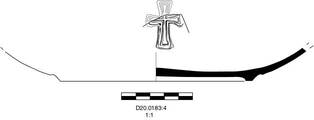
375. Phocaean Red Slip Ware Hayes Form 4
P. H. .03. Est. diam. rim .13 (1/4 preserved). Est. diam. base .063. Th. .005.
H17.1182:1. SC12-4pp. PH. 3; est. D.rim 13; base 6.3; Th. 0.5. Preserving 1/4 of rim and wall. Orange buff fabric (between 2.5YR 5/6 and 6/6) fine lime on surface.
svg/H17.1182-1.jpg
376. Phocaean Red-Slip Hayes form 5b Rim (1st Half Sixth Century AD)
P. H. .013. Est. diam. rim .25 (1/12 preserved). Th. .0084.
K18.0032:6. SC13-1a. Single sherd. Matte orange slip. Rouletting on ledge rim. Occasional lime chunks on surfaces.
, p. 339 and fig. 70.3.
svg/K18.0032-6.jpg
377. Phocaean Red Slip Ware, Hayes Form 5B (525-550)
H17.0036:3. H. 2.2; est. D.rim 33; Th. 0.5. Preserving 1/10 of rim. Triple line of rouletting on rim. Pinkish buff fabric with matte red slip.
Hayes 1972, 339, n.3, fig.70
svg/H17.0036-3.jpg
378. Phocaean Red-Slip Hayes form 8 Rim (late 5th century AD)
Est. diam. rim .14 (1/3 preserved). Th. .0028.
G27.0004:1. Single rim sherd, downturned rim with ridges. Fabric fired to red (2.5YR 6/8) with small light inclusions. Surface thinly slipped and brushed, same color as fabric.
, p. 342 and fig. 70.1.
svg/G27.0004-1.jpg
379. Phocaean Red-Slip Hayes form 8 Rim (late 5th century AD)
Est. diam. rim .14 (1/4 preserved). Th. .02.
O18.0014:1. Single rim sherd, rounded outer edge of downturned rim. Fabric fired to red (2.5YR 6/8) with occassional small light inclusions. Surface thinly slipped and brushed, fired to darker red (10R 5/6), darker under rim.
Cf. , p. 342 and fig. 70; and nos. 1317 and 1318.
O18.0014-1.jpg
380. Phocaean Red Slip Ware Hayes Form 9
D20.0073:16. PH. 2.6; est. D.rim 15; Th.0.5. Preserving 1/20 of rim. Small everted rim, deep ridges exterior of wall. Pinkish buff hard fired fabric with matte red slip.
svg/D20.0073-16.jpg
381. Phocaean Red Slip Ware Hayes Form 3/10a (6th Century AD)
H. .063. Est. diam. rim .30 (1/3 preserved). Th. .006.
D20.0061:1. Six sherds, in two joining groups of three each, nearly all of profile. Pinkish buff fabric with matte orange slip, fired cream around rim. The profile varies so that a slight offset under the rim is visible along a portion of the extant circumference.
Cf. , p. 343 and fig. 71.4.
svg/D20.0061-7.jpg
382. Phocaean Red-Slip Hayes form 10c Rim (7th century AD)
P. H. .02. Est. diam. rim .30 (1/20 preserved). Th. .0049.
G27.0001:1. Single rim sherd. Fabric fired to light red (2.5YR 6/6) with frequent calcareous inclusions. Surface coated on all surfaces, brushed smooth, and fired to just darker than fabric (towards 5/6). One large chunk of lime seen just under surface, now visible on surface.
Cf. , p. 343 and fig. 71.12.
G27.0001-1.jpg
383. Late Roman Light-Colored Ware Rim
P. H. .021. Est. diam. rim .15 (1/8 preserved). Th. .0036.
K17.0736:1. SC13-4f. Very fine pale (7.5YR 8/3, towards 8/4) fabric with no inclusions individually discernible by eye and only tiny darker specs at 10x mag. Surface thinly slipped, brushed smoothed. Slip is light brown (5YR 6/6), though darker where thickest.
Near CF183.
K17.0736-1.jpg
384. Late Roman Light-Colored Ware Profile
Est. diam. rim .16 (1/2 preserved).
P18.0090:1. Five joining sherds. Compact pale brown (7.5YR 6/6) fabric. Thinly applied slip is predominantly red (2.5YR 6/6) with darker areas. Areas of the outer face of the rim have the "warm brown" tone characteristic of many vessels of this ware. Concentric circles around center of interior floor. Extant exterior wall bears smoothing marks that vary in depth and width.
P18.0090-1.jpg
385. West Asia Minor Light Colored Ware Juglet
H17.0058:3. PH. 2.5; est. D.base 4; Th. 0.5. Preserving 1/3 of base. Shallow ring base. Pale yellow fabric with thin orange slip.
386. Jug. West Asia Minor Light Colored Ware
H17.1165:5. PH. 4.5; est. D 15.7 (wall to wall); Th. 0.6. Pale buff fabric with thin light orange slip.
387. Late Roman Light Colored Ware
H17.0045:5. PH. 3.5; Th. 0.4. Preserving single wall fragment. Rouletting on wall. Pale yellow fabric matt orange slip. Similar fine fabric to C/D 20/21.413:13, 14.
388. Bowl, West Asia Minor Pale Ware
C/D20/21.0413:13. Ph. 3.9; est. D.rim 20; Th. 0.5. Preserving 1/6 of rim. 15 fragments, 5 mendable. Broad horizontal rim, flat underside, two deep grooves, impressed rouletting on upper rim and interior on wall. Pale yellow fabric (7.5YR 8/6) with bright orange/red slip (between 2.5YR 5/8 and 6/8), finger marks on exterior wall. NOTE: (Correct drawing page :13 and :14 reverse)
Sardis, Courtyard Well Rautman 1997? AASOR 53; Hayes 1968, 211, n.75; same in Hayes 1992, 94, Deposit 11, n.10.
389. Bowl, West Asia Minor Pale Ware
C/D20/21.0413:14. . Ph. 3.9; est. D.rim 20.5;base 9; Th. 0.5. Preserving 1/10 of rim. Unjoining two fragments. Broad rim with flat underside, two grooves and impressed rouletting on upper rim and interior on wall. Pale buff fabric (7.5YR 8/6) with thin orange slip (between 2.5YR 6/6 and 6/8).
390. Unguentarium. West Asia Minor Pale Ware (5th Century AD)
C/D20/21.0413:8. PH.1.2; est. D.base 4; Th. 0.4. Preserving ½ of base. Pale yellow fabric with thin matte orange slip.
391. Attic Lamp
H17.0763:4. Description to come.
392. Lamp. Attic.
H17.0036.012. L0039. P.H.1.6; P.L.4.3; P.W.2.1. Preserving 1/6 of rim part of
discus.Herringbone pattern and tongue pattern in discus. Unslipped, pinkish buff (5YR 7/6).
Perlzweig 1961, n.711, pl.16.
393. Lamp (5th Century AD)
H17.0032:3. L0035. P.H.1.0; P.L.3.9; P.W.4.2. Preserving pattern on discus.Central hole on discus. Erotic scene. Unslipped, orangish buff (5YR7/4) with fine silver mica.
394. Lamp (4th to 5th Century AD)
:. L0049. H.3.7; L.9.2; W.6.5. Preserving almost whole, nozzle broken in half. Two holes in discus. Erotic scene on a kline in discus, raised dots around wall. Solid handle no hole. Foot depression and two circular dots under base. Overfired, gray fabric (2.5YR 4/2).
395. Lamp. Regional (3rd Century AD)
H17.0737:11. PH. 4.7; PL. ADD; Th. 0.6. Preserving 1/6 of wall around handle. Solid handle with no grooves, pierced. Pinkish buff fabric, hard fired, unslipped.
Slane 1986; Riley.
396. Lamp
H17.0056:4. Preserving 1/10 of wall. Pale buff fabric with matte yellow brown slip.
397. Lamp gray (100-75 BC)
H17.1048:5. PH. 1.8; Th. 0.4. Raised discus. Preserving 1/3 of discus and wall. Gray with matte black slip.
398. Jug, unclassified (late 3rd Century AD)
P. H. .21. Est. diam. base .112. Th. .008.
z16.0097. P0752. Almost complete, missing rim and handle, flat, string cut base. Purplish brown (5YR 6/3) fabric, surface reddish buff (5YR 8/2). Deep wheel ridges on upper body.
svg/P0752.jpg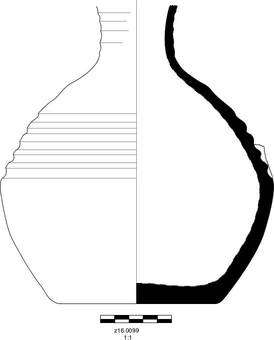
399. Amphora, unclassified (Late 3rd Century AD)
P. H. .171. Est. diam. rim .07. Th. .011.
z16.0102. P0753. Single sherd, upper body and rim, one handle and stub of opposite; everted rim ledge for lid, round handles. Brown (7.5YR 6/6) fabric with frequent silver mica and light bits. Coated surface fired pale (7.5YR 8/3). Graffiti reads CTE on shoulder, perhaps applied before firing.
svg/P0753.jpg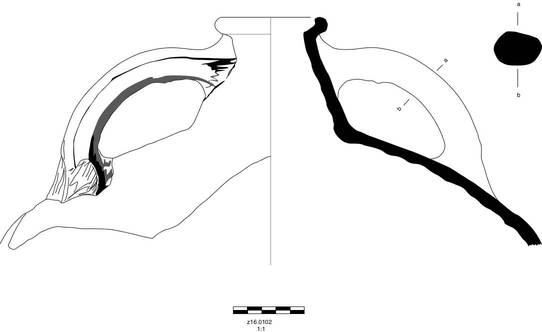
400. One Handled Jug (Third Century AD)
H. .228.
z16.0115. P0754. Jug with trefoil rim, missing part of the rim. Flat based? with strap handles. Highly micaceous gritty fabric in orangish buff color (betw 7.5YR 7/4 and 7/6) block volcanic bits on the surface. Found in the z16 shaft deposit.
401. Two-handled Jar (Late Third Century AD)
H. .495. Est. diam. base .11.
z16.0110. P0755. Wide-mouth storage jar with two handles. Banded rim, wheel ridged body, molded base. Pierced hole on the wall. Orangish buff fabric (betw 5YR 6/4 and 6/6) with lime nd silver mica.
402. Storage Jar (Third Century AD)
H. .50.
z16.0115. P0756. Nearly complete, two handles, molded base. Orangish buff (between 5YR 6/4 and 6/6) with lime and silver mica. Wheel ridges on body.
403. Jug, local (Third Century AD)
P. H. .25. Est. diam. base .106. Th. .0047.
z16.0115. P0757. Complete except for rim, strap handle, flat base. Reddish (5YR 4/6 and 5/6) fabri with fine silver mica and lime bits visible on the surface. Graffito (inscribed) on shoulder MA. Found in the z16 shaft deposit. Organic deposits on interior and exterior.
404. Water jar, local
P. H. .157. Est. diam. base .133. Th. .007.
z16.0110:1. Eight joining sherds preserve lower part of body and flat base. Compact, red-orange (5YR 7/8) fabric with white inclusions, often visible on surface. Broad wheel ridges on exterior wall, shallower ridges on interior. String cut base smoothened afterward.
405. Trefoil rim jug, unclassified (late 3rd Century AD)
P. H. .23. Th. .007.
z16.0110:2. Preserving four joining fragments of upper wall and neck, strap handle. Trefoil rim and initiation of handle partially extant. Slightly granular, buff (7.5YR 8/4) fabric with very frequent golden mica in breaks and visible on surface, other darker tiny bits. Plain surfaces show fine turning lines, shallow spiral ridges on neck.
406. Jug?, local (Late 3rd Century AD)
P. H. .192. Th. .007.
z16.0110:3. Three joining fragments preserved body profile below neck, and single handle stub, flat base. Granular, reddish (5YR 7/6) fabric with frequent light bits, some larger. String-cut base. Exterior surface has shallow ridging on on shoulder and above, smooth towards base. Interior with some ridging all over. Surface coated, with signs of sponging, particularly below shoulder. Decorative band of two-lines with sharp zig-zag between is well preserved where organic materials still adheres to vessel (see photograph). The band does continue around extant vessel.
407. Storage Jar, local (Late 3rd Century AD)
P. H. .363. Est. diam. base .119.
z16.0110:4. Twenty joining sherds preserve profile to below rim, one oval handle and opposite stub, oval handles, molded base. Slightly granular fabric has gray core and red (near 7.5YR 6/6), frequent light angular bits. Coated surface is largely smooth, some wheel ridging on interior. Bottom intentionally pierced with almost round hole, .037 at maximum diameter.
408. Storage Jar, local (Late 3rd Century AD)
P. H. .265 (in two parts: upper wall .092, lower .11). Est. diam. rim .101. Th. .005.
z16.0115:1. Preserving upper and lower wall with no joins in between. 4 fragments upper part mended, 7 fragments of base mended, 7 unjoining fragments of lower wall. Both handles and molded base. Compact red (5YR 6/6) fabric with tiny light inclusions. Surface plain, abraided/softened by water. Organic material adheres to inner and outer surfaces.
409. Storage Amphora, local (Late 3rd Century AD)
P. H. .265. Est. diam. rim .11 (1/2 preserved). Th. .005.
z16.0115:2. Four joining sherds, reserving upper wall, and portion of rim; other non-sherds likely from this vessel. Compact, orange red (5YR 7/8) fabric with frequent white inclusions in breaks and on surface. Light and broad ridges on exterior wall, shallower on interior. One handle extant, stub of second opposite.
410. Storage Jar, unclassified
P. H. .233. Est. diam. rim .095. Th. .005.
z16.0119:1. Four joining sherds preserve profile, two opposed oval handles, neck and chipped rim. Molded base. Soft, compact reddish brown (5YR 6/6) fabric with frequent tiny mica and occasional light chunks; coated surface is pale, with organic residue from well. The breaks clearly show that the body of the vessel was constructed in two layers, which are now flaking apart.
411. Storage Jar, unclassified
P. H. .218. Est. diam. rim .112. Th. .005.
z16.0119. 2. Single fragment, preserving rim, neck, two handles and upper wall. Light red (2.5YR 8/4) fabric with frequent golden mica and varied darker bits in breaks and on surface; surface fired pale brown (10YR 8/4). Narrow wheel ridges on exterior, lighter on interior; spiral round neck.
412. Storage Jar, unclassified (Late 3rd Centry AD)
P. H. .1552. Est. diam. base .08 (complete preserved). Th. .0052.
z16.0128:1. Three joining and three non-joining sherds preserve base and lower wall. Red (2.5YR 7/6) fabric with frequent mica, fired pale on surface (7.5YR 8/3). Molded base with excess clay at center. Shallow broad ribbing on exterior, largely smooth on interior.
413. Storage Jar, local
P. H. .348. Est. diam. rim .121. Th. .0094.
z16.0128:2. Five joining sherds preserve complete profile, two oval handles; banded rim; molded base. Photograph does not show joins to base. Compact reddish (5YR 7/8) fabric with occasional lime in breaks and on surface. Wide wheel ridges on exterior, less distinct on interior. Dimples on interior of neck at handle attachments.
414. Plain Ware Jug Rim
K/L16/17.0467:11. Not cataloged
415. Plain Ware Bowl (2nd Century AD)
P. H. .13. Est. diam. rim .30.
K/L16/17.0086:3. Ten joining and non-joining sherds allow profile to be restored. Soft, slightly granular pale green (5Y 8/3) fabric with added sand (quartz, red, black – all small) and frequent lime chunks also visible on surface. The surface may have been intentionally coated dark greenish/gray (near 5Y 3/2) but is only poorly preserved now. The base is irregularly formed with the differing widths shown in the illustration. Metal adheres to sherds K/L16/17:0146:03 and K/L16/17.0118:21a and b.
svg/K-L16-17.0146-3.jpg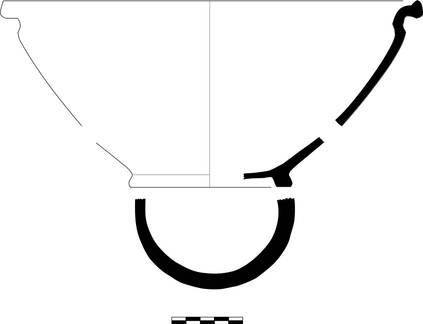
416. Unclassified Plain Ware Cookpot, Downturned Rim
P. H. .057. Est. diam. rim .19 (completely preserved). Th. .004.
K/L16/17.0114:1. Seven joining sherds. Slighty granular brown (5YR 6/6) fabric with frequent varied angular inclusions and gold mica visible in section and on the surface. Thinly coated surface is pale brown (5YR 7/6). One strap handle (as shown by complete preservation of rim). No joins to the simiar vessel in K/L16/17.0112.
svg/K-L16-17.0114-1.jpg
417. Unclassified Plain Ware Cookpot, Downturned Rim
K/L16/17.0112:19. P.H. .027, est. D. rim .14 (1/6 preserved), th. wall .005. Two joining rim sherds. Slighty granular brown (5YR 6/6) fabric with frequent varied angular inclusions and gold mica visible in section and on the surface. Thinly coated surface is pale brown (5YR 7/6). Iron patch interrupted by break. See :18 for probable base.
svg/K-L16-17.0112-19.jpg
418. Unclassified Plain Ware Pot, Molded Base
K/L16/17.0112:18. P.H. .032, est. D. base (1/3 preserved), th. wall .0041. One base sherd. Identical in fabric to K/L16/17.0112:19. Probably base of the same.
svg/K-L16-17.0112-18.jpg
419. Large Portable Processing Platform (2nd Century AD)
P. H. .083. Th. .018. L. 23. W. .132.
K/L16/17.0114:5. Two joining sherds preserve corner, original dimensions not recoverable. The fabric and surface of this piece are identical to the very large mixing bowl/mortarium (K/L16/17.0144:5). The large golden mica flakes, in particular, make it very likely that they come from closely related workshops. There is a layer of white accretion not removed by the acid bath used to conserve the piece but this is not part of the original surface. It is, however, under the remaining patches of dark gray ash so that this is evidence of post-depositional burning: i.e., a sequence of deposition, accretion, burning. Even without knowing the original dimensions, the surviving portion indicates a large and sturdy piece of kitchen equipment. In form, it is a platform with upturned edges. It stood on at least two raised feet, only one of which is in evidence, that ran along parallel sides. The extant foot is .04 high from base to lower floor. There is a single ridge on the sloping upper face of the edge. There is no extant iron adhering to this piece.
svg/K-L16-17.0114-5.jpg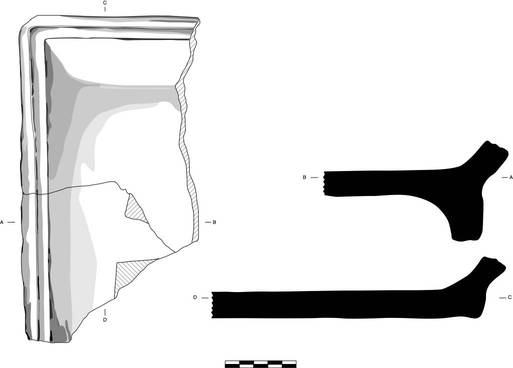
420. Very Large Mixing Bowl/Mortarium (2nd Century AD)
P. H. .078. Est. diam. rim .65-.75. Th. .0295.
K/L16/17.0144:5. Single rim fragment. Fabric is predominantly pale red (5YR 6/6), with variation around this. As with any such large utilitarian vessel, the inclusions in this piece are extremely varied. At the large end is angular quartz up to .007 in length, and rounded lime chunks .002 in diameter. There are gray and reddish stones .005 and smaller. An important component is the regular presence of large and small golden mica flakes, up to .003 in diameter when flattened on the base. At the small end of the size scale are an abundance of angular and rounded light and dark bits. Despite the high frequency of inclusions the paste is not overwhelmed. Using the munsell “charts for estimating the proportions of mottles and coarse inclusions” puts the inclusions in this vessel at between 5 and 7 percent. The coating is pale brown (7.5YR 7/4); it is worn away by use below rim. There is a single patch of iron on the extant interior face.
svg/K-L16-17.0144-5.jpg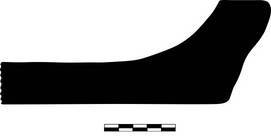
421. Regional Brown Plain Ware Basin, Incurved Rim
P. H. .064. Est. diam. rim .28 (1/3 preserved). Th. .007.
K/L16/17.0461:31. Single sherd of rim and upper wall. Compact brown (2.5YR 7/4) fabric with varied tiny inclusions, becoming redder towards surface. Pale (near 7.5YR 7/6) surface, self-slip.
svg/K-L16-17.0461-31.jpg
422. Plain Ware Basin, Type 1
P. H. .081. Est. diam. rim .30 (1/5 preserved). Th. .006.
K/L16/17.0467:22. Single large rim sherd. Compact red (2.5YR 6/6) fabric with small rounded light and occasional rounded dark inclusions. Coated exterior surface is very pale (10YR 8/2).
svg/K-L16-17.0467-22.jpg
423. Regional Brown Plain Ware Basin, Incurved Rim
P. H. .037. Est. diam. rim .31 (1/8 preserved). Th. .065.
K/L16/17.0112:16. Single rim sherd. Slightly granular, red (2.5YR 7/8) fabric with some angular light and dark inclusions. Pale white coating on exterior. Interior plain. Metal patch adhering to inner wall.
svg/K-L16-17.0112-16.jpg
424. Basin, hammer-head rim. Regional (2nd-3rd Century)
H17.0763:20. PH. 8.0; est. D.rim 18; Th. 1.0. Preserving 1/8 of rim. Wavy lines and deep smoothening marks on wall. Pinkish buff hard fired fabric (2.5YR 6/6) with very fine silver mica.
svg/H17.0763-20.jpg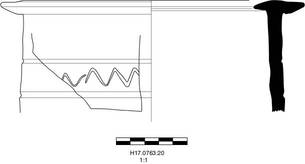
425. Basin with ledge rim. Regional (Late 2nd-3rd Century AD)
D20.0290:4. PH. 7.4; est. D.rim 22; Th. 0.5. Preserving 1/6 of rim. Pinkish buff fabric (2.5YR 7/4) with cream slip.
svg/D20.0290-4.jpg
426. Regional Brown Plain Ware Basin, in-turned stepped ledge rim
P. H. 042. Est. diam. rim .22 (1/10 preserved). Th. .007.
K/L16/17.0456:3. Single rim sherd. Compact brown (2.5YR 5/8) fabric with frequent tiny angular inclusions and occasional larger, up to .0025 in diameter, dark chunks exposed on the surface. The interior surface is plain. The exterior has a very light buff (7.5YR 8/3 where thickest) wash that lets the fabric color show through. Near Kozal 2001, nos. 156 and 164.
svg/K-L16-17.0456-3.jpg
427. Regional Brown Plain Ware Basin, white slip, ledge rim
P. H. .031. Est. diam. rim .26 (1/5 preserved). Th. .0045.
K/L16/17.0456:2. Single rim sherd. Fine brown (5YR 5/6) fabric with occasional elongated lime inclusions as well as other small light bits. The exterior surface is plain. The upper face of the rim and the interior are coated white that survives only as partially preserved streaks.
svg/K-L16-17.0456-2.jpg
428. Regional Brown Plain Ware Pot, Ledge Rim (Early Roman)
P. H. .026. Est. diam. rim .23 (1/7 preserved). Th. .005.
K/L16/17.0427:32. Single rim sherd. Compact brown (2.5YR 6/8) fabric with frequent small black inclusions and occasional larger angular quartz. Surface plain, with thin self-slip.
svg/K-L16-17.0427-32.jpg
429. Regional Brown Plain Ware Jug Base (Roman)
K/L16/17.0114:7. P.H. .079, est. D. base ~~.10 (<1/10 preserved), Th. wall .045. Single sherd, molded base. The slightly coarse brown (2.5YR 5/8, lighter towards inner surface) includes rare pieces of previously fired clay, infrequent angular quartz(?), and frequent smaller bits. The exterior surface is coated red (10R 5/4), the interior is plain.
svg/K-L16-17.0114-7.jpg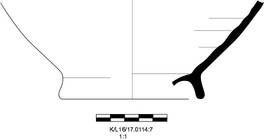
430. Regional Brown Plain Ware Bowl
P. H. .053. Est. diam. rim .31 (1/5 preserved). Th. .006.
K/L16/17.0461:20. Single rim shared. Compact brown (5YR 6/8) fabric with small mostly angular dark and light inclusions. Thin pale (7.5YR 7/3) slip over all surface. Broad ridges on exterior wall. Ash on interior of bowl, but only a small streak on exterior; not necessarily from original use.
svg/K-L16-17.0461-20.jpg
431. Bowl. Local
D20.0334:14. PH. 3.8; est. D.rim 24; Th.0.8. Preserving 1/6 of rim. Pinkish fabric (2.5YR 7/6) with lime and silver mica inclusions. Self slip fired cream on surface.
432. Basin, wide ledge rim. Local.
H17.0730:5. PH. 5.2; est. D.rim 35; Th. 0.8. Preserving 1/8 of rim. Pinkish buff fabric (2.5YR 6/6) hard fired. Deep ridges on exterior wall.
Fabric similar to w28 pots (Tekkok 2001).
433. Basin, ledge rim. Local (4th Century AD)
H17.0730:8. PH. 2.5; est. D.rim 27; Th. 1.4. Preserving 1/10 of rim. Pinkish buff fabric (2.5YR 6/6) hard fired, surface fired cream.
434. Bowl/basin. Local (4th Century AD)
H17.0069:7. H. 9.7; est. D.rim 22; Th. 0.8. Preserving 1/8 of rim and wall. Pinkish buff fabric with flakes of gold mica on surface.
435. Basin. Regional (LR or later)
H17.0044:2. Preserving a small fragment. Plastic attachment with punched dots on it. Orangish buff fabric with bits of silver mica.
436. Storage basin ledge for lid, Local (3rd Century AD)
D20.0334:20. PH. 5; est. D.rim 28; Th. 1.2. Preserving 1/6 of rim. Pinkish buff fabric with chunks of lime and silver mica.
437. Basin/Bowl (4th Century AD)
D20.0363:1. PH. 4.7; est. D.rim 25; Th. 0.6. Preserving 1/6 of rim. Heavy wall slightly irregular. Pinkish red fabric (2.5YR 6/6) fired gray at core, hard fired.
438. Basin/Bowl (4th Century AD)
D20.0363:3. PH. 3.7; est. D.rim 24; Th. 0.6. Preserving 1/6 of rim. Wall slightly irregular. Brown fabric (5YR 6/4) highly granular.
439. Basin, ledge rim. Local (4th -5th Century AD)
D20.0063:3. PH. 5.2; est. D.rim 24; Th. 1.2. Preserving 1/6 of rim. Suspension hole on rim. Orangish buff fabric (2.5YR 6/4) with gray bits, lime inclusions.
440. Plain Ware Modius Base
P. H. .068. Est. diam. base .26 (1/4 preserved). Th. .011.
K/L16/17.0144:14. Single sherd, base and wall. Granular fabric with varied inclusions: angular quartz and rounded lime, both up to .002 in length, smaller light and dark bits. The vessel is unevenly fired, light red (2.5YR 6/6) near bottom of base and layered gray and brown near interior surface. It is distinct from the other large plain wares in this group.
svg/K-L16-17.0144-14.jpg
441. Plain Ware Basin Base
P. H. .12. Est. diam. base .21 (1/5 preserved). Th. .009.
K/L16/17.0112:17. Two joining sherds, base and lower wall. Compact brown (2.5YR 5/6) fabric with angular quartz and other smaller inclusions. All extant surface are coated and fired pale (2.5Y 8/2).
svg/K-L16-17.0112-17.jpg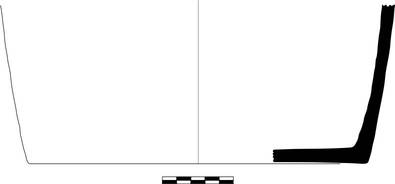
442. Unclassified Small Red-Slipped Unguentarium (Late Roman?)
P. H. .0165. Est. diam. base .05 (1/3 preserved). Th. .006.
K17.0845:15. Single base sherd. Hard, compact light red (2.5YR 6/6) fabric with occasional lime exploding on interior surface. There is a gray subsurface patch near the base just under the interior surface, this does not continue around the whole of the extant sherd. The worn surface is slipped and fired to an uneven red/orange (from 2.5YR 5/8 to 6/8). The interior of the vessel shows deep grooves. The exterior unevenly banded. A large void (.0143 long) appears on the exterior surface just above turning of floor.
svg/K17.0845-15.jpg
443. Basin, Downturned Ridged Rim
P. H. .039. Est. diam. rim near .30 (<1/20 preserved). Th. .007.
K/L16/17.0413:1. Two joining sherds, modern break. Slightly granular, hard light red (2.5YR 7/6) fabric with occasional light, elongated bits. Surface plain with buff patches thinly coated. Ridges on wide drooping rim. [[needs inking]]
444. Phocaean Cookpot
P. H. .03. Est. diam. rim .13 (1/10 preserved). Th. .003.
K/L16/17.0461:18. Single sherd of rim and upper wall. Thickened triangular rim with ridges on outer face. Brown fabric (2.5YR 5/8) with frequent white inclusions and golden mica. Gray exterior surface. Interior same as fabric.
For form see no. 85.
svg/K-L16-17.0461-18.jpg
445. Phocaean Cookpot, Inverted and Ridged Rim
P. H. .033. Est. diam. rim .15 (1/10 preserved). Th. .0025.
K/L16/17.0434:11. Single rim sherd. The compact reddish brown (near 2.5YR 5/8) fabric has frequent tiny white inclusions and less frequent darker ones, golden mica in fabric and on surface. The surface of this sherd is very worn but where preserved is gray (2/5YR 5/2).
Form near no. 84, though slightly more rounded.
svg/K-L16-17.0434-11.jpg
446. Phocaean Cookpot, Inverted and Ridged Rim
P. H. .029. Est. diam. rim .145 (1/7 preserved). Th. .002.
K/L16/17.0434:4. Single rim sherd. Slightly granular, dark reddish-brown (2.5YR 5/8) fabric with frequent tiny to small white inclusions and golden mica, some flattened on surface. Interior is plain. Exterior is gray.
For form see no. 84.
svg/K-L16-17.0434-4.jpg
447. Cookpot, Regional
P. H. .033. Est. diam. rim .020 (<1/10 preserved). Th. .004.
K/L16/17.0474:8. Single rim sherd. Granular brown-red (10R 5/8) fabric with frequent angular inclusions. Exterior surface gray, interior same as fabric. The thickened rim is folded with two deep ridges on outer face with rounded edge below.
See no. 85 for similar form in Phocaean fabric.
svg/K-L16-17.0474-8.jpg
448. Phocaean Cookpot, Flaring Rim (Early Roman)
P. H. .058. Est. diam. rim .22 (1/10 preserved). Th. .003.
K/L16/17.0120:13. Two joining rim sherds. Slightly granular brown (5YR 4/4) fabric with frequent angular white inclusions and occasional golden mica flattened on surface. Surface dark gray (2.5Y 4/1) with much thinner slip on lower part of preserved exterior. Shallow, broad ridges on exterior.
For form see no. 80.
svg/K-L16-17.0120-13.jpg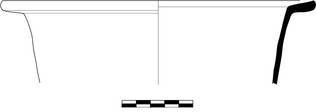
449. Phocaean Cookpot
P. H. .057. Est. diam. rim .22. Th. .006.
K/L16/17.0427:9. Single rim and handle sherd with upper wall to carination. Hard, slightly granular fabric is red-brown (10R 6/6) near exterior, shading to brown (7.5YR 6/3) near interior at wall; frequent small light and quartz inclusions. The plain surface is fired gray, thin layer. The extant handle is sliced at the right side. The color of this piece is darker than most Phocaean vessels, perhaps from use or subsequent burning. (Was drawn as 08 so needs "inking", on sheet 1754).
450. Phocaean Cookpot Rim and Handle, upturned rim
P. H. .087. Est. diam. rim near .28 (<1/10 preserved). Th. .004.
K/L16/17.0144:3. Two sherds, rim and handle. The fabric of this vessel is compact with frequent elongated light and rounded dark inclusions; orange (2.5YR 6/8) towards the interior surface and browner (7.5YR 6/4) towards the exterior. The exterior surface is gray. Slight ribbing is evident on the extant wall, an unusual feature in Phocaean vessels as found at Ilion.
Cf. , no 80; type T9, p. 86.
svg/K-L16-17.0144-3.jpg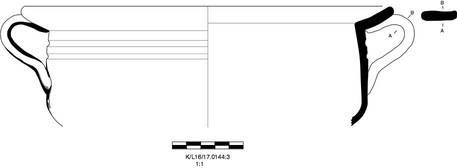
451. Cooking pot. Phocaean.
H17.0730:2. PH. 5.9; est. D.rim 20; Th. 0.4. Preserving 1/8 of rim. Pinkish buff fabric surface blackened.
Hayes 1983, 122, n.81, fig.7.
452. Cooking pot. Phocaean (3rd Century AD)
H17.0737:6. PH. 1.5; est. D.rim 21; Th. 0.4. Preserving 1/20 of rim. Pinkish buff fabric with blackened surface.
453. Phocaean Cookpot
P. H. .034. Est. diam. rim .21 (1/12 preserved). Th. .004.
K/L16/17.0102:2. Single rim sherd with handle start, flaring rim. Light red (2.5 YR 6/8) granular fabric with occasional angular and frequent tiny dark inclusions. Exterior surface fired gray (5YR 6/1), interior with streaked reddish wash.
svg/K-L16-17.0102-2.jpg
454. Cooking pot. Phocaean (2nd Centuery AD)
D20.0211:1. PH. 3.6; est. D.rim 20; Th. 0.5. Preserving 1/8 of rim. Pinkish buff fabric(2.5YR 5/6) blackened exterior and around rim.
Villa of Dionysos (Hayes 1983, 122, n.58, fig.5).
455. Unclassified Cookpot, Upturned Rim
P. H. .055. Est. diam. rim .15 (1/10 preserved). Th. .0035.
K/L16/17.0118:3. Granular red (nearest 2.5YR 6/8) fabric with very frequent small angular and occasional larger, up to .001, elongated white inclusions. The exterior surface is a dull brown (2.5YR 6/4) whereas the interior is closer to the fabric. Gold mica is visible flattened on surface. The fabric is close to "sanded oxydized cookware", though the form is Phocaean. The firing is unusual for either source: brown and no gray surface.
svg/K-L16-17.0118-3.jpg
456. Phocaean Globular Cookpot, upturned rim
P. H. .027. Est. diam. rim .15 (1/4 preserved). Th. .003.
K/L16/17.0114:47. Ten sherds, six joining with rim, and four probably from same vessel. The vessel has been discolored by heat, either before or after deposition. The original pale red (2.5YR 6/6) color of the fabric is preserved near the rim. Inclusions consist of angular quartz and smaller varied bits.
Cf. T4.
svg/K-L16-17.0114-47.jpg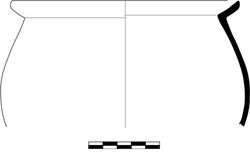
457. Phocaean Cookpot Rim and Handle Room, hooked rim
P. H. .058. Est. diam. rim .23 (1/8 preserved). Th. .004.
K/L16/17.0148:9. Single rim sherd. Slightly granular fabric is unevenly fired with brownish-red (5YR 5/6) core fading to dark brown near exterior surface. Inclusions consist mainly of small angular white bits and less common smaller dark bits as well. The exterior surface is discolored from use, the interior wall retains some weak red hue (2.5YR 5/2) in patches but is probably also discolored.
Cf. type T10, p. 87.
svg/K-L16-17.0148-9.jpg
458. Phocaean Cookpot
P. H. .044. Est. diam. rim .15 (1/12 preserved). Th. .0037.
K/L16/17.0102:1. Single rim sherd. Slightly granular, light red fabric (2.5YR 6/8) fabric, tiny dark inclusions. Gray-brown (near 10YR 5/2) surface.
Cf. type T15.11, p. 91.
svg/K-L16-17.0102-1.jpg
459. Regional Sanded-Oxydized Cooking Ware Thin-Walled Cookpot, Downturned Rim
P. H. .042. Est. diam. rim .21 (1/5 preserved). Th. .003.
K/L16/17.0417:4. Single sherd. Compact red (2.5 YR 6/8) fabric with occasional tiny white inclusions. Gray surface.
Cf. T88 and T89.
svg/K-L16-17.0417-4.jpg
460. Strainer, Regional
D20.0017:6. PH. 4.2; Th.0.6. Pinkish buff fabric (2.5YR 5/6) fired gray on surface.
svg/D20.0017-6.jpg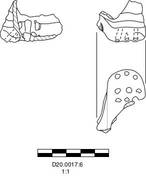
461. Trivet. Regional.
D20.0290:10. PH. 1.3; est. D.base 24; Th. 1.4. Preserving ¼ of base. Brown gritty fabric with silver mica, blackening on underside.
462. Trefoil jug. Regional (3rd Century AD)
H17.0730:7. PH. 12; est. D.neck 3.4; Th. 0.4. Preserving entire rim neck and handle, broken where attached to the body. Pinkish buff fabric with gray surface.
Slane 1990, Tekkok.
svg/H17.0730-7.jpg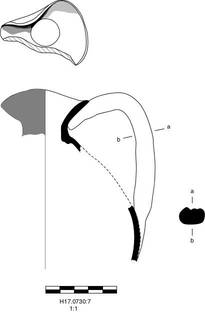
463. Regional Sanded-Oxydized Cooking Ware Jug, trefoil rim
P. H. .02. Est. diam. rim not recoverable.
K/L16/17.0114:18. Single sherd with part of rim and start of handle. Fine brown (2.5YR 5/8) fabric with frequent small white inclusions. Surface intentionally vitrified.
svg/K-L16-17.0114-18.jpg
464. Regional Sanded-Oxydized Cooking Ware Jug, trefoil rim
P. H. .066.
K/L16/17.0086:10. Width mouth .0764. Single rim sherd. Light red (2.5YR 5/8) fabric with tiny lime inclusions. Gray surface. Faceted under lip.
svg/K-L16-17.0086-10.jpg
465. Regional Sanded-Oxydized Cooking Ware Trefoil-Mouth Jug
P. H. .045. Est. diam. rim length mouth .065 (completely preserved preserved). Th. .01.
K/L16/17.0417:10. Single sherd preserves complete mouth and handle attachment. Compact red (2.5YR 5/8) fabric with frequent small white inclusions. Exterior surfaces fired gray (7.5YR 5/1) interior plain.
svg/K-L16-17.0417-10.jpg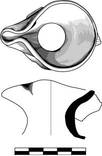
466. Unclassified Jug, Spiralled Neck
P. H. .067. Est. diam. rim .07 (completely preserved preserved). Th. .03.
K/L16/17.0413:2. Single sherd preserves complete neck and handle attachment. Compact reddish brown (2.5YR 6/6) fabric with frequent tiny mica, occasional lime visible on surface. Surface coated. Spiral groove running up neck. [[needs "inking"]]
An additional sherd of this fabric is D20.0288:6.
467. Jug Local (5th Century)
H17.0032:22. PH. 3.1; est. D.base 4.7; Th. 0.5.Preserving ¼ of base. Exterior surface irregular. Brown micaceous fabric, deep smoothening on exterior.
468. Jug Local (5th Century)
H17.0032:27. PH. 2.0; est. D.base 4.; Th. 0.5.Preserving 1/3 of base. Molded jug base. Orange buff fabric, fired cream on surface.
469. Jug, Local (from 5th/6th fill)
H17.0058:4. PH. 1.6; est. D.base 5; Th. 0.4. Preserving complete base. Cut shallow base. Pinkish buff hard fired fabric (2.5YR between 6/4 and 6/6) with lime and gold mica fabric as 32:26.
470. Jug (5th Century AD)
H17.1165:3. PH.10.1; est. D.rim 7; Th.0.6. Preserving 1/8 of rim. Narrow neck, everted rim. Fine turning marks on neck. Gray fabric (10R between 5/1 and 5/2), fired hard.
471. Jug. Local (4th to 5th Century AD)
H17.1087:7. PH. 6; est. D 11(wall to wall); Th. 0.5.Orangish buff granular fabric (5YR 6/4) gold mica visible on surface.
472. Jug. Regional
H17.1175:7. PH. 4.9; est. D.rim 12.1; Th. 0.5. Preserving 1/6 of rim. Pinkish buff fabric (5YR 6/6) fine lime and silver mica inclusions.
473. Jug. Local
H17.1175:15. PH. 2.4; est. D.base 6; Th.0.6. Preserving 1/4 of base. Shallow ring base. Pinkish brown fabric (2.5YR 5/4) with thin brown slip, fine silver mica visible on surface.
474. Water jar. Local
H17.1087:6. PH. 3.8; est.20; Th. 0.6. Preserving 1/10 of rim. Brown (2.5YR between 5/6 and 6/6) highly granular fabric, inclusions include thin long flakes of gold mica and black bits. Fabric similar to local basins with ledge rim.
475. Pompeian Red Ware Baking Pan
P. H. .035. Est. diam. rim .34 (1/12 preserved). Th. .01.
K/L16/17.0430:2. Single rim sherd. Granular, hard brown (7.5YR 4/3) fabric with added sand and other varied inclusions; many of the quartz-like inclusions are flattened on the outer surface and so are highly reflective. Thickly slipped and smoothed inner surface, darkened by burning. Thickened rim is undercut at exterior.
svg/K-L16-17.0430-2.jpg
476. Baking pan. Aegean (AD 50-125)
D20.0235:9. PH. 4.8; est. D.rim 48, Th.1.3. Preserving 1/10 of rim with wall. Deep smoothening marks exterior on wall. Brown granular fabric (5YR 5/4) with opaque quartz, silver mica inclusions. Thin brown slip coated interior.
svg/D20.0235-9.jpg
477. Phocaean Baking Pan Rim to Floor (Early Roman)
H. .039. Est. diam. rim >.30 (1/8 preserved). Th. .011.
K/L16/17.0461:8. Single rim sherd with floor. Inner surface and fabric red (2.5YR 6/8) where not discolored by heat. Frequent added sand, occasional golden mica (some flattened on surface). Where best preserved the interior floor is well polished, with spiral streaks of particularly well burnished. The smoothness is not to the degree of Pompeian Red-Slip but is obviously purposeful.
Cf. P15.
svg/K-L16-17.0461-8.jpg
478. Baking Pan
D90.0290:17. PH. 3.5; est.D.rim 32; Th. 0.8. Preserving 1/6 of rim with wall. Slightly flaring rim. Brown fabric (2.5YR 6/4) gritty fabric with silver mica and lime pocks on surface.
479. Phocaean Baking Pan Rim to Floor (Early Roman)
H. .035. Est. diam. rim .24 (1/10 preserved).
K/L16/17.0461:24. Single sherd of wall and beginning of floor. Fabric almost black from use, brown (2.5YR 6/8) just under surface of gray exterior; inclusions obscured by discoloration but golden mica flattened on interior surface. Interior wall burned from use. Large vegiform voids on exterior. Exterior gray and unburned.
Cf. P15.
svg/K-L16-17.0461-24.jpg
480. Regional Baking Pan Rim to Floor (Early Roman)
P. H. .046. Th. .011.
K/L16/17.0461:33. Single sherd of rim and beginning of floor. Fabric brown from use towards interior of wall, light brown (2.5YR 5/6) near burnt exterior. Frequent large and small, angular and rounded inclusions, predominantly white but darker as well, no mica flattened on surface.
Cf. P15.
svg/K-L16-17.0461-33.jpg
481. Regional Baking Pan Rim to Floor (Second Century AD)
H. .05. Est. diam. rim .33 (1/6 preserved). Th. .011.
K/L16/17.0114:6. Single sherd with profile. Coarse orange (5YR 6/6 and lighter) fabric with frequent added quartz and other angular inclusions. Surface gray from use. Patches of the fabric are also gray from use. The interior of the pan is smoothed, though not glossy as in Pompeian Red Ware. The exterior and underside are relatively rough. There is .02 metal patch adhering to the interior.
Cf. P23 (from Ilion).
svg/K-L16-17.0114-6.jpg
482. Fry pan, Phocaean.
D20.0334:5. PH. 4.3; est. D.base 29; Th. 0.7. Preserving 1/6 of base with wall, full profile. Pinkish brown fabric (2.5YR 5/4) blackened exterior.
Knossos, Villa of Dionysos (Hayes 1983, 126, n.99, fig.9).
svg/D20.0334-5.jpg
483. Fry pan
D200.0334:2. PH. 4.3; est. D.rim 32; Th.1. Preserving 1/6 of rim, full profile. Clay nodules exterior on wall.Brown granular fabric (5YR 5/3) blackened exterior.
svg/D20.0334-2.jpg
484. Regional Baking Pan Spiral Handle (Early Roman)
K/L16/17.0434:25. P. length .087, D. handle .05. Single sherd with complete spiral handle. Granular, hard bright orange (near 2.5YR 6/8) fabric with a range of large, .002, angular sand to smaller rounded inclusions that vary in color from pale to reddish to dark. The coated surface is dull red (2.5YR 6/3).
Cf. P14.
svg/K-L16-17.0434-25.jpg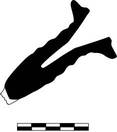
485. Cooking Pan (Early Roman)
P. H. .053. Est. diam. rim .28 (1/10 preserved).
K/L16/17.0100:32. Single sherd, rim to just below carination/floor. Granular reddish-brown (2.5YR 5/4) fabric with frequent small light inclusions. Surface gray. The vessel is not flat below the carination so no part of the floor is extant.
Cf. P29, but with no groove on rim.
svg/K-L16-17.0100-32.jpg
486. Baking pan with ledge rim
D20.0334:6. PH. 2.5; est. D.rim 30; Th.1. Preserving 1/6 of rim. Pinkish fabric, red slipped interior, blackened exterior.
svg/D20.0334-6.jpg
487. Baking pan with ledge rim (AD 150 - 175)
D20.0245:2. PH. 2.3; est. D.rim 31; Th. 1.1. Preserving 1/6 of rim. Gritty pinkish fabric (2.5YR 6/4) with silver mica and lime inclusions. Blackening exterior.
svg/D20.0245-2.jpg
488. Baking Pan, Phocaean
P. H. .029. Est. diam. rim .26 (<1/10 preserved). Th. .008.
K/L16/17.0120:15. Single rim sherd with upper wall. Coarse light brown (7.5YR 6/4) fabric with added sand and varied smaller inclusions, occasional small golden mica visible on surface. The exterior surface is burned black and this discoloring intrudes into the fabric. Interior surface is unslipped but the top of the rim carries thin gray wash.
Same rim form also in Phocaean fabric at , no. 91.
svg/K-L16-17.0120-15.jpg
489. Gritty Gray Cookingware Flanged Casserole
P. H. .049. Est. diam. rim .026 (<1/10 preserved). Th. .006.
K/L16/17.0118:16. Single rim sherd to floor. The coarse fabric has a reddish-brown (2.5YR5/6) core, darker towards burned exterior. The interior surface is pink (10R 6/6). The outer wall is lightly ridged. Distinct ridge to hold lid.
svg/K-L16-17.0118-16.jpg
490. Gritty Gray Cookingware Flanged Casserole
P. H. .036. Est. diam. rim .30 (<1/10 preserved). Th. .007.
K/L16/17.0434:15. Single rim sherd, incurved rim. Coarse brown (7.5YR 4/3) fabric with frequent sandy light and dark bits.
svg/K-L16-17.0434-15.jpg
491. Flanged Casserole, Regional
P. H. .046. Est. diam. rim .32 (1/10 preserved). Th. .011.
K/L16/17.0474:7. Coarse light brown (2.5YR 6/6) fabric with frequent varied inclusions ranging in size up to .003 m. Interior surface is slightly darker than fabric, exterior is tinged gray from use. The flange and short rim are well defined. There is no ridging on the exterior.
no. 91 for form.
svg/K-L16-17.0474-7.jpg
492. Baking Dish
P. H. .065. Est. diam. rim near .33 (1/7 preserved). Th. .01.
K/L16/17.0114:11. Two joining sherds from rim to floor. Coarse brown (5YR 5/8) fabric with large quartz, rounded red and darker, and other smaller inclusions, among them golden mica. Surface is coated and fired light red (2.5YR 5/6).
Cf. P32-P48.
svg/K-L16-17.0114-11.jpg
493. Baking Dish
P. H. .05. Est. diam. rim .34 (1/10 preserved). Th. .011.
K/L16/17.0118:15. Single rim sherd. Coarse brown (2.5YR 6/8 and lighter) with very frequent inclusions ranging from angular quartz up to .002 in length to varied angular red, whitish, and darker bits. There is also gold mica, some visible on surface. The occasional voids are both elongated and rounded. The surface is otherwise coated and dull brown (5YR 6/4). Distinct ridge for holding lid.
Cf. P32-P48.
svg/K-L16-17.0118-15.jpg
494. Gritty Gray Cookingware Flanged Casserole
P. H. .049. Est. diam. rim .30 (1/12 preserved). Th. .0084.
K/L16/17.0100:34. Single rim sherd. Coarse brown (2.5YR 4/4) fabric with frequent, mostly light sand angular inclusions. Surface near black. Light exterior ridging.
svg/K-L16-17.0100-34.jpg
495. Gritty Gray Cookingware Flanged Casserole
P. H. .042. Est. diam. rim .21 (1/10 preserved). Th. .008.
K/L16/17.0417:14. Single sherd preserves <1/10 rim circumference. P.H. .042, est. D. rim near .22, Th. wall .008. Single rim sherd. Coarse brown (7.5YR 4/4) fabric with frequent large angular white chunks and smaller angular light and dark bits. Surface is coated reddish-brown (2.5YR 5/3 and lighter).
Cf. P51.
svg/K-L16-17.0417-14.jpg
496. Gritty Cookingware Casserole
P. H. .053. Est. diam. rim .22 (1/5 preserved). Th. .0072.
K/L16/17.0084:13. Single rim sherd. Coarse varied reddish-brown (near 5YR 5/3) with frequent light angular inclusions. The surface is fired pale red (around 10R 6/4). [[drawing needs to be traced]]
Cf. P51.
497. Gritty Gray Cookingware Flanged Casserole
P. H. .051. Est. diam. rim .30 (1/7 preserved). Th. .0055.
K17.0845:3. Single rim sherd, flange and inturned rim to lower floor. Brown (5YR 4/6) fabric with occasional large quartz, up to .001, and frequent angular light bits. All preserved surfaces are a uniform dark gray. Exterior is ridged.
Cf. P51.
svg/K17.0845-3.jpg
498. Gritty Gray Cookingware Flanged Casserole
P. H. .06. Est. diam. rim .28 (1/5 preserved). Th. .0067.
K/L16/17.0106:1. Single rim sherd. Coarse fabric with frequent angular quartz/sand inclusion. Greenish-brown core (10YR 5/3), brown layer (5YR 5/6), blackened surfaces.
Cf. P51.
svg/K-L16-17.0106-1.jpg
499. Gritty Gray Cookingware Flanged Casserole
P. H. .068. Est. diam. rim .23 (1/10 preserved). Th. .009.
K17.0777:35. Single rim sherd. Coarse, dark brown fabric (5YR 4/4) with frequent large angular and sub-angular quartz, up to .002, inclusions as well as varied other angular bits. Surfaces are near black. Rim is slightly overhanging. No ridges on exterior.
Cf. P51.
K17.0777-35.jpg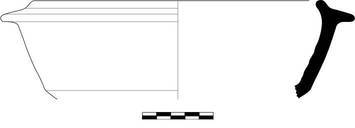
500. Casserole with ledge rim (4th Century AD)
H17.0780:1. PH. 2.9; est. D.rim 18; Th. 0.5. Preserving 1/10 of rim. Gritty gray fabric completely blackened fabric with gold mica.
svg/H17.0780-1.jpg
501. Casserole, ledge rim. Regiona
H17.1159:6. PH. 2.8; est. D.rim 15.5; Th. 0.8. Preserving 1/6 of rim and wall. Shallow ridges exterior. Brown fabric with bits of white sand silver mica and lime on surface.
With Coin of Arcadius (C0307, 383-408).
svg/H17.1159-6.jpg
502. Gritty Gray Cookingware Flanged Casserole
P. H. .068. Est. diam. rim .22 (1/10 preserved). Th. .009.
M18.0612:1. Single rim sherd. Dark brown fabric (5YR 4/4) with frequent large angular and sub-angular quartz, up to .002, inclusions as well as varied other angular bits. Surfaces are near black. Rim is slightly overhanging.
Cf. P51.
M18.0612-1.jpg
503. Gritty Gray Cookingware Flanged Casserole
P. H. .029. Est. diam. rim .26 (1/12 preserved). Th. .0057.
M18.0099:13. Coarse fabric is black, perhaps from use. Inclusions consist of frequent angular and rounded small light lime and quartz and surrounding tiny bits. Surface is reddish gray (around 5YR 5/2). Incurved lip is distinctly tooled. Exterior lightly ridged.
Cf. P51.
M18.0099-13.jpg
504. Gritty Gray Cookingware Flanged Casserole
P. H. .054. Est. diam. rim .18 (1/10 preserved). Th. .0063.
M18.0099:11. Single rim sherd. Fabric is mostly black, perhaps from use, with parts remaining very dark brown. Inclusions and surface as #10, though with occasional large angular .002 chunks of quartz visible.
Cf. P51.
M18.0099-11.jpg
505. Gritty Gray Cookingware Flanged Casserole
P. H. .028. Est. diam. rim .18 (1/12 preserved). Th. .004.
M18.0099:9. Single rim sherd. Coarse brown (5YR 5/4) fabric with frequent small light inclusions and frequent varied bits. Surface coated and just darker (5YR 5/3), exterior narrowly ridged.
Cf. P51.
M18.0099-9.jpg
506. Gritty Gray Cookingware Flanged Casserole
P. H. .04. Est. diam. rim .17 (1/8 preserved). Th. .005.
M18.0099:10. Single rim sherd. Coarse fabric is black with a feint reddish brown (5YR 3/3) core, probably from use. Inclusions consist of frequent angular and rounded small light lime and quartz and surrounding tiny bits. Surface is coated black and slip contains mica flattened by turning. Exterior is lightly ridged.
Cf. P51.
M18.0099-10.jpg
507. Unclassified Cooking Ware Cookpot (Roman?)
P. H. .02. Est. diam. rim .12 (1/10 preserved). Th. .003.
K/L16/17.0169:9. Single rim sherd. Granular brown (2.5YR 4/4) fabric with added sand, gray near and on exterior surface. Highly micaceous, particularly on exterior where mica flakes appear flattened. Interior fired red brown.
svg/K-L16-17.0169-9.jpg
508. Gritty Gray Cookpot (Early Roman)
P. H. .039. Est. diam. rim .16 (1/12 preserved). Th. .0057.
K/L16/17.0120:21. Single rim sherd, with upper wall. Gray (2.5YR 5/1) farbic with distinct redder (2.5YR 6/6) layering in thickened rim. Angular quartz inclusions and frequent lighter bits.
Similar form at no. 78 and no. 111.
svg/K-L16-17.0120-21.jpg
509. Gritty Gray Cookware Cookpot Rim (Roman)
P. H. .035. Th. .005.
K/L16/17.0427:10. Single rim sherd. Granular dark gray(10YR 3/1) fabric has occasional quartz and other large angular inclusions as well as much added sand. Surface is gray with large inclusions showing through the coating/self-slip.
svg/K-L16-17.0427-10.jpg
510. Gritty Gray Cookware Cookpot Rim (Roman)
P. H. .046. Est. diam. rim .20 (1/10 preserved). Th. .0055.
K/L16/17.0427:11. Compact, hard fabric has a dark gray core surrounded by a brown (2.5YR 5/4) layer and then back to gray at surface. There are occasional large (up to .003) angular quartz inclusions and much added sand. The surface is gray with large inclusions showing through the minimal coating/self-slip. Same fabric as no. :10.
svg/K-L16-17.0427-11.jpg
511. Gritty Gray Cookware Cookpot Rim (Roman)
P. H. .038. Est. diam. rim .26 (1/10 preserved). Th. .006.
K/L16/17.0427:12. Single rim sherd. Compact, gray (5PB 5/1 on Gley 2 page) with frequent small white inclusions; no oversize inclusions are visible. Fabric is fired darker just beneath surface but surface itself returns to a gray near the core. Same fabric as no. :13.
svg/K-L16-17.0427-12.jpg
512. Gritty Gray Cookware Cookpot Rim (Roman)
P. H. .061. Est. diam. rim .29 (1/10 preserved). Th. .065.
K/L16/17.0427:13. Single rim sherd. Granular, dark gray (5Y 4/1) fabric with frequent small white inclusions. Surface also dark gray.
svg/K-L16-17.0427-13.jpg
513. Gritty Gray Cookware Cookpot Rim (Roman)
P. H. .034. Est. diam. rim .22 (1/10 preserved).
K/L16/17.0434:12. Single rim sherd. Compact fabric. This vessel has a dark reddish brown (2.5YR 3/4) core becoming darker towards the dark gray surfaces. The inclusions are small to tiny, mostly white and angular but varied as well.
svg/K-L16-17.0434-12.jpg
514. Gritty Gray Cookware Cookpot Rim (Roman)
P. H. .032. Est. diam. rim near .30 (<1/10 preserved). Th. .0045.
K/L16/17.0434:13. Single rim sherd. Granular fabric, brown (5YR 4/4) core becomes darker towards the dark gray surfaces. The very frequent inclusions are mostly small to tiny white angular lime, etc. but there are occasional “reflective” elongated, .0015 in length, bits. Silver mica is also flattened on the surfaces. There are occasional small irregularly shaped voids.
svg/K-L16-17.0434-13.jpg
515. Gritty Gray Cookware Cookpot Rim (Roman)
P. H. .075. Est. diam. rim .24 (1/8 preserved). Th. .045.
K/L16/17.0434:16. Single sherd, thickened rim with attached horizontal handle. The brown (5YR 4/4) core turns darker towards the dark gray surfaces. Granular fabric, frequent angular light and dark sandy bits.
svg/K-L16-17.0434-16.jpg
516. Gritty Gray Cookware Cookpot Rim (Roman)
P. H. .041. Est. diam. rim .23 (<1/10 preserved). Th. .065.
K/L16/17.0434:14. Single rim sherd with horizontal handle. Slightly granular fabric, very frequent small angular lime and varied bits. The brown (5YR 4/4) core becomes darker towards the dark gray surfaces.
svg/K-L16-17.0434-14.jpg
517. Gritty Gray Cookware Cookpot Rim (Roman)
P. H. .086. Est. diam. rim >.30 (<1/20 preserved). Th. .011.
K/L16/17.0434:17. Two joining sherds with attachment point of horizontal handle. Coarse fabric is unevenly fired with gray (7.5YR 6/1) core, surrounding brown (2.5YR 5/6) layer turning to dark gray at the surfaces. The inclusions are frequent and varied. The largest is a sharp quartz chunk .005 in length. There are also lime chunks up to .003 in length, and then an assortment of smaller generally angular inclusions of all colors from white to reddish to dark. There are also large silver mica flakes in the fabric and on the surface. This is a distinctive piece within the cookware assemblage at Ilion.
svg/K-L16-17.0434-17.jpg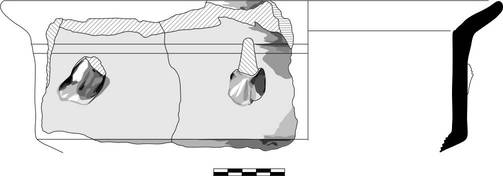
518. Gritty Gray Cookware Cookpot Rim (Roman)
P. H. .045. Est. diam. rim .24 (<1/10 preserved). Th. .007.
K/L16/17.0434:23. Single rim sherd. Granular fabric, brown (5YR 4/4) core becomes darker towards the dark gray surfaces. The very frequent inclusions are mostly small to tiny light bits. Exterior surface is pale reddish (5YR 6/3) in patch.
svg/K-L16-17.0434-23.jpg
519. Gritty Gray Cookware Cookpot Rim (Roman)
P. H. .03. Est. diam. rim .14 (1/10 preserved). Th. .0045.
K/L16/17.0467:14. Single rim fragment with flaring rim, grooved on outer face of rim and interior concave band. Gritty gray fabric (5Y 5/1) with frequent mica and angular opaque stone inclusions. Brushed surface is slightly darker.
svg/K-L16-17.0467-14.jpg
520. Gritty Gray Cookpot Rim (Roman)
P. H. .035. Est. diam. rim near .32 (1/10 preserved). Th. .0054.
K/L16/17.0467:16. Single rim fragment. Flaring thickened triangular rim with flattened outer face and concave inner band. Granular brown (7.5YR 5/2) fabric with frequent angular inclusions. Surface fired dark gray.
svg/K-L16-17.0467-16.jpg
521. Gritty Cookware Cookpot
P. H. .032. Est. diam. rim .16 (1/10 preserved). Th. .004.
K/L16/17.0144:9. Single rim sherd. Coarse, dark brown (7.5YR 4/3) fabric with frequent angular quartz and varied sand inclusions. The surface is coated gray with many inclusions plainly visible, though flattened by turning. Cf. Kozal 2001, no. 112.
svg/K-L16-17.0144-9.jpg
522. Gritty Cookware Cookpot
P. H. .051. Est. diam. rim .22 (<1/20 preserved). Th. .006.
K/L16/17.0467:20. Single rim sherd. Compact fabric. Pale greenish brown (10YR 5/3) core with feint red-brown layer turning to dark gray at surfaces. Inclusions range from a single observed large, .004, angular chunk of quartz to assorted smaller bits, most of which are light. Occasional silver mica in fabric and flattened on surface.
svg/K-L16-17.0467-20.jpg
523. Cooking pot
H17.0763:25. PH. 5.3; est. D.rim 29; Th. 0.8. Preserving 1/6 of rim and wall. Everted lip, low vertical neck, hand pressed clay applied exterior of rim as decorative. Brown red (2.5YR 5/6 and 5/8) granular highly limey and with silver mica, lime or shell bits visible on surface.
Tekkok 2001, 368, n.163, pl.17.
svg/H17.0763-25.jpg
524. Cooking pot. Regional (3rd Century AD)
H17.0763:24. PH. 11.6; est. D.rim 26; Th. 0.7. Everted lip, rounded body with low vertical neck. Pinkish buff fabric with blackened surface.
Tekkok 2001, 368, n.163, pl.17.
svg/H17.0763-24.jpg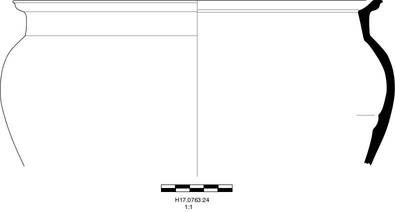
525. Cooking Pot
D20.0290:11. PH. 8.6; est.D.rim 24; Th. 0.6. Preserving 1/6 of rim and wall. Brown gritty fabric with silver mica.
526. Gritty Cookware Cookpot
P. H. .094. Est. diam. rim .25 (1/10 preserved). Th. .004.
K/L16/17.0084:12. Two joining sherds, rim, neck and upper wall. Granular dark reddish brown (5YR 4/4) fabric with frequent small angular light bits. Surface caoted and fired reddish-gray (5YR 5/2). Everted rim with offset underneath; high neck and rounded body.
Cf. , no. 169.
527. Gritty Cookware Cookpot
P. H. .07. Est. diam. rim .18 (<1/10 preserved). Th. .006.
K/L16/17.0148:10. Coarse dark greenish gray (5Y 3/2) with frequent large rounded and angular quartz on other stone inclusions as well as varied smaller bits. The darker gray to black surface is smoothed in places. Unusual fabric and form.
svg/K-L16-17.0148-10.jpg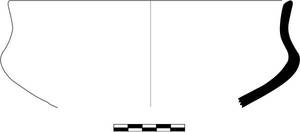
528. Regional Sanded-Oxydized Cooking Ware Lid
P. H. .04. Th. .0046.
K/L16/17.0112:6. Single sherd. Granular, pale brown (5YR 6/4, darker near surfces) fabric with occasional quartz and other varied tiny inclusions. Coated surface is dull red (10R /54) where preserved. A relatively large lump of iron is adhering near the knob.
svg/K-L16-17.0112-6.jpg
529. Lid, cooking pot. Phocaean.
D20.0290:6. . PH. 1.4; est. D.rim 34?; Th. 0.6.. Preserving 1/20 of rim. Deep turning marks on wall. Pinkish buff gritty fabric (2.5YR 6/4) traces of blackening exterior on lid.
svg/D20.0290-6.jpg
530. Lid, cooking ware.
D20.0235:18. PH. 5.7; Th. 0.6. Preserving 1/6 of wall. Wavy lines over rim, irregular punched dots. Micaceous brown fabric with wavy lines blackened on top. Import. (also in I17.647:8 make up 4th cent portico)
531. Cooking pot lid (3rd Century AD)
D20.0209:2. PH. 4.7; est. D.knob 3.2; Th.0.6. Preserving complete knob, 1/4 of lid without rim. Knob slightly irregular with an off centered pierced hole. Pinkish brown fabric (2.5YR 5/6) hard fired.
532. Gritty Cookware Lid
P. H. .015. Est. diam. rim near .31 (1/8 preserved). Th. .006.
K/L16/17.0114:45. Single edge sherd. Granular, red (10R 5/8, browner towards edge) fabric with frequent small angular white inclusions and golden mica, some flattened on surface. The plain surface is brown.
svg/K-L16-17.0114-45.jpg
533. Gritty Cookware Lid
K/L16/17.0114:44. P.H. .013, est. D. edge ~.16, Th. .055 (<1/20 preserved). Single edge sherd. Coarse light red (near 10R 6/6) fabric is unevenly fired with frequent added light and dark sand, inlcuding larger dark angular bits. Patches of the vessel have been discolored gray throughout from use or post-depositional heat. The rough surface is gray.
svg/K-L16-17.0114-44.jpg
534. Cooking pot, lid (Fifth Century AD)
H17.0044:5. PH. 5.2; est. D.rim 24; Th. 0.7. Preserving 1/6 of rim. Pinkish buff fabric completely blackened.
535. Small Pot (Late Roman)
H17.1087:9. PH. 3.4; est. D.rim 9; Th.0.6. Preserving 1/10 of rim. Pinkish brown fabric (2.5YR5/8) very fine silver mica visible on surface. Cracks inside due to lime content.
svg/H17.1087-9.jpg
536. Cooking pot. Regional (6th Century AD)
H17.0044:4. PH. 5.5; est. D.rim 22; Th. 0.7. Preserving 1/10 of rim. Deep ridge exterior of wall. Pinkish buff fabric (2.5YR 6/6) blackened exterior.
Same fabric as H17.56:5.
svg/H17.0044-4.jpg
537. Cooking pot (or Bowl?), ledge rim. Regional (4th to 5th Century AD)
H17.0050:9. PH. 8.9; est. D.rim 26; Th. 0.6. Preserving 1/10 of rim and wall. Shallow groove on rim, ridges on lower wall. Pinkish red (2.5YR 4/6) fabric with granular bits of white sand, gold mica.
Similar one in 32:25 also in K17.752:5.
svg/H17.0050-9.jpg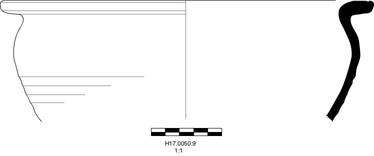
538. Cookpot, horizontal rim
P. H. .095. Est. diam. rim .19 (1/5 preserved). Th. .006.
K17.0752:5. Single sherd preserves rim, handle and body to below handle. Shallow grooves on upper face of rim, wide oval handle. Dark brown (2.5YR 4/4) granular fabric with very frequent added sand, mostly light, and mica. Interior is dull red (2.5 5/4), exterior becomes gray on handle and towards lower preserved wall.
539. Late Roman Cookpot, ledge rim.
P. H. .069. Est. diam. rim .14 (1/10 preserved). Th. .005.
H17.0069:8. Single groove on rim, deep ridges exterior of wall double handles with oval profile. Brown granular fabric with lots of gold mica on surface.
Fabric as K17.0752:5
H17.0069-8.jpg
540. Late Roman Cookpot, Thickened and Grooved Rim
P. H. .045. Est. diam. rim .13 (<1/10 preserved). Th. .0045.
I17.0647:11. Two joining rim sherds. Granular fabric unevenly fired with gray core (GLEY 1 7/1) and light red (2.5YR 6/8) layer. Frequent angular inclusions including golden mica on surface. Also a single large, .0025, chunk of quartz is extant intruding on the interior surface. Surfaces are coated and fired variably but all close to dull reddish-brown (2.5YR 5/3).
Cf. "Local Pot Type III", p. 45 and plate 35, no. 5.
I17.0647-11.jpg
541. Late Roman Cookpot, Thickened and Grooved Rim
P. H. .04. Est. diam. rim .20 (1/10 preserved). Th. .0045.
I17.0819:1. Single rim sherd. The granular brown (5YR 4/3) fabric has abundant added sand, and turns to black just under the surface. The surface itself is variably fired. The interior is dull reddish-brown (near 2.5YR 4/2), the outer edge of the rim is comparatively light (5YR 6/6), and the exterior proper is again dull reddish-brown (2.5YR 5/4).
Near "Local Pot Type III", p. 45. Found with coin of Theodosius (C0306).
I17.0819-1.jpg
542. Late Roman Cookpot, Everted Rim (4th to 5th Century AD)
P. H. .042. Est. diam. rim .26 (1/10 preserved). Th. .005.
D20.0183:10. Single sherd, everted ledge rim. Brown highly granular fabric, fine silver and gold mica visible on surface with bits of white sand. Blackened exterior.
543. Cookpot with ledge rim
P. H. .022. Est. diam. rim .20 (1/8 preserved). Th. .006.
C/D20.0407:2. Brown granular fabric (2.5YR 5/4), lots of inclusions visible on surface opaque quartz, lime, black stones fine silver mica. (Clearing fill associated with the robbing of a wall on the East Side).
svg/C-D20-21.0407-2.jpg
544. Cooking pot. Regional (5th to 6th Century AD)
H17.0029:6. PH.4.5; est. D.rim 15; Th. 0.6.Everted rim, wheel ridging on wall. Preserving 1/10 of rim. Not used, no blackening. Brown fabric (2.5YR 3/4) with shelly lime bits.
545. Cookpot with ledge rim
P. H. .03. Est. diam. rim .14 (1/6 preserved). Th. .005.
D20.0037:6. Deep groove on rim.Brown granular fabric (2.5YR 4/3 and 4/4) opaque quartz and lime visible on surface.
D20.0037-6.jpg
546. Late Roman Cookpot, Flaring Rim
P. H. .044. Est. diam. rim .20 (1/12 preserved). Th. .0044.
M18.0099:16. Two joining rim sherds. "Purple Micaceous Fabric". Brown (5YR 4/2) core, red (2.5YR 5/8) under surface, frequent rounded and angular lime and “quartz”, frequent golden mica. Surface is coated, fired to light red (5YR 6/4) on upper inner face of rim, weak red (2.5YR 5/2) and lighter in other extant parts of outer and inner rim and wall.
Deep cook pots with flaring rims are common in late antiquity. E.g., nos. 220-224 from a later context. Also, see "Local Pot Type V", p. 46. These are related to the widely exported Aegean cookpot with brick red-fabric and black surface CATHMA 25 ().
M18.0099-16.jpg
547. Late Roman Cookpot Rim and Strap Handle
P. H. .025. Th. .012.
I17.0647:7. Single rim sherd with handle. Black fabric with frequent added sand and much mica, especially visible on the underside of the handle. Dull reddish brown (2.5YR5/3) surface on handle. Gray on extant interior and exterior.
I17.0647-7.jpg
548. Cookpot, everted rim
P. H. .023. Est. diam. rim .15 (1/6 preserved). Th. .005.
C/D20/21.0413:24. Granular pink fabric (2.5YR 5/4) if not blackened, quartz particles in section and fine silver mica.(Clearing fill associated with the robbing of a wall on the West Side)
svg/C-D20-21.0413-24.jpg
549. Cooking pot, everted rim. Regional (5th Century AD)
H17.0053:15. PH. 4.5; est. D.rim 16; Th. 0.6. Preserving 1/6 of rim. Pinkish brown fabric (10R 4/8) granular chunks of opaque quartz and lime.
550. Cooking pot, everted rim
D20.0235:5. PH. 3.4; est. D.rim 20; Th. 0.4. Preserving 1/8 of rim. Brown hard fabric, fired black on surface. (75:3)
551. Cooking pot, everted rim
D20.0106:1. PH.5.3; est. D.rim 21; Th. 0.6. Preserving 1/6 of rim. Brick red fabric (2.5YR 4/6) highly granular fabric with silver mica and lime inclusions, self slip, blackened exterior.
552. Cooking pot, everted rim (late 5th AD)
C/D20/21.0413:24. PH. 2.3; est. D.rim 15; Th. 0.5. Preserving 1/6 of rim. Granular pink fabric (2.5YR 5/4) if not blackened, quartz particles in section and fine silver mica.
553. Late Roman Cookpot, Flaring Rim
P. H. .04. Est. diam. rim .14 (1/6 preserved). Th. .003.
K17.0068:50. Single rim sherd preserving upper wall. The granular orange-red (2.5YR 5/8) fabric has frequent large angular inclusions up to .005 in length, as well as frequent smaller varied bits. The thickly coated exterior surface is bright orange (between 2.5YR 7/8 and 6/8). The interior is dull brown (2.5YR 5/3). Neither the interior nor exterior slip hides the frequent large angular inclusions, though these are less visible on the exterior.
K17.0068-50.jpg
554. Late Roman Cookpot, Ledge Rim (5th Century AD)
P. H. .054. Est. diam. rim .18 (over 1/6 preserved). Th. .005.
D20.0061:4. Single rim sherd, eep groove on rim. Brown granular fabric (5YR 5/4) opaque quartz, red stones, lime pocks on surface.
555. Late Roman Cookpot, Rolled Rim (5th Century AD)
P. H. .043. Est. diam. rim .19 (1/10 preserved). Th. .004.
D20.0056:9. Single rim sherd, eep groove on rim. Brown granular fabric (5YR 5/4) opaque quartz, red stones, lime pocks on surface.
556. Cooking pot, rolled lip.??
H17.1175:14. PH.3.5; est. D.rim 8; Th. 1. Preserving 1/20 of rim. Pinkish red (2.5YR 5/6) very granular limey fabric with fine bits of silver mica.
Check comparanda?? Also in D20.56.
557. Cooking pot, flanged rim
C/D20/21.0404:1. PH.2.3; est. D.rim 14; Th. 0.7. Preserving 1/6 of rim. Deep groove exterior of the lip. Granular orange brown pink (5YR 5/4) with chunks of black stones, quartz particles. Blackened exterior of rim. (ARS 91 type of rim) (Another one in 394:3)
558. Cookpot, flanged rim
P. H. .023. Est. diam. rim .14 (1/6 preserved). Th. .007.
C/D20/21.0394:3. Granular orange brown pink (5YR 5/4) with chunks of black stones, quartz particles. Blackened exterior of rim. Rim form similar to African Red Slip Ware Hayes Form 91.
svg/C-D20-21.0394-3.jpg
559. Cookpot with ledge rim
P. H. .047. Est. diam. rim .22 (1/20 preserved). Th. .006.
H17.0032:25. Deep ridges on exterior wall.Blackened exterior of rim. Pinkish red granular fabric (2.5YR 5/4), with bits of opaque quartz, lime and silver mica.
H17.0032-25.jpg
560. Late Roman Cookpot Base
P. H. .012. Est. diam. base .15 (1/8 preserved). Th. .009.
I17.0734:2. Single base sherd. "Purple Micaceous Fabric". Almost black (GLEY1 3/1) fabric with angular quartz inclusions and frequent tiny bits. Heat induced flaking on underside exposes frequent mica flakes. Patches on underside are reddish-brown (5YR 5/6).
I17.0734-2.jpg
561. Late Roman Cookpot Base
P. H. .012. Est. diam. base .13 (1/4 preserved). Th. .006.
K17.0736:11. Single base sherd, thickened near center. "Purple Micaceous Fabric". Almost black (GLEY1 3/1) fabric with angular quartz inclusions and frequent tiny bits. Heat induced flaking on underside exposes frequent mica flakes. Patches on underside are reddish-brown (5YR 5/6).
K17.0736-11.jpg
562. Late Roman Cookpot Base (4th to 5th Century AD)
P. H. .027. Est. diam. base .28 (1/20 preserved). Th. .009.
D20.0183:14. Gritty brown granular fabric with lots of lime in section, and fine sand inclusions. See also I17.734:2 (coin of Arcadius), and K17.736:11.
563. Vessel Stand (Late Roman)
Est. diam. base 18 (1/6 preserved). Th. .0095.
N18.0030:1. Granular red (btw. 2.5YR 5/4 and 5/6) fabric with frequent angular quartz and other varied bits. Coated surface fired red (2.5YR 6/6); interior closer in color to fabric; darker gray in inner face of lower edge.
N18.0030-1.jpg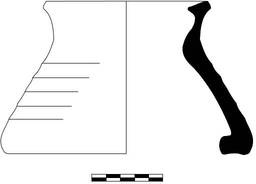
564. Vessel Stand (Late Fourth to Fifth Century AD)
Est. diam. base 20 (1/6 preserved). Th. .01.
D20.0248:1. Deep ridges on wall. Incurving rim profile. Pinkish buff granular cooking ware fabric, blackened underbase. Similar in I17.647:14 M18.30:1.
565. Base for cooking (4th to 5th Century AD)
H17.0056:3. PH. 2.7; est. D.base 15; Th. 1.4. Preserving 1/4 of base. Pinkish buff fabric partially blackened exterior.
svg/H17.0056-3.jpg
566. Storage vessel. Local (3rd Century AD)
H17.0763:23. PH. 9.0; est. D.rim 20; Th. 0.8. Preserving 1/6 of rim. Everted rim with heavy walls. Pinkish buff fabric with creamy surface.
svg/H17.0763-23.jpg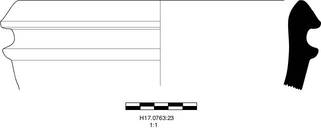
567. Storage Amphora, Local
H17.0730:3. PH. 5.0; Th. 1.2. Preserving a single wall fragment. Pinkish buff fabric fired cream on surface. Combed decoration wavy lines horizontal lines.
568. Bowl, ledge rim. Local (5th to 6th Century AD)
H17.0029:3. H. 3.5; est. D.rim 25; Th. 0.8. Incised wavy lines on rim, and on wall. Deep ridge on wall where the decoration was done. Preserving 1/20 of rim. Pinkish buff (2.5YR 6/6) hard fabric, core fired gray. Similar to 1175:10.
569. Storage basin (Pithos?), Local (4th - 5th Century AD)
D20.0183:8. PH. 6.4; est. D.rim 44; Th. 2. Preserving 1/10 of rim. Wavy line decoration incised on rim, deep wheel ridges exterior. Pale buff fabric (5YR 7/4) fired cream on surface.
570. Storage Basin. Local
H17.0053:17. PH. 5.1; est. D. rim 42; Th. 1.6. Incised thick wavy lines over the rim. Preserving 1/20 of rim. Pinkish red granular fabric with lots of shelly lime bits and silver mica.
571. Storage basin. Local.
H17.0053:16. PH. 4.3; est. D.rim 37; Th. 1. Vertical incised pattern decoration over rim. Applied clay around rim. Preserving 1/8 of rim. Pinkish red granular fabric with lots of shelly lime bits and silver mica.
572. Basin
P. H. .0352. Est. diam. rim .25 (1/20 preserved). Th. .0047.
P18.0061:2. Single sherd. Heavy downturned rim, rolled hatching motif on upper surface. Granular reddish brown (2.5YR 6/6) fabric with frequent light with tiny dark inclusion, many visible on surface.
Cf. Bieg, Tekkok and Aslan, no. 40.
573. Basin, ledge rim. Local.
C/D20/21.0407:17. PH. 2.8. est. D.rim 33; Th. 0.8. Scraped wavy lines around rim. Preserving 1/10 of rim. Granular pinkish/red fabric (10R 5/6) fired brown around rim.
svg/C-D20-21.0407-17.jpg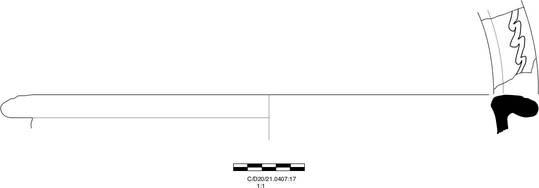
574. Amphora. Regional.
D20.0211:7. PH. 8.7; est. D.rim 10; Th. 0.5. Preserving 1/8 of rim and neck. Everted rim, wheel ridges on neck. Pinkish red granular fabric (10R5/6) with grayish bits, lime and opaque quartz inclusions, fired cream on surface.
Villa of Dionysos (Hayes 1983, 154, n.86, fig.25, AD 230).
575. Amphora (5th Century AD)
D20.0061.001. P0389. Preserving rim, neck and shoulder. Wavy lines on shoulder and inscribed letters on shoulder reads Xhi-Rho followed by TPY ANP. Orangish buff hard fabric(5YR 7/4) fired cream on surface, no mica.
svg/P0389.jpg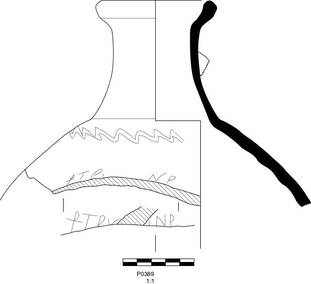
576. Amphora with rolled heavy lip (2nd to 3rd Century AD)
D20.0017:14. SC17-10. PH.11.6; est. D.rim 17; Th. 1.5. Preserving 1/4 of rim and wall. Pinkish red gritty fabric (2.5YR 5/6). (similar to D20.65:120
577. Amphora. Italian (2nd to 3rd Century AD)
D20.0017:20. PH. 13.3; est. D.base 9.8; Th.1.1. Preserving half of molded base with a knob under, fairly heavy walls. Pinkish buff fabric (2.5YR 6/6) fired cream on surface, opaque white stones very fine silver mica.
578. Unclassified Dressel 1 Type Amphora (1st Century BC)
P. H. .093. Est. diam. rim .18 (1/10 preserved). Th. .015.
K/L16/17.0427:40. Single sherd with rim, upper neck, and handle attachment. The light red (2.5YR 7/6) fabric is compact with many large rounded bits of previously fired red (2.5YR 5/8) clay as much as .004 in length but mostly much smaller. There are other angular and rounded inclusions that are both light and dark. Just beneath the surface, the fabric is fired light green gray (2.5Y 6/2). The plain surface is buff (2.5Y 8/2).
svg/K-L16-17.0427-40.jpg
579. Dressel 2-4 Amphora Handle, probably Campanian (1st to 3rd Century AD)
P. H. .11. Th. .05.
K/L16/17.0114:56. Single sherd preserving lower part of double handle. Distinctly granular fabric is predominantly brown (between 2.5YR 5/6 and 6/6) with frequent angular black and other yellow inclusions. This is typical of Campanian fabric. The double handle is typical of Dressel 2/4.
Class 3. A similar piece is published at no. 109.
svg/K-L16-17.0114-56.jpg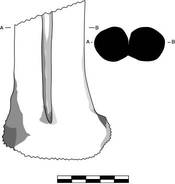
580. Cretan Amphora Neck with Handle Stub, Type AC1b (2nd and 3rd century AD)
P. H. .104. Est. diam. rim .07 (3/4 preserved). Th. .0062.
K17.0749:5. SC17-33. Three sherds with rim and handle stub. Compact, soft pale brown (7.5YR 7/4) fabric with occasional small calcareous inclusions. Surface is coated and paler (7.5YR 8/3). Slightly conical neck and slightly thickened rim.
See AC1b, pp. 70-72; particularly p. 75 for chronology; closest parallels for profile are A37 and A42-44 on fig. 37. See also Middle Roman Amphora 2, pp. 180-183; particularly no. D226; class 41.
svg/K17.0749-4.jpg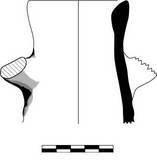
581. Middle Roman Amphora 3 (“Micaceous Water Jar”) Neck with Handle Stub
P. H. .08. Th. .003.
K17.0752:3. SC17-34. Single sherd, incomplete rim and single handle attachment. Fabric and surface brown (2.5 YR 5/4), with frequent mica.
, pp. 183-186; class 45 combines the one and two-handled versions; , plate 41.
svg/K17.0752-3.jpg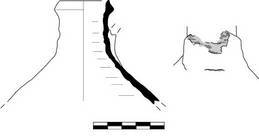
582. Middle Roman Amphora 3 (3rd Century AD)
H17.0730:6. PH. 8.4; est. D.base 4.2; Th. 0.4. Preserving complete base with wall. Brown micaceous fabric (between 2.5YR 4/4 and 4/6) with oily surface, black coating interior.
583. MRA/LRA 3 Rim
P. H. .022. Est. diam. rim .038 (1/4 preserved). Th. .004.
D20.0053:14. Micaceous brown fabric.
svg/D20.0053-14.jpg
584. Middle Roman Amphora 3 (“Micaceous Water Jar”) Neck and Handle
P. H. .061. Th. .004.
K17.0845:10. Single sherd partially preserves neck and single complete handle. Fine brown (5YR 4/4) fabric with rare tiny white inclusions and frequent mica, typical for form. Interior surface is thinly coated with dark pitch.
svg/K17.0845-10.jpg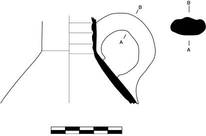
585. Late Roman Amphora 3 ("Micaceous Water Jar") Toe
P. H. .033. Est. diam. base .06 (1/4 preserved). Th. .004.
K17.0389:2. Single toe sherd. Compact brown (7.5YR 4/3) fabric with very frequent small mica flakes. Extant surface is fired to near gray.
K17.0389-2.jpg
586. Water Jar Toe, Regional? (Mid Roman)
P. H. .117. Est. diam. base .067 (completely preserved). Th. .0095.
K17.0881:7. Compact fabric, brown (5YR 6/8). Frequent tiny mica and few tiny dark inclusions. Buff surface with drippping paint visible under accretion.
K17.0881-7.jpg
587. Amphora
D20.0209:4. PH. 9.7; est. D.base 2.5; Th. 1.3. Base partially broken under, preserving complete profile. Deep turning marks on wall. Conical foot. Pinkish brown (2.5YR 5/6) highly micaceous fabric, fired cream on surface.
svg/D20.0209-4.jpg
588. Middle Roman Amphora 4 ("Pinched Handle") Rim and Handle
P. H. .073. Est. diam. rim 11 (1/3 preserved). Th. .005.
K17.0759:7. Single sherd. Dark brown (2.5YR 5/8) fabric with infrequent tiny dark and light inclusions. The surfaces are coated and fired to the same color as the fabric. The extant handle is pinched where it turns down towards the body.
For an overview of the form see , pp. 186-187. The fabric of this piece is perhaps identical to that of Cilician “pinched handle” amphoras as described and illustrated in color at , pp. 329-332. Similar fabric and profile at Knossos ().
svg/K17.0759-7.jpg
589. Mid Roman Amphora 4, Cilician(?)
D20.0017:51. PH. ADD; Th. 1. Brick red fabric (2.5YR 4/6) highly micaceous with white sand inclusions. Red fb from Cilicia by N.Rauh online K17.759:7 (same fb); K17.780:2 (pale fb).
590. Middle Roman Amphora 4 ("Pinched Handle") Rim and Handle
P. H. .087. Est. diam. rim 11 (1/3 preserved). Th. .005.
K17.0780:1. Four joining sherds with rim and one handle. Soft, compact, pale green (2.5Y 8/2) fabric. The frequent inclusions include occasional large angular quartz (.005 in length), rounded lime, chunks of previously fired clay that are more red than the main matrix, and a variety of smaller inclusions. Elongated voids in wall, irregular voids in handle. The surface is plain. Handle is “pinched” at upper angle. The sherds have been conserved.
For an overview of the form see , pp. 186-187. Cf. , no. G199 and , no. 41.
K17.0780-1.jpg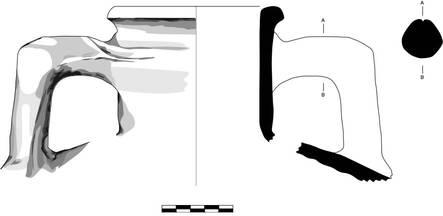
591. Middle Roman Amphora 5 Neck, Rim and Handle
P. H. .115. Est. diam. rim .15 (1/5 preserved). Th. .01.
K17.0759:8. Single sherd with rim and handle, single groove under rim. Coarse fabric. Gray core where wall is thickest but cleanly fired to red (from 2.5YR 5/8 to 2.5YR 6/6) at lower extant neck. Coated exterior surface is brown (2.5YR 5/6) after conservation. Small lime/white bits and angular sand are the most frequent inclusions.
, pp. 188-189.
svg/K17.0759-8.jpg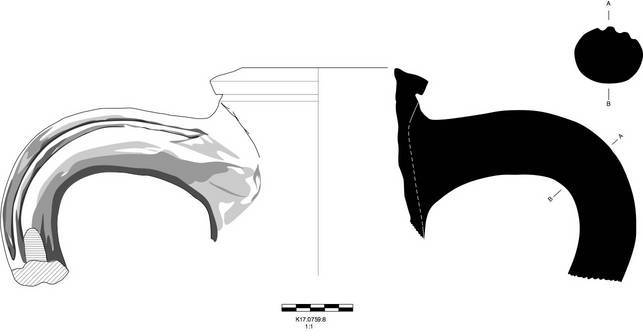
592. Middle Roman Amphora 5 Rim
P. H. .097. Est. diam. rim .15 (1/3 preserved). Th. .008.
K17.0777:28. Single rim sherd with upper neck. Slightly granular brown (2.5YR 5/8) fabric with small white inclusions and occasional mica. Coated surface is slightly paler than fabric. Two slits cut below rim.
K17.0777-28.jpg
593. Middle Roman Amphora 5 Rim
P. H. .038. Est. diam. rim .19 (1/6 preserved). Th. .012.
K17.0845:13. Single sherd, deep grooves under rim. Coarse, dark brown (7.5YR 4/3) at core of rim with frequent varied angular inclusions and gold mica. Exterior surface is predominantly orange (near 2.5YR 6/6), the upper face of the rim and extant inner part of the neck is gray except where worn.
K17.0845-13.jpg
594. Middle Roman Amphora 5 Handle
P. H. .11.
K17.0845:11. Single sherd preserves part of handle. Hard granular, brown (5YR 6/8 and browner) fabric with frequent white angular inclusions. Thin dull red (near 10R 5/6) coat on surface.
svg/K17.0845-11.jpg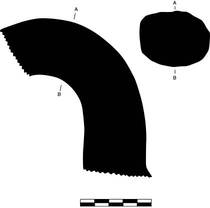
595. Middle Roman Amphora 7 Rim and Handle
P. H. .11. Est. diam. rim .06 (completely preserved preserved). Th. .0065.
K17.0759:9. Single sherd, rim and handle. Well-formed collar below rim. Coarse fabric. Reddish-brown (2.5YR 6/8) fabric with frequent rounded and sub-angular black stones up to .002 in length, as well as frequent small white and varied bits; elongated voids. Surface is coated and ranges from 2.5YR 6/6 to a smokey dull red (2.5YR 5/3 and darker). Sherd has been conserved.
, pp. 189-193; 77; class 47.
svg/K17.0759-9.jpg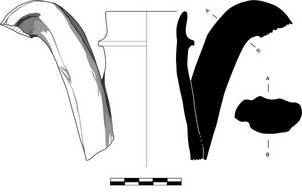
596. Middle Roman Amphora 7
P. H. .082. Est. diam. rim .065 (completely preserved preserved). Th. .012.
D20.0063:5. Single sherd preserved upper neck. Somewhat granular, red fabric with large semi-rounded black bits and frequent smaller inclusions. Neck bulges more than is shown in drawing.
svg/D20.0063-5.jpg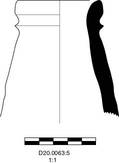
597. Middle Roman Amphora 7
H17.0737:14. PH. 8.7; est. D.base 9.1; Th. 1.1. Preserving complete base. Pinkish brown micaceous fabric.
598. Aegean amphora, Benghazi Mid Roman 7.
D20.0292:1. PH. 3; est. D.base 6; Th. 0.7. Preserving 1/6 of base. Deep turning marks exterior of base. Brown fabric (5YR 5/4), self slip.
Benghazi (Riley 1979, ADD).
599. Middle Roman Amphora 7
H17.0068:23. Handle. PH. 5.7; Th. 2.9. Pinkish red micaceous fabric (2.5YR 4/6) with bits of black stones.
svg/H17.0068-23.jpg
600. Middle Roman Amphora 7 Rim
K17.0777:29. P.H. .061, est. D. rim .072 (1/2 preserved), Th. .013. Single rim sherd. Reddish-brown (5YR 5/4) fabric with frequent small angular inclusions varied from light to dark. Coated surface is also brown (5YR 5/6). Groove with ridge below under rim.
, pp. 189-193; 77; class 47.
K17.0777-29.jpg
601. Middle Roman Amphora 7 Type Handle
K/L16/17.0417:3. Handle with adjacent neck. P.H. .095, Th. across handle .046. Somewhat coarse brown (5YR 6/6) fabric with frequent angular white inclusions and much silver mica. Surface thinly coated but near color of fabric. The mica suggests an southwest Anatolian origin.
, pp. 189-193; 77; class 47.
svg/K-L16-17.0417-3.jpg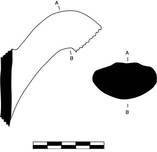
602. Middle Roman Amphora 7 Base
P. H. .165. Th. .008.
K/L16/17.0072:2. Single sherd preserves complete hollow base with lower wall. Slightly granular, brown (7.5YR 6/6) fabric with frequent angular light inclusions, fewer dark, and other mostly light bits. There is some uneven firing, lower wall gray towards interior. Surface coated and redder (5YR 6/4).
, pp. 189-193; 77; class 47.
svg/K-L16-17.0072-2.jpg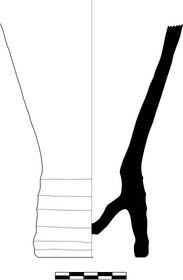
603. Pontic Amphora, Zeest 94
H17.0748:1. PH. 4.6; est. D.rim 4.0; Th. 1.1. Preserving 1/3 of rim and wall. Pale buff porous fabric with black bits and red stone inclusions.
604. Pontic Amphora S IVb/c Rim and Handle (2nd to 4th century AD)
P. H. .125. Est. diam. rim .08 (completely preserved preserved). Th. .0094.
K17.0881:8. Neck with beginning of one handle. Pale (2.5Y 8/3) fabric with very frequent small black inclusions, interspersed with far fewer red chunks. Surface thinly coated to very similar color.
See , pp. 413-415 and fig 7 for discussion of form. Also, , p. 255, type C.
svg/K17.0881-8.jpg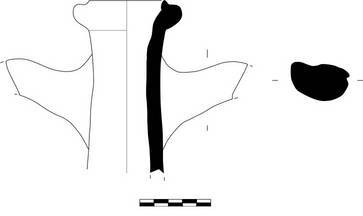
605. Pontic Amphora S IVb/c Rim (2nd to 4th century AD)
D20.0017:26. SC17-11. Single rim sherd. Pale yellow fabric with frequent dark inclusions.
See , pp. 413-415 and fig 7 for discussion of form. Also, , p. 255, type C. A complete example is illustrated from Knossos ().
606. Transport amphora. Zeest 94
D20.0290:2. PH. 6; est. D.base 4.2; Th. 0.5. Preserving complete base, pierced under base. Porous light orange fabric (5YR 7/4) with sand inclusions.
svg/D20.0290-2.jpg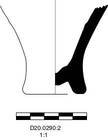
607. Pontic Amphora S IVb/c Toe (2nd to 4th century AD)
P. H. .04. Est. diam. toe .08. Th. .005.
K17.0777:30. Toe with beginning of body. Pale fabric (7.5YR 7/4) with frequent subangular dark bits.
See , pp. 413-415 and fig 7 for discussion of form. Also, , p. 255, type C.
svg/K17.0777-30.jpg
608. Unclassified Amphora
P. H. .09. Est. diam. rim .05 (1/2 preserved). Th. .005.
K17.0759:2. Single sherd with rim and neck, stub of round handle. Slightly granular, light brown (5YR 6/8) fabric with occasional light "quartz" and varied smaller angular inclusions. Coated surface is lighter (5YR 7/4). Thickened, slightly flaring triangular rim.
svg/K17.0759-2.jpg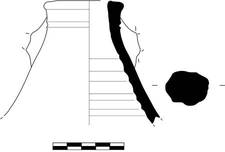
609. Transport amphora
D20.0290:9. PH. 3; est. D.base 6; Th. 0.5. Preserving ½ of base. Orange buff hard fabric (5YR 7/4), self slip.
Benghazi (Riley 1979, ADD).
610. Unclassified Transport Amphora (Early Roman?)
P. H. .049. Est. diam. rim .15 (1/8 preserved). Th. .015.
K/L16/17.0427:34. Single rim sherd. Slightly granular fabric fired to uneven light reddish-brown (10R 6/8), thin core is lighter towards green; some small angular and rounded light, sandy inclusions, as well varied smaller bits. Surface plain. Bulbous neck with thickened rim, groove just below tip.
Dated by 2nd century closing date of context.
svg/K-L16-17.0427-34.jpg
611. Pontic Late Roman Amphora 2 Precursor?
M18.0099:5. Two joining rim sherds. Relatively compact, light red (2.5YR 6/8) fabric with occasional dark grits in addition to tiny white/lime bits. The coated surface is pale.
Similar form at no. 168. That piece is from third century layer of the w28 well.
M18.0099-5.jpg
612. Unclassified Amphora
P. H. .126. Est. diam. rim .14.
K17.0741:13. Single sherd, rim, nack and handle. Squared rim on short vertical neck, thick oval handle. Compact fabric is red (2.5YR 6/8) with small, light angular inclusions. Exterior surface coated beige (7.5YR 8/4). Light groove on neck.
613. Late Roman Amphora 1 Neck and Handles (Late Fifth to Early Sixth Century AD)
P. H. .19. Est. diam. rim .095.
I17.0181:1. Six joining sherds preserve neck, handles and upper body. Reddish fabric (5YR 7/6) fabric becoming buff () towards surface. Frequent varied inclusions, with some occasional lime chunks. Surface smoothed and coated in places. Convex band below rim, two light channels on handles. Upper body preserves ridges as opposed to the wide bands that appear on later versions. Deposition may be associated with the early sixth century earthquake. Dipinti on both sides and under one handle.
614. Late Roman Amphora 1 (Fifth Century AD)
D20.0037:5. PH. 10.1; est. D.rim 10; Th. 1.1. Preserving 1/4 of rim and neck. Regular fabric sandy, gritty in orangish buff (5YR 7/6) with black bits, creamy surface.
615. Late Roman Amphora 1
C/D20/21.0413:25. PH. 8.4; Th. 0.7. Preserving wall where the handle is attached. Pale yellow fabric (10YR 8/4) with black bits.
616. Late Roman Amphora 1
C/D20/21.0413:27. PH. 8.9. Preserving 1/3 of handle. Pale yellow fabric (7.5YR 8/4) fired cream on surface, black bits on the surface.
617. Amphora, Benghazi Riley Late Roman Amphora 1
C/D20/21.0394:4. PH. 8.6. Preserving only 1/3 of handle. Pinkish buff fabric (5YR 6/4) with opaque quartz, fine silver mica, gritty surface.
618. Late Roman Amphora 1
C/D20/21.0413:26. PH. 11.9. Preserving only handle. Pinkish buff fabric (5YR 7/4) with black bits on the surface. Different origin check !!
619. Late Roman Amphora 1 Handle (Fifth Century AD)
P. H. .068. Est. diam. .31.Th. .08.
D20.0053:9. Single sherd, with handle stub. Trace of dipinto on shoulder, not readable. Regular fabric: sandy, gritty in orangish buff (5YR 7/6) with black bits, creamy surface. Ridges on extant surface.
620. Late Roman Amphora 1 Base
P. H. .095.
K17.0736:10. Single base sherd, ribbing on interior and exterior. Diameter is estimated maximum preserved diameter of body. Fabric light red (2.5YR 6/8) with very frequent light and dark bits; exterior is encrusted, interior fired pink (2.5YR 8/4). Found in post-earthquake deposit of the early sixth century AD.
K17.0736-10.jpg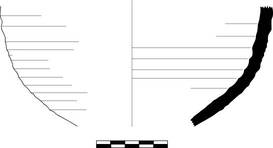
621. Late Roman Amphora 2 Neck and Handle
D20.0035:2. SC17-18. Neck and one handle preserved.
, pp. 217-219, the form is "Late Roman Amphora 2" at both Benghazi and Carthage; class 43.
622. Late Roman Amphora 2 Rim
P. H. .08. Est. diam. rim .125 (1/5 preserved). Th. .009.
K17.0696:18. Single rim sherd. Red core in thickest part of rim (2.5YR 5/6), fired brown under surface (7.5YR 6/6). Inclusions consist of occasional sub-angular dark bits, occasional lime and frequent other small varied bits. Surface is coated pale brown, near fabric.
, pp. 217-219, the form is "Late Roman Amphora 2" at both Benghazi and Carthage; class 43.
svg/K17.0696-18.jpg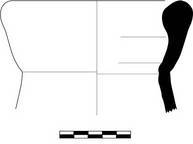
623. Late Roman Amphora 2 Rim (Fifth Centuery AD)
P. H. .036. Est. diam. rim .16 (1/8 preserved). Th. .006.
D20.0065:11. Single rim sherd. Orangish buff fabric (5YR 6/6 and 7/6) highly micaceous and limey with fine silver mica, bits of black inclusions.
, pp. 217-219, the form is "Late Roman Amphora 2" at both Benghazi and Carthage; class 43.
624. Late Roman Amphora 3 ("Micaceous Water Jar") Neck and Handles (Late 4th to 5th Century AD)
P. H. .091. Th. .004.
D20.0053:2. SC17-07. Neck and handles preserved, rim chipped. Micaceous brick red fabric (2.5YR 4/4) with lime inclusions.
, pp. 229-230, where the form is "Late Roman Amphora 10"; class 45 combines the one and two-handled versions; , plate 41.
625. Amphora. Benghazi Mid Roman Amphora 3
D20.0056:6. SC15-5. PH. 5.8; est. D.rim 7; Th. 0.5. Preserving 1/2 of rim with neck. Pinkish brown (2.5YR 4/6) micaceous fabric
626. Late Roman Amphora 3
D20.0053:16. PH. 8.8; Th. 0.5. Preserving complete profile and handles without rim. Brick red micaceous fabric (2.5YR 4/4) with lime inclusions.
627. Late Roman Amphora 3 Toe (475-525)
D20.0183:9. PH. 6.2; est. D.base 2.1; Th.0.6. Preserving complete base. Slightly irregular at the base. Micaceous brown fabric.
628. Late Roman Amphora 4 (5th Century AD)
P. H. 025. Est. diam. rim .09 (1/5 preserved). Th. .0085.
K17.0777:34. Slightly granular, brown (7.5YR 5/4) fabric; some quartz and other darker bits. Coated brown surface. Excess clay is adhered on rim. Short rim with distinct internal channel.
Pieri A2/B1. Cf. , pp. 219-223, where the form is "Late Roman Amphoras 3"; class 49.
K17.0777-34.jpg
629. Late Roman Amphora 4 (5th Century AD)
M18.0011:12. SC16-18. Single sherd. Short rim with distinct internal channel.
Pieri A2/B1.
630. Late Roman Amphora 4 (2nd quarter 5th to 500 AD)
P. H. .11. Est. diam. rim .135 (1/8 preserved). Th. .008.
K17.0736:4. SC17-35. Two joining sherds preserving rim and handle. Brown (5YR 5/6) fabric with large calcareous inclusions as well as frequent darker bits and small voids. The coated surfaces are slightly darker brown than the fabric. Rounded rim with slight inner channel. (Note: image does not show join with handle.)
The rim form matches type LRA 4B1, p. 104 and fig. 66. Cf. , pp. 219-223, where the form is "Late Roman Amphoras 3"; class 49.
svg/K17.0736-4.jpg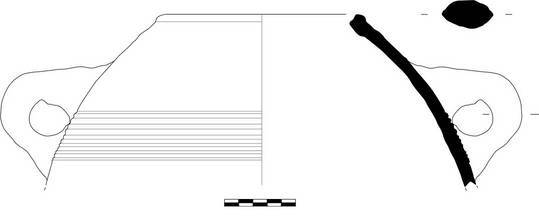
631. Late Roman Amphora 4 (2nd quarter 5th to 500 AD)
C/D20/21.0413:1. PH. 4.3; est. D.rim 10; Th. 0.8. Preserving 1/6 of rim. Slightly irregular rim. Brown fabric (5YR 5/4) with white bits, quartz. Rounded rim with no interior channel.
Pieri B1. Riley 1979, 223, n.354, fig.92.
svg/C-D20-21.0413-1.jpg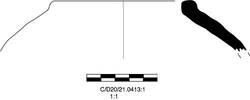
632. Late Roman Amphora 4 (Sixth Century)
C/D20/21.0407:1. Preserving 1/6 of rim. PH.6; est. D.rim 11; Th. 0.6. Access clay and ridging around the rim. Brown fabric (5YR 5/4) with white bits, quartz. High rim.
Pieri B2. Riley 1979, 222, n.353, fig.92.
svg/C-D20-21.0407-1.jpg
633. Late Roman Amphora 4 (Sixth Century)
C/D20/21.0394:5. PH. 6.8; est. D.rim 9; Th. 1. Preserving 1/4 of rim and wall. Patches of excess clay on the surface. Brown rough fabric. High rim.
Pieri B2.
svg/C-D20-21.0394-5.jpg
634. Late Roman Amphora 4 (“Gaza Amphora”) Handle and Upper Body
P. H. .21. Th. .009.
K17.0759:10. Single body sherd with handle attached. Compact, brown (5YR 5/6) fabric. Compact but with occasional lime chunks and other tiny black and light bits. Ridges on shoulder under handle, which suggests a fifth century date . The stance and diameter shown in the illustration are approximate.
Cf. , pp. 219-223, where the form is "Late Roman Amphoras 3"; class 49.
svg/K17.0759-10.jpg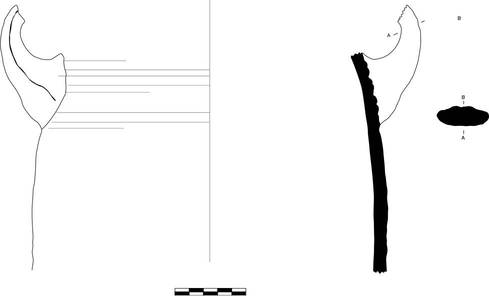
635. Late Roman Amphora 4 Handle
P. H. .095. Th. .004.
D20.0053:10. Single sherd, strap handle, slightly irregular wall. Brown rough fabric, chunks of lime on the surface.
Cf. , pp. 219-223, where the form is "Late Roman Amphoras 3"; class 49.
svg/D20.0053-10.jpg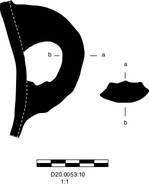
636. Late Roman Amphora 8 Rim
P. H. .048. Th. .005.
D20.0053:11. Two joining sherds. Thickened rim with triangular profile. Fabric is reddish brown (5YR 5/4) with frequent light and inclusions and frequent mica.
Cf. , p. 132-137.
637. Late Roman Amphora 8
C/D20/21.0418:2. PH.6.9; est. D.wall 22; Th. 0.8. Preserving shoulder, with trace of handle. Ribbed wall fragment. Brown fabric (5YR 5/4), fired red at core (10R 5/6) with lime, opaque quartz, red, black bits and fine silver mica in long flakes. Similar to P263.
Robinson 1959, 115, M328, pl.32. Check M273?
638. Late Roman Amphora 11
H17.1087:5. PH. 4.3; est. D.19 (wall to wall); Th.0.8. Deep wheel ridgings on shoulder, preserving 1/10 of wall. Pinkish red (10R 5/6) with shelly lime bits very fine silver mica.
639. North African Amphora Toe, Spatheion (350 to 600 AD)
P. H. .14. Est. diam. toe .032.
M18.0657:1. Single sherd preserving part of tapering toe to just above beginning of wall. Hard, slightly granular fabric is fired red (10R 5/8) with angular light inclusions. Surface of toe has streaky "salt slip". At the level of the wall, the start of vertical smoothing marks is visible. Extant interior is plain.
, p. 143.
M18.0657-1.jpg
640. Amphora, Regional
C/D20/21.0407:11. PH. 4.6.; est. D.rim 10; Th. 0.6. Preserving 1/6 of rim with handle. Everted rim with irregular grooves around the rim. Micaceous brown fabric (5YR 5/4) gritty very similar to cooking ware fabric.
641. Amphora stopper. Regional.
H17.0036.014. P0059. PH. 6.3; est.D. 8.0; Th. 0.5. Hollow interior, string cut base, lump of clay under the base. Micaceous gritty pinkish red (2.5YR 5/8) fabric with matte red slip overfired on top in black/brown.
642. Unguentarium (5th Century AD)
D20.0017:49. PH. 5.5; est.D. body 4; Th.0.6. Preserving ¼ of wall. Traces of handle. Wheel ridged lower body. Pale orange fabric (5YR 7/4) fired cream exterior.
643. Beaker? Regional
H17.0029:7. PH. 4.9; est. D.base 3.4; Th.0.5. Deep wheel ridgings exterior of wall. Pinkish buff fabric fired brown on surface, partially burned.
644. Unguentarium (5th Century AD)
H17.1087:10. PH. 3.2; est. D.base 3; Th.0.6. Preserving only base. Pale yellow porous fabric.
645. Unguentarium (Late Roman)
P. H. .061. Est. diam. base .028 (almost completely preserved preserved). Th. .01.
D20.0183:6. String cut base, slightly irregular. Hard, compact, pinkish buff fabric (2.5YR 6/6) surface one tone darker.
The category of small late Roman unguentaria, also known as ampullae, was defined by Hayes (, ). More recently, examples from Ephesos have been extensively discussed (, ).
646. Unguentarium (Late Roman)
P. H. .047. Est. diam. base .023 (completely preserved preserved). Th. .007.
D20.0035:1. Single sherd. Slightly irregular under base. Hard, compact, pinkish buff fabric (2.5YR 6/4 and 6/6) surface fired creamy.
647. Ampulla in Plain Fabric (Late Roman)
P. H. .058. Est. diam. .02.Th. .002.
I17.0647:10. Single sherd preserving lower half of vessel. Compact, soft light red (10R 6/8) fabric with frequent small lime inclusions and infrequent dark bits. Surface is plain.
svg/I17.0647-10.jpg
648. Thymiatherion (3rd Century AD)
H17.0778:3. PH.6.4; est. D. base 14.1; Th. 0.7. Pinkish buff hard fabric with white slip coat.
Slane 1986.
svg/H17.0778-3.jpg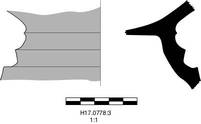
649. Bowl/basin, ledge rim. Regional (5th to 6th Century AD)
H17.1175:10. PH. 3.5; est. D.rim 34; Th. 0.8. Preserving 1/20 of rim. Wavy lines over the rim. Pinkish buff fabric hard fired, lime in section very fine silver mica. Same as 29:3.
650. Bowl, ledge rim. Local (5th to 6th Century AD)
H17.0029:3. PH. 3.5; est. D.rim 25; Th. 0.8. Incised wavy lines on rim, and on wall. Deep ridge on wall where the decoration was done. Preserving 1/20 of rim. Pinkish buff (2.5YR 6/6) hard fabric, core fired gray.
Similar to 1175:10.
651. Bowl/basin. Local (from LR deposit)
H17.0058:6. PH. 7.2; est. D.rim 23: Th. 0.8. Incurving thick rim. Wall slightly irregular a deep groove on wall. Pinkish buff micaceous fabric, hard fired. Form similar to 1175 series but fb is different.
652. Bowl. Regional (5th Century AD)
H17.0044:9. PH. 21; est. D.rim 21; Th. 0.7. Preserving 1/4 of rim and wall. Incurving heavy rim, deep groove exterior of rim. Pinkish buff (2.5YR 6/6) gritty fabric with slight blackening exterior.
653. Bowl/Basin. Regional (5th Century AD)
H17.0044:6. PH. 8.7; est. D.rim 24; Th. 0.7. Preserving 1/10 of rim. Deep smoothening marks on exterior wall. Light gray fabric (2.5YR N5) with fine silver mica.
654. Bowl. Local
H17.1175:8. PH.3.8; est.D. rim 20.4; Th.0.5. Incurving rim, heavy walls. Preserving 1/10 of rim. Pinkish buff fabric (2.5YR 6/6) fine lime silver mica granular surface.
655. Bowl. Local
H17.1175:9. PH. 5.6; est. D.rim 24.8; Th. 0.5. Incurving rim, heavy walls. Preserving 1/20 of rim. Orangish buff fabric (between 5YR 6/4 and 6/6) with fine lime, silver mica on granular surface.
656. Bowl, local
H17.1175:12. PH.5.5; est. D.rim 22; Th.0.8. Preserving 1/8 rim. Pinkish buff fabric (2.5YR 6/4) with self slip. (Two other in this deposit 1175:13, 1175:4, 1175:5)
657. Candarli L26b type base.
K18.0059:1. P.H. .02, est. D. base .09 (1/12 preserved), max. th. floor .011. Single base sherd. Light red (2.5YR 7/6) fabric with occasional small lime inclusions and varied tiny (reddish and dark) bits visible at 10x magnification. Surface darker red (10R 4/6).
658. Regional Gray on Red Thin Wall.
K18.0059:2. P.H. .018, est. D. rim .07 (1/12 preserved), min. th. wall .0025. Reddish brown (2.5YR 5/6) fabric with frequent small lime and angular quartz. Surface gray, upper part of exterior rim is slightly vitrified. The fabric color is more brown than usual but the vitrification may indicate some overfiring.
659. Candarli Hayes Form 2
K18.0060:1. P.H. .036, est. D. rim .24 (<1/20 preserved), min. th. .0055. Single rim sherd. Compact red (2.5YR 6/6) fabric with some few inclusions, though some tiny dark bits at 10x mag, small voids. Red (near 10R 4/8) slip better smoothed on interior.
660. Candarli Hayes Form 1
K18.0060:2. P.H. .016, est. D. rim ~.26 (<1/20 preserved), th. wall .0077. Single rim sherd. Compact red (2.5YR 6/6) fabric with occasional tiny dark bits. Surface darker red (10R 4/8), well-smoothed on inner wall and over rim, scratches on exterior.
661. Candarli Hayes Form 3
K18.0063:1. P.H. .022, D. base .047 (completely preserved), slightly irregular), min. th. wall .0046. Three joining sherds. Fine red (near 2.5YR 7/6) fabric with occasional calcareous inclusions and small voids. Surface darker red (near 10R 4/6 where darkest), well-smoothed on interior but with spiral tooling at center of floor. Slip is patchy on extant exterior.
662. Candarli Hayes Form 3
K18.0065:1. P.H. .028, est. D. rim .14 (<1/20 preserved). Single rim sherd. Light red (5YR 7/6) fabric with with only rare small rounded calcareous bits. Well-slipped surface darker red (10R 4/8), thick and smoothed on interior and over rim.
663. Candarli Loeschke Form 26a
K18.0074:1. P.H. .022, est. D. base .11 (1/12 preserved), th. floor .0026. Single base sherd. Fine red (10R 6/8) fabric with occasional angular white/calcareous inclusions and varied smaller darker bit. Slip is darker red (10R 5/8) and on all extant surfaces. Smoothed on interior, scratches on outer surfaces.
664. Regional Grey on Red Beaker.
K18.0074:2. P.H. .027, est. D. .09 (1/12 preserved), th. mid point rim .0027. Single rim sherd. Slightly granular brownish-red (2.5YR 5/6) fabric with frequent small white inclusions and other darker bits. Surface gray.
665. Regional Grey on Red Beaker
K18.0074:3. P.H. .017, est. D. rim .11, min. th. wall .0024. Single rim sherd. Slightly granular reddish-brown fabric (2.5YR 5/6) with frequent small white inclusions, and varied smaller bits. Surface gray.
666. Phocaean Baking Dish
K18.0074:4. P.H. .03, est. D. rim .28 (<1/24 preserved), th. .0067. Single rim sherd. Coarse brown (5YR 5/6) fabric with large calcareous chunks and other varied bits. Surface gray.
667. Regional Gray on Red Thin Wall Beaker
K18.0074:5. P.H. .026, est. D. base .04 (1/3 preserved), min th. wall .0024. Single base sherd. Reddish-brown (2.5YR 6/8) fabric with frequent tiny white inclusions. Silvery mica on surface. Upper band fired gray.
668. Candarli Loeschke Form 19
K18.0074:6. P.H. .051, est. D. rim .15 (1/4/ preserved), min. th. wall .0053. Single rim sherd. Fine pale red (5YR 7/6) fabric with varied light small bits (some calcareous, others plain sub-angular white) and frequent very small voids. Surface darker red (10R 5/8).
669. Ledge rim bowl, regional
K18.0078:1. P.H. .045, est. D. rim .41 (1/10 preserved), th. wall .0085. Single rim sherd. Compact brown (near 5YR 6/6) fabric with occasional larger calcareous and fewer darker, small inclusions.
670. Bowl with downturned rim, regional
K18.0078:2. P.H. .041, est. D. rim .42 (1/10 preserved), min. th. wall .0041. Single rim sherd. Compact brown (5YR 6/6) fabric with frequent varied inclusions, all small. Surface thinly coated pale with reddish-brown streaks on interior.
671. Candarli Loeschke Form 9
K18.0079:1. P.H. .022, est. D. rim .17 (1/10 preserved), min. th. wall .0031. Single rim sherd. Fine pale red (2.5Yr 7/6) fabric with only tiny inclusions and some small voids. Surface thick and very well polished (10R 4.8).
672. Candarli Loeschke Form 26a.
K18.0079:2. P.H. .027, est. D. rim .23 (1/8 preserved), min. th. wall .0053. Two joining rim sherds. Fine pale red (2.5YR 7/6) fabric with few small calcerous rounded and other white subangular inclusions. Surface darker red (near 10R 4/8), better smoothed on interior, thinner on exterior.
673. Candarli Loeschke Form 19.
K18.0079:3. P.H. .038, est. D. rim .10, min th. wall .0054. Single rim sherd. Pale red (5YR 7/6) fabric with tiny calcareous inclusions and tiny voids. Surface darker red (near 10R 4/8).
674. Candarli Loeschke Form 26a
K18.0079:4. P.H. .017, est. D. .18 (1/20 preserved), min th. wall .0056. Single rim sherd. Fine red (2.5YR 6/6) fabric with tiny white inclusions (some obviously calcareous). Surface darker red (near 10R 4/8).













































